Adventurous Kate contains affiliate links. If you make a purchase through these links, I will earn a commission at no extra cost to you. Thanks!
If you’ve never visited cenotes in Mexico, you have a lot of fun ahead of you! These freshwater sinkholes are the best swimming spots on the planet — and you can only find them in one place.
There are more than 6,000 cenotes in Mexico, most of them located on the Yucatan Peninsula of Mexico. You’ll find dozens of cenotes you can visit near tourism hotspots like Tulum, Playa del Carmen, Valladolíd, and Mérida.
Whether you’re planning to hit up the party scene in Tulum, lie on the beach in Cancun, do a big Yucatan road trip, or put down roots in Mérida for a few months, as I did two years ago, you should allot part of your trip to visiting cenotes!
But what cenotes are actually worth it? What are the best cenotes in Mexico?
I’m glad you asked. While I’ve been to around 20 or so of the best Mexico cenotes, there are way more than those. I asked my travel blogging colleagues to share their favorite cenotes, and they eagerly obliged.
Here we have shared more than 50 of the best cenotes in Mexico, where to find them, what they’re good for, when they’re open, and more!
Bookmark this page and send it to your friends, because you will be referencing it OFTEN when planning your trip to Mexico.
Table of Contents
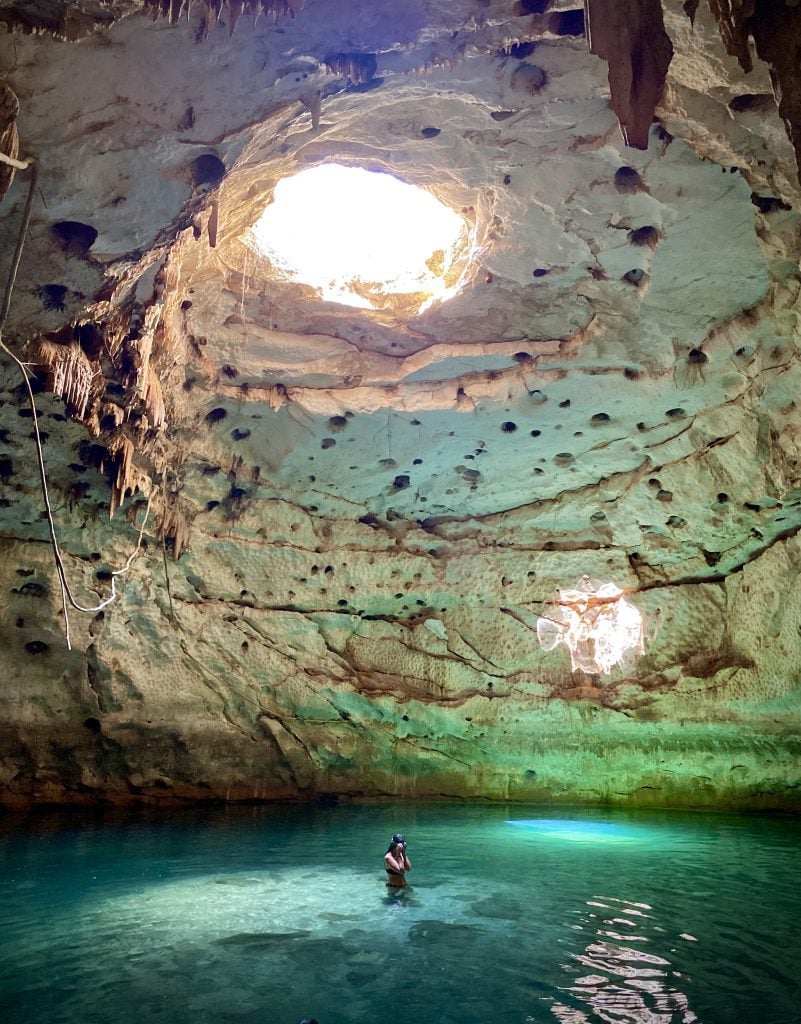
What is a cenote?
A cenote is a freshwater sinkhole — an underground chamber that contains permanent water. Open and semi-open cenotes are created when the limestone bedrock above collapses in.
Additionally, cenotes are connected to underground rivers and subterranean water systems. The water is usually incredibly clear, as it’s been filtering through the ground for quite some time.
Cenotes are found throughout the Yucatan Peninsula of Mexico (though there are occasional cenotes in other parts of Mexico like Chiapas).
Some scientists believe that cenotes were formed by the same meteor that killed the dinosaurs, wiping out much of the plant and animal life on the planet as a result. This meteor impact site is now Chicxulub crater, and cenotes fan out in circles from here.
Mayans and Cenotes
Cenotes were sacred places to the Ancient Mayans. Not only were they a much-need source of fresh water in a stiflingly hot climate, but in ancient times, Mayans believed that cenotes were the entrance to the underworld. The Mayan word for cenote is d’zonot, or ts’onot, meaning well.
Today archaeologists believe that the Maya carried out human sacrifices at the Sacred Cenote at Chichen Itza. Human blood was seen as nourishment for the gods and high-status prisoners of war were often the ones sacrificed.
Offerings were also made to Chaac, the god of rain, to prevent drought.
VERY important tip: Keep in mind that Mayans still exist today! Their civilization didn’t die out. Mayans live among us. Many Mexicans in the Yucatán Peninsula grow up speaking dialects of Yucatec Maya as their first language.
Types of Cenotes
As you’ll see in this post, there are SO many different kinds of cenotes!
Open cenotes are cenotes whose walls have collapsed in on them, and they are exposed to the sky. Some are surrounded by vegetation and may appear more like lakes.
Semi-open cenotes have parts that are open to the sky and parts that are closed.
Closed cenotes, or cave cenotes, are cenotes that are completely covered.
Underground cenotes, or ancient cenotes, are underground cenotes that have yet to be discovered.
Beyond that, there are two main kinds of cenote experiences.
Hacienda cenotes have facilities built around the cenote — often a pool, restaurant, and outdoor lounge areas. Some hacienda cenotes are full-on resorts, with accommodation and activities like horseback riding.
Some hacienda cenotes are Cenote Oxman outside Valladolid and Cenotes Santa Barbara in Homún, near Mérida.
Wild cenotes have few facilities — sometimes just a single toilet and a solitary employee collecting admission fees.
Some wild cenotes are Cenote Noh Mozon and Nah Yah Cenote, both in Pixyá near Mérida.
What do you do in cenotes?
It might seem like a dumb question, but what do people do in cenotes? Not dumb at all!
You can swim! You can snorkel! You can fly out on rope swings and jump in! In some of them, you can even dive. (Hell, in some of them, you can ONLY dive.)
Cenotes are the best place in the world to cool off. Which is one reason why they pair so nicely with a trip to Mayan ruins! The Yucatán is a very hot place, and you’ll be ready for a dip after a few hours in the sun.
Map of Cenotes in Mexico
Above you can see a map of the best cenotes in the Yucatán peninsula of Mexico. You can also see the full Google map here.
You’re probably thinking of Cenote Suytun, which is near the city of Valladolid.
There are so many excellent cenotes near Tulum — don’t miss Cenote Dos Ojos or the Gran Cenote!
There are dozens of good cenotes near Playa del Carmen. We love the Cenote Azul and Cenote Elvira!
Cenote Ik-Kil is a popular choice close to Chichen Itza, but I prefer Cenote Oxman, a bit of a further drive but worth it.
Cenote is pronounced seh-NO-tay.
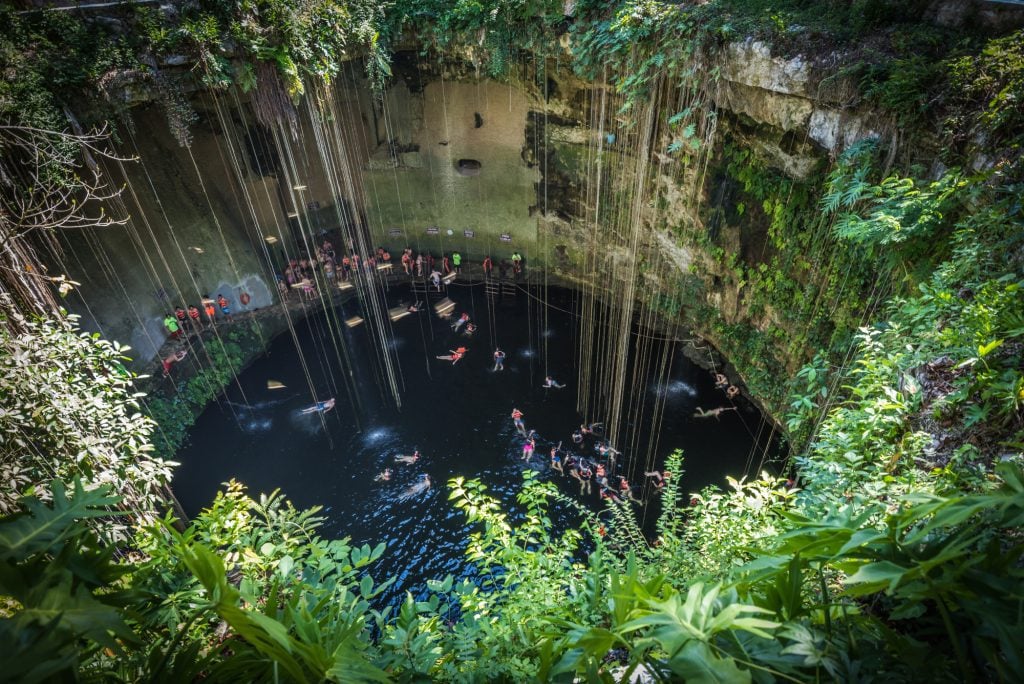
8 Best Cenotes in Mexico
So we know there are a lot of cenotes in Mexico — but which ones are the best? Everyone has difference preferences, but here are the Mexican cenotes I think are extraordinary:
Cenote Zaci in Valladolíd — This cenote is enormous and brilliantly situated, right in the middle of the city, and even has a waterfall flowing into it from above! It’s also one of the deepest cenotes in Mexico.
Cenote Dos Ojos near Tulum — This cenote is very good for both snorkeling and scuba diving, and consists of two cenotes joined by an underwater tunnel.
Cenotes Santa Barbara in Homún, near Mérida — If you want a resort-like experience with several cenotes on site, this one will give you the local Mexican experience (more so than the ones on the Riviera Maya, which primarily cater to foreign tourists).
Cenote Noh Mozon near Mérida — The most spectacular wild cenote. Tough to get to on an extremely bumpy road, and home to the bluest water I’ve ever seen.
Cenote Oxman near Valladolíd — Just a solid, excellent cenote much less crowded than the big names near Chichén Itza, with a local crowd and great facilities.
Gran Cenote near Tulum — This cenote is extremely popular and mostly filled with foreign tourists, but it has the bonus of turtles swimming around. A fun choice for snorkeling.
Cenote Azul near Playa del Carmen — This cenote is open with a phenomenally blue color that is great in photos.
Cenote El Pit near Tulum — If you’re looking to dive in a cenote, El Pit is a huge achievement. It’s dark, it’s spooky, and you’ll never forget it.
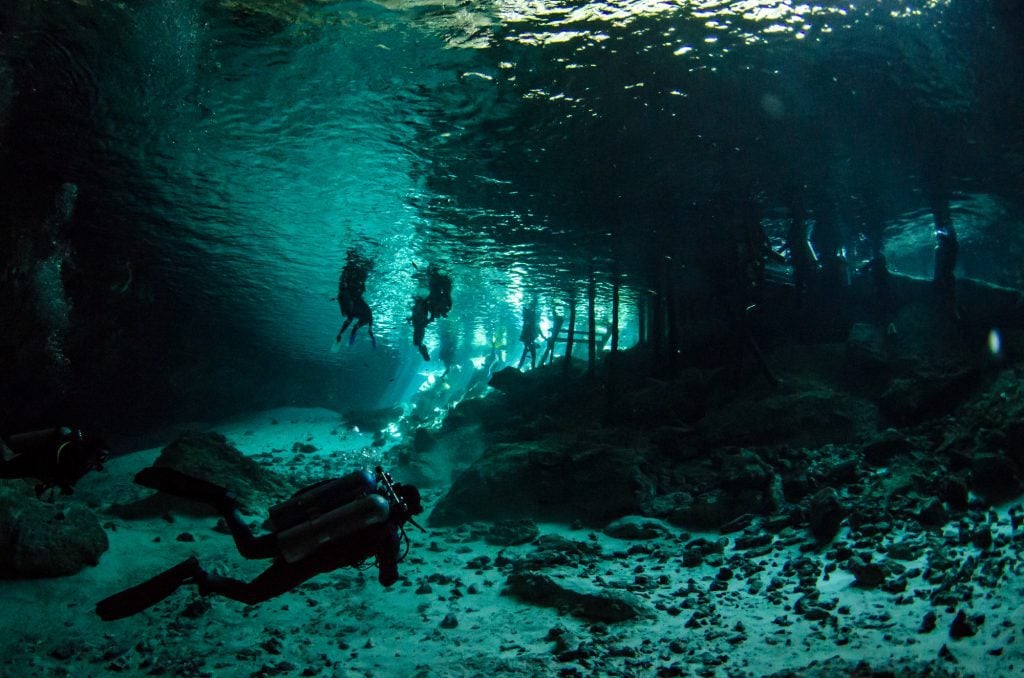
Cenotes Travel Tips
Go early. You almost always get a better experience first thing in the morning when cenotes are least crowded.
Bring cash — small bills and coins if you can. Most cenotes only take cash as payment and can’t break larger bills. Cash is also useful for buying street food and public bathroom visits.
Go for a mix of hacienda cenotes and wild cenotes. There is a huge difference between a cenote with a full restaurant and pool and a cenote that is a hole in the ground — both are great and worth visiting!
Be careful with your drone. Some people like to bring drones to photograph cenotes from above, but not all cenotes allow them to be flown nearby. Be extremely cautious of people’s safety.
Keep in mind the time zone. The regions of Quintana Roo (Cancun, Playa del Carmen, Tulum) and Yucatán (Valladolíd, Chichén Itzá, Mérida) are in two different time zones. Don’t miss your bus home!
Rent a car if you want to explore independently. The Yucatán is a safe and easy region to drive in Mexico, and driving will allow you to visit cenotes at your own pace. Visit 10 in a day if you want to!
Read More:
The Ultimate Two-Week Yucatán Road Trip Itinerary in Mexico
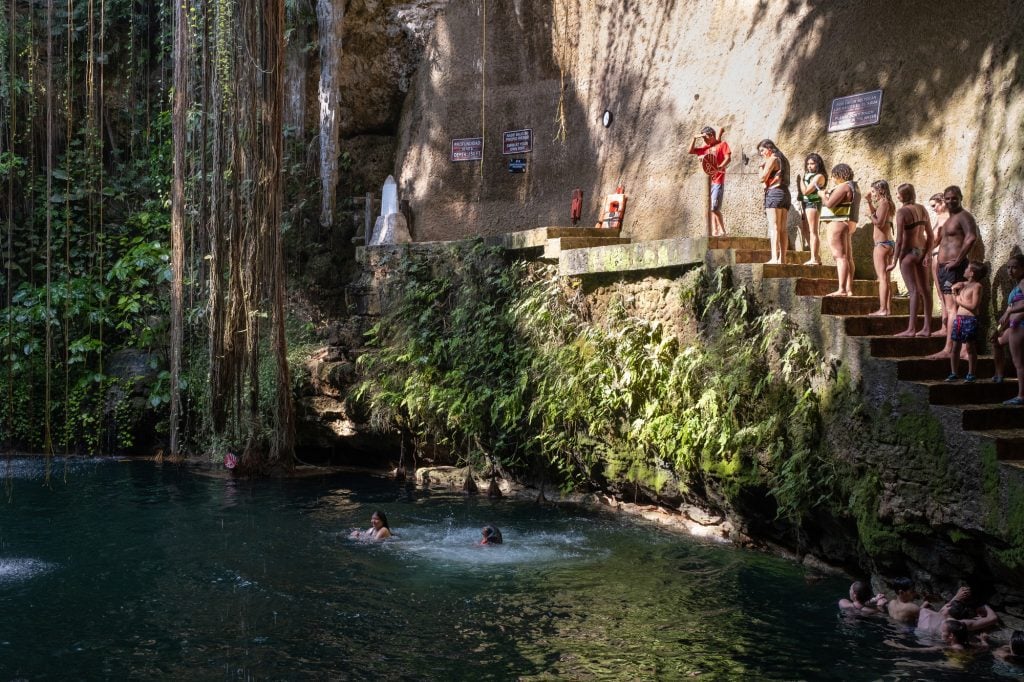
Cenotes Tours in Mexico
One of the easiest ways to visit cenotes in Mexico is to book a cenote tour! This is an especially good option if you’re not comfortable driving in Mexico.
It’s also a good way to meet fellow travelers if you’re traveling solo in Mexico.
Here I’ve picked out some high quality cenote tours departing from four popular cities.
Cenotes Tours in Tulum
This budget Tulum cenote tour takes you to three cenotes just north of Tulum for a low price.
This mindfulness cenote experience has you practicing mindfulness and meditation in a gorgeous cenote. How very Tulum!
This Tulum snorkeling and cenote tour combines snorkeling the reef with exploring a cenote.
This Tulum Instagrammable cenotes tour actually takes you to two of the best cenotes near Valladolíd: Cenote Suytun and Cenote Oxman!
Cenotes Tours in Playa del Carmen
This classic “do it all in a day” cenote tour from Playa del Carmen includes Chichen Itza, a cenote, a buffet lunch, and the city of Valladolid.
This unusual cenote tour in Playa del Carmen includes swimming with turtles!
This morning tour of cenotes near Playa del Carmen gets you there while they are empty and gorgeous!
Cenotes Tours in Valladolíd
How about a cenote tour by bike? This Valladolíd bike tour includes stops at three different cenotes!
This tour gives you access to the Mayan ceremonyc in a cenote near Valladolid.
Cenotes Tours in Mérida
This Mérida cenote tour takes you to two hard-to-reach wild cenotes. A good one to do as a tour.
This Mérida tour takes you to the Santa Barbara Cenotes — and possibly a few more if you have the time.
This experience takes you to two cenotes near Mérida, plus a hacienda and lunch with a Mayan family.
Read More: Is Mexico Safe for Solo Female Travelers?
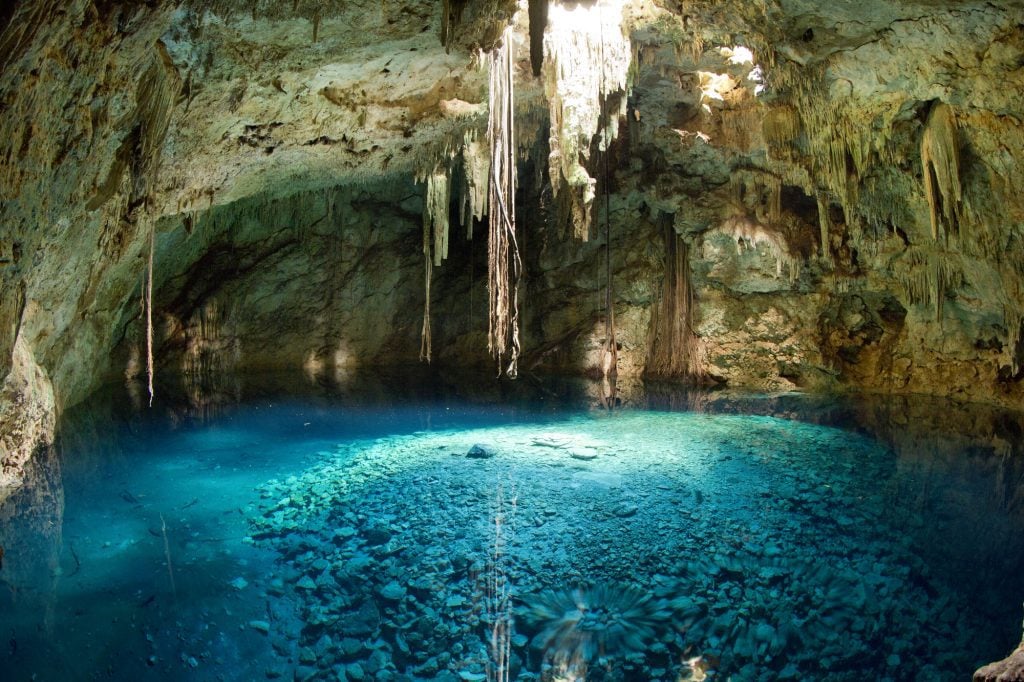
What to Bring to Cenotes
Reef Safe Sunscreen or Biodegradable Sunscreen — Non-negotiable. Cenotes are a delicate environment and conventional sunscreen can harm them. Get used to using this throughout Mexico.
Sports Sandals — These are essential for any Mexico trip: great for climbing ruins, light hiking, walking on uneven sidewalks in cities, and climbing into gnarly wild cenotes while keeping your feet cool. I’ve rocked my Teva Tirra Sandals for more than a decade.
Dry Bag — Essential for keeping your electronics dry. Get a big one you can fit your whole purse or small backpack in. Mine saved me when I was shipwrecked!
Quick-Dry Towel — Pretty self-explanatory.
Insect Repellant — You’ll need it in the Yucatán.
Water Shoes or Reef Shoes (Optional) — You might appreciate them for shallow cenotes where you touch the ground and the cenotes with climbing walls.
Waterproof Phone Bag (Optional) — If you want to take your phone into the cenote with you, without having to lug a larger dry bag.
Snorkeling Gear (Optional) — Many cenotes offer snorkel gear rentals, but smaller remote cenotes do not. Worth the investment if you plan on doing a lot of snorkeling in Mexico (or the idea of sharing a snorkel skeeves you out).
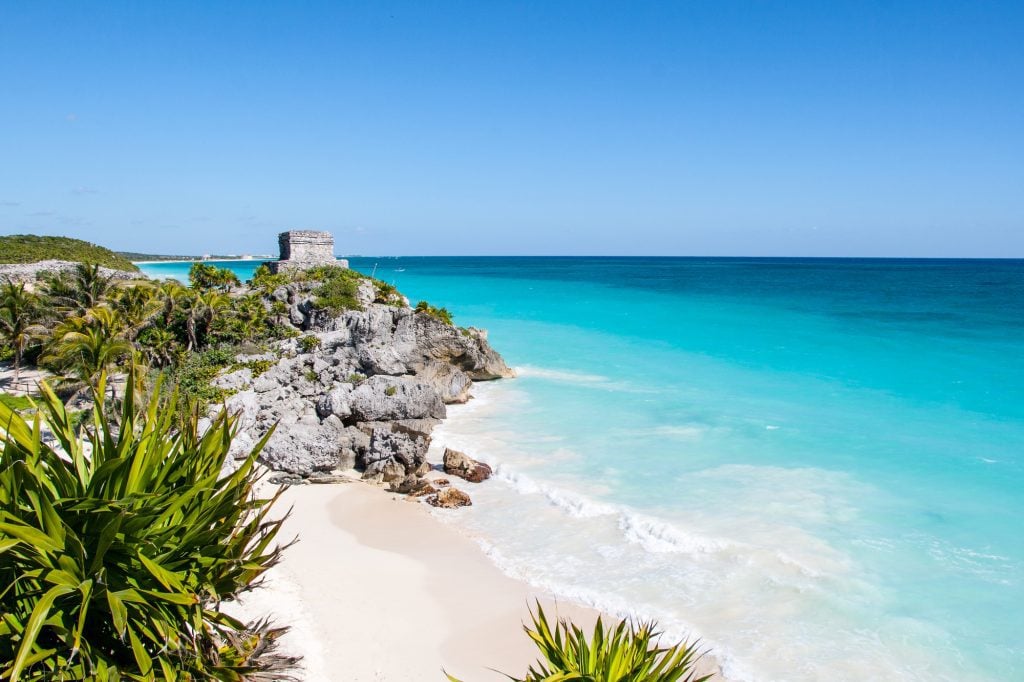
Cenotes Near Tulum
Ah, Tulum — easily one of Mexico’s best beach resorts, famous for its Mayan ruins, white sand beaches, and enormous parties. Tulum has become a major destination on the Mayan Riviera over the last decade or so.
Some of the best cenotes in Mexico are close to Tulum — including famous cenotes like the Gran Cenote, where you can swim with tiny turtles and Cenote Dos Ojos, which is equally fun for snorkelers and divers.
And if you want to get a bit off the beaten path, check out Laguna Kaan Luum or Cenote Taak Bi Ha.
Tulum also makes a good base for cenotes trips further afield. See some top recommendations in the Cenotes Tours in Tulum section, and see some more below.
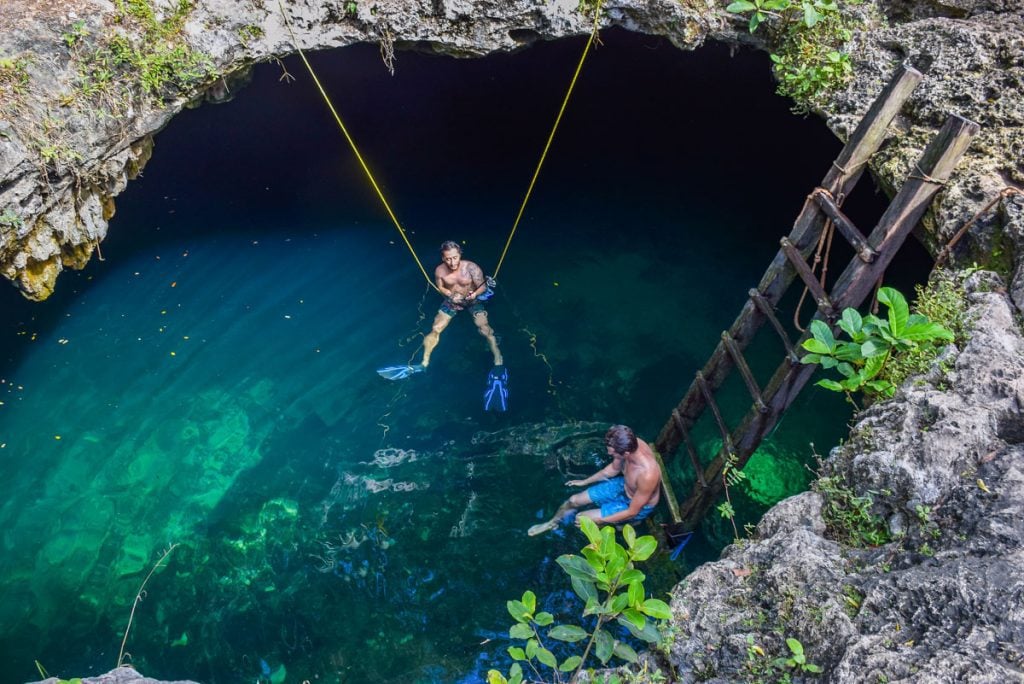
Cenote Calavera
Submitted by Daniel Carracciolo of Destinationless Travel
Cenote Calavera is located only a short 5-minute drive from the bustling tourist town of Tulum. The cenote got its name from its unique shape, which, when looked at from above, resembles a skull — Calavera is the word for skull in Spanish.
Calavera is a really cool cenote to visit, especially among divers. Below the small opening in the limestone rock is a vast network of caves perfect for beginner cave divers. Although the experience can be scary, Calavera is still a rather open cave, and it’s a great introduction to cave diving.
Those looking to cool off under the hot Mexican sun also love visiting Calavera, and it’s become somewhat famous with Instagrammers. Jump from above into the pool below your feet or pin drop through one of the cave’s narrow eyes. There is a ladder to access the cenote, and it’s a unique place to swim.
The best part about Calavera is how close it is located to Tulum. You can get a taxi to the cenote for only a few dollars.
Cenote Calavera is a must-visit and one of the best things to do in Mexico.
Address: Carretera Tulum Coba Km 1.7, 77796 Tulum, Q.R., Mexico
How to Get There: Driving or take a taxi is best.
Hours: Daily, 9:00 AM-5:00 PM
Admission: 100 pesos ($5 USD)

Cenote Car Wash
Submitted by Sarah Hughes of Live, Dream, Discover
The official name of this lovely open cenote is Aktun Ha, meaning water cave. The story goes that it was nicknamed Car Wash Cenote because people used to stop and wash their cars here. Its convenient location, just off the main road from Tulum to Coba, gives credence to this tale.
At first glance, Cenote Car Wash may not wow you as some of the more impressive cave cenotes do. Open-air cenotes are beautiful and great for swimming but they often look more like a pond than a magical grotto. However, go a little deeper and Car Wash is sure to become a favorite excursion from Tulum.
Climb down the old wooden steps, or jump off the higher platform, and be refreshed by the clear, cool waters. Then, dip your head under and open your eyes to see an underwater garden worthy of a Monet painting. You may even see a diver or two appear out of nowhere as they emerge from the underwater caves below.
We’ve visited Cenote Carwash several times and have a unique story from each visit. Once, we witnessed an underwater photography session of a girl submerged in a flowing white dress. The flowery background was stunning.
Another time we were asked if we wanted to see a water lizard which turned out to be a small crocodile! Don’t worry, he’s been there for years and is totally harmless. As this is one of our favorite cenotes near Tulum, there are sure to be more stories to tell soon.
Location: Calle Carretera Federal 109
How to get there: Car, taxi or colectivo, all 15 minutes from Tulum
Hours: Daily, 8:00 AM-6:00 PM
Admission: 50 pesos ($2.50 USD) for swimming, 120 Pesos ($6) for diving
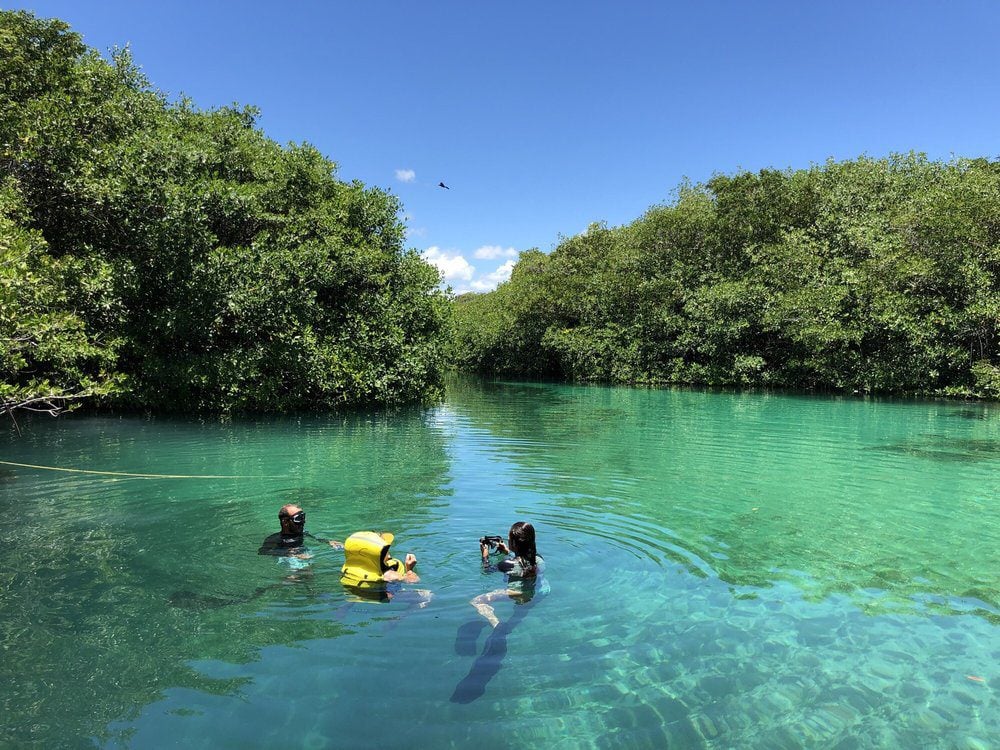
Casa Cenote
Submitted by Trijit Mallick of Budget Travel Buff
Located just 8 kilometers north of Tulum, Casa Cenote is an exceptionally beautiful open-air cenote with crystal clear water, mangroves, and different types of fish, birds, and plants. Casa Cenote is a perfect place for you if you are looking for a fantastic diving and snorkeling experience near Tulum.
The emerald-green crystal waters, the mangrove forest, the natural caves hidden in the jungle, and the unique flora and fauna will leave you with special memories.
Casa Cenote is a quiet and amazing place where you can relax and chill by the water with no crowds as such. Snorkeling is the most popular activity in Casa Cenote. You can swim in the shallow part of the water where the maximum depth is 25 feet. Don’t go beyond the warning sign without a guide as crocodiles may present there.
You will be amazed by the clarity, light, and beautiful color of the water. You will see many small fishes like guppies, platys, and mollies that hide in the roots of the mangroves. You can even spot some birds like herons, pelicans, and some reptiles if you are lucky. Kayaks, paddleboards are also available for rent. Lockers are available.
You can take the Colectivo from the main avenue in Tulum and it will take around 15 minutes. It is comfortable and cheap but the only downside is that Colectivo will drop you on the side of the highway. You have to walk along a dirt road for another 20 minutes.
Address: Carr. Tulum-Puerto Juarez Fracc. Tankah Caribe Lt. 32 Mza. 3, Tulum, Mexico.
How to Get There: Take a 15-minute colectivo ride from Tulum, then walk 20 minutes along a dirt road.
Hours: Daily, 9:00 AM-5:00 PM
Admission: 120 pesos ($6 USD)
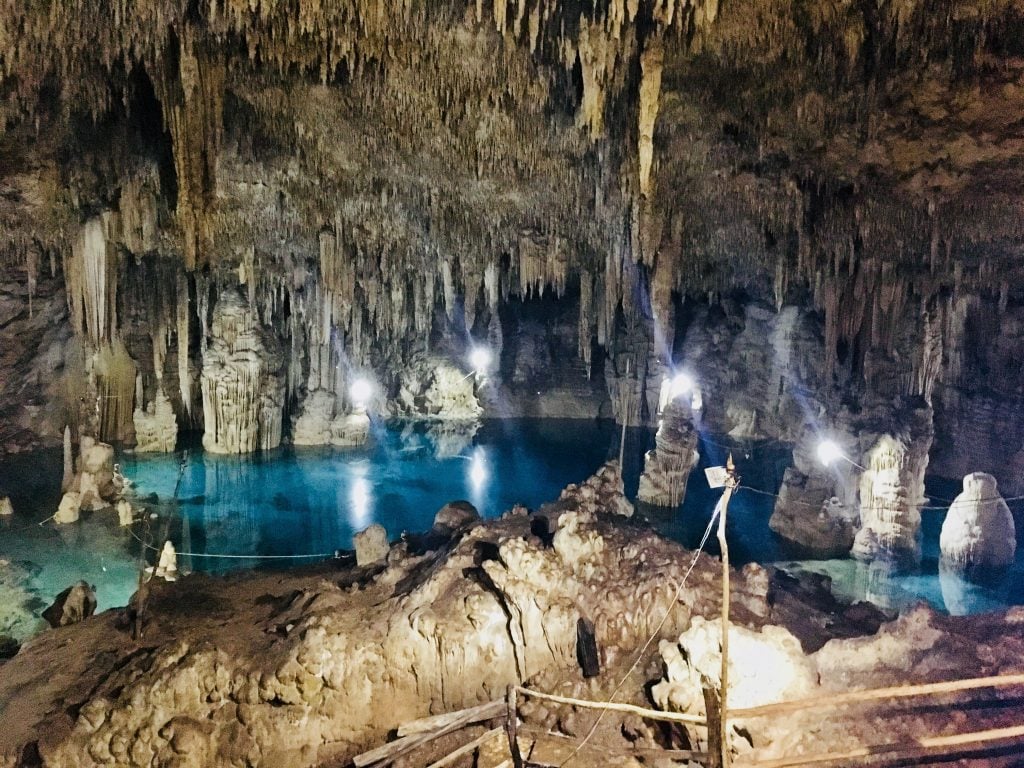
Choo Ha Cenote
Submitted by Tanya Korteling from Can Travel Will Travel
Choo Ha Cenote, located close to the Mayan ruins of Tulum and Coba, is a deep underground cenote full of stalactites and stalagmites. What makes this cenote even more special is that it’s less touristy than most of the other cenotes in the area.
To access this cenote, you have to climb down a slippery wooden staircase and then some limestone steps. Suddenly, the lights reveal a magical scene of glittering stalagmites and stalactites reflecting in the blue, crystal clear water.
Be prepared for a shock from the freezing water and make sure you take a snorkel to explore below the surface. Most people combine a visit to Choo Ha Cenote with a visit to the Mayan ruins at Coba or Tulum.
You can visit the cenote independently; it’s also possible to take a small group tour such as the fantastic Mayan Experience Cenote Tour we did from Puerto Morelos.
As for facilities, there are simple changing rooms, lockers, toilets and a shower.
Address: Unmarked road, Chanchen 1, Cobá, Q.R., Mexico
How to Get There: Driving is best; you can also take a colectivo from Tulum to Coba and get a taxi from there. Just 5 km from Coba.
Hours: Daily, 8:00 AM-6:00 PM
Admission: 100 pesos ($5 USD)
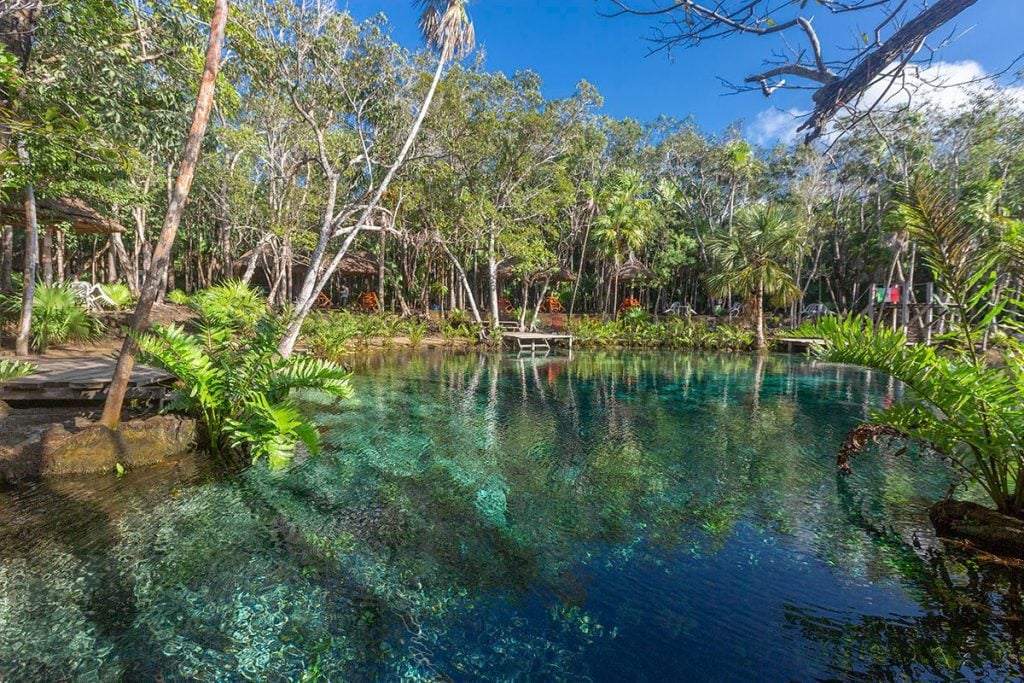
Cenote Corazón del Paraiso
Submitted by Isabella of Let’s Travel to Mexico
Located only 10 minutes from Tulum town, on the way to Felipe Carrillo puerto, cenote Corazon del Paraiso is a spectacular open cenote shaped like a heart — hence, the name Corazón, meaning heart in Spanish.
It’s indeed one of the most beautiful open cenotes especially when you find spectacular white clouds reflecting in the crystal clear water. Together with the surrounding lush tropical vegetation, it creates a surreal setting, ideal for spectacular pictures, if you are into photography.
Around the cenote, you will find spacious platforms and a seating area where you can relax and enjoy the peace and tranquillity of the place.
However, you should bring your own snorkel and mask to check out what’s hiding beneath the surface. For the more adventurous, cave diving is also available, but you will need to book with a dive center.
It’s always recommended to enter the cenote without any lotion or repellent on, and showers and bathrooms are available at the entrance. You can also rent life jackets and snorkel gear.
The cenote and the premises are very clean and well kept; please make sure you leave them as they are.
Address: Just west of Tulum along the main highway, Quintana Roo, Mexico
How to Get There: Drive or take a taxi or colectivo.
Hours: Daily, 9:00 AM-5:00 PM
Admission: 150 pesos ($7.50), or 100 pesos ($5 USD) for locals
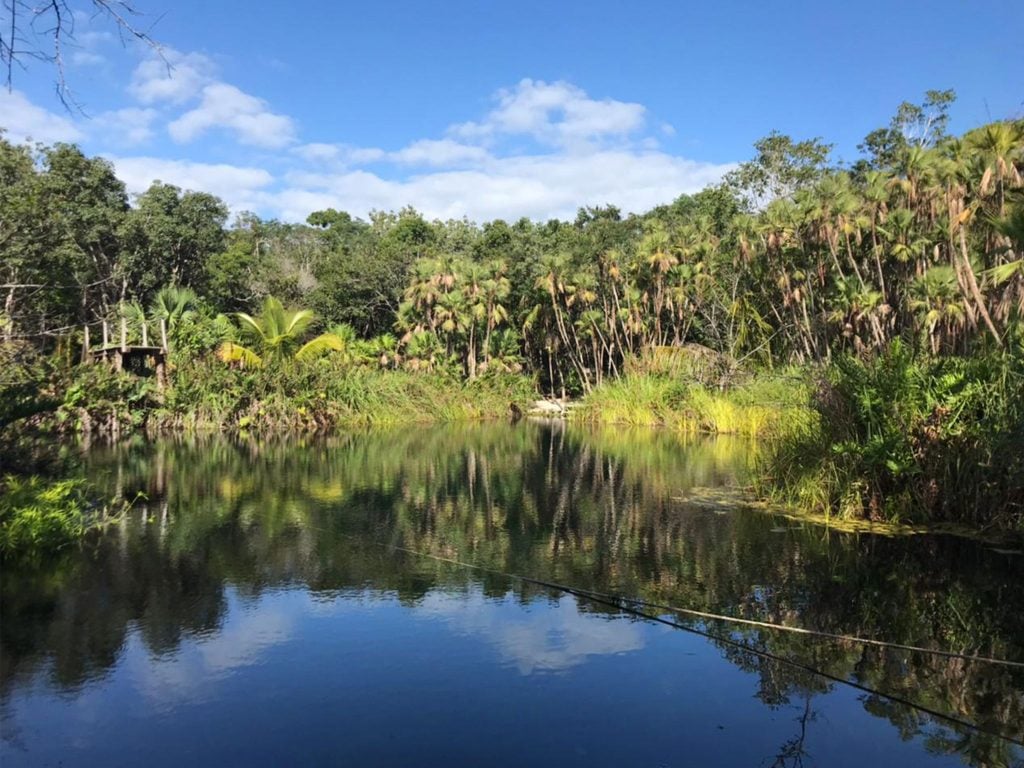
Cenote Cristal (Cenote Naharon)
Submitted by Daniel James
When in Tulum, one of the many cenotes that you can’t afford to miss is Cenote Cristal, also known as Cenote Naharon. Located a five-minute drive from Tulum Pueblo, this open cenote is a great choice if you want to go swimming and take advantage of its crystal clear waters.
The great thing about Cenote Cristal is that it allows you to see deep within the water without having to use any snorkeling or diving equipment. Also, you can enjoy the lofty palm trees and jungle-like flora that surround the area with fewer tourists than other more well-known cenotes. Not to mention, if you’re feeling brave, you can jump in the water from the wooden ledge that stands around 3.5 meters high.
Visiting Cenotes is one of many things to do in the Rivera Maya, and this cenote is as family-friendly as it gets with a fully guided rope sitting one foot above the water’s surface, allowing younger swimmers to pull themselves back to the edge of the pool with ease. It’s a good idea to arrive early to avoid any disappointment, as there is usually a cut-off point during the late afternoon.
Address: On an unnamed road five minutes west of Tulum Pueblo, Quintana Roo.
How to Get There: Drive or take a colectivo from Tulum.
Hours: Daily, 9:00 AM-5:00 PM
Admission: 150 pesos ($7.50 USD)
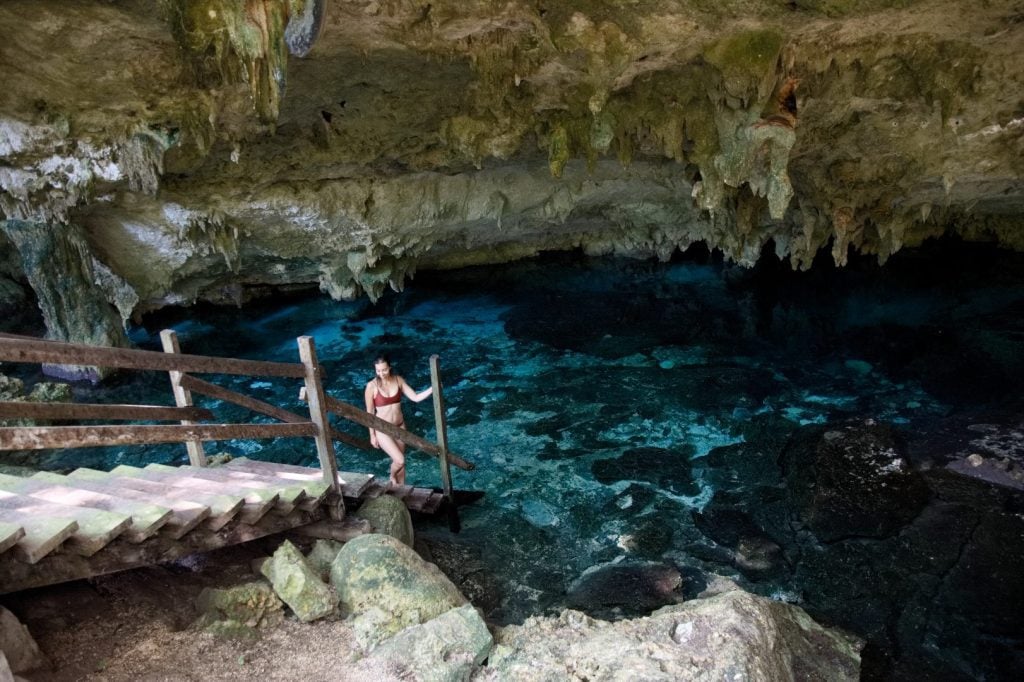
Cenote Dos Ojos
Submitted by Stefania Guglielmi of EverySteph
If you’ve seen pictures of cenotes on Instagram (and who hasn’t?!), chances are you’ve seen a picture of Cenote Dos Ojos. This cenote located between Tulum and Playa del Carmen is in fact one of the most famous of all — if not THE most famous one.
This sinkhole’s name means literally “two eyes,” and in fact, it’s a system of two different cenotes connected via an underground passageway. Both cenotes are stunning – one features the most beautiful bluest water you’ll see in a cenote, while the other ojo is darker and boasts some incredible stalagmite formations (and a colony of bats!).
Most people tend to stop in the first one, so it’s always quite crowded – however, arrive early in the morning (before the cenote opens) so that you can enjoy the place without the crowds. If you’re lucky, you might even have it all to yourself as I did!
At Cenote Dos Ojos, you’ll find all sorts of facilities including bathrooms and changing rooms, lockers for your belongings, a covered picnic area, lifeguards on duty, and even a massage service. You’ll be also able to rent lifejackets and snorkeling gear.
Address: Cenote Jaguar Rd, 77780 Tulum, Quintana Roo, Mexico
How to Get There: Drive or take a taxi, just 20 minutes from Tulum.
Hours: Daily, 9:00 AM-5:00 PM
Admission: 350 pesos ($17 USD)
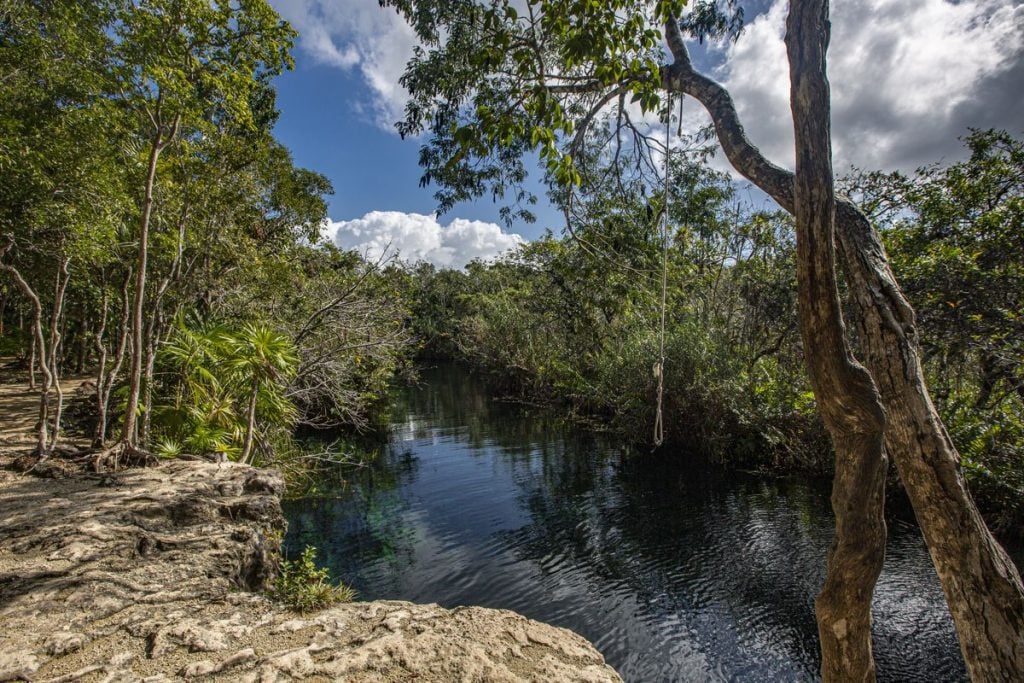
Cenote Escondido
Submitted by Isabella of Boundless Roads
Located at only 3 km from downtown Tulum, Cenote Escondido is a cute small cenote that you can visit together with the Cenote Cristal, the more popular cenote on the opposite side of the road. In fact, they are mainly known as Cenote Cristal y Escondido and you must pay your entry fee to both at the Cenote Cristal.
Escondido means hidden in Spanish, and that is more than appropriate as it’s quite a trip to get there. So mke sure you go either by bike or car. If you get there by minivan or taxi it’s going to get complicated.
Cenote Escondido is a small cenote wrapped in lush tropical vegetation and the sound of nature. It’s not very big and it has a long and narrow shape. This is different from other open cenotes, which are usually round.
The water is crystal clear and you can either swim, snorkel or even dive. Diving experiences must be booked in advance with a dive shop.
Also, you can play Tarzan! There are cords hanging from the trees on which you can swing and jump into the water. Or you can just sit on the benches and watch the adventurous ones doing it.
Cenote Escondido is good for swimming and relaxing while soaking up the nature vibes.
Address: Mayan Blue Rd, 77765 Q.R., Mexico
How to Get There: Drive or bike from Tulum.
Hours: Daily, 9:00 AM-5:00 PM
Admission: 150 pesos ($7.50 USD)
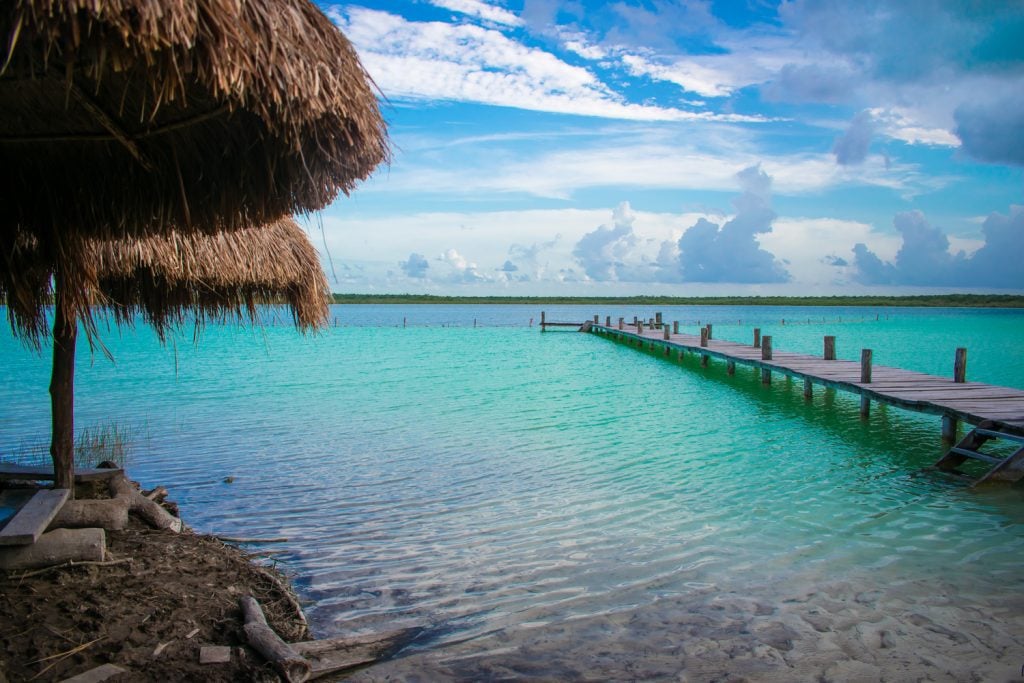
Laguna Kaan Luum
Submitted by Sean Lau of Living Out Lau
There are plenty of cenotes in Mexico, but none is arguably as good for swimming and sunbathing as Laguna Kaan Luum, or Kaan Luum Lake. Though commonly referred to as a lake, its water source comes from the center where it connects with an underground river source. Technically speaking, it’s a type of open-air cenote.
Because of its varying depths, there are many different shades of blue to the lake. In fact, the beauty of it compares to the best beaches in Mexico, especially with the lush vegetation that surrounds Laguna Kaan Luum. Recently, the Kaan Luum added a swing that hovers over the water, making it the perfect Instagram photo opportunity.
When it comes to amenities, Laguna Kaan Luum features clean changing rooms for guests. At the lakeside, guests will find palapas where they can sit under and enjoy the Mexican sun. There are also small snack shops and locals selling coconuts on a good day.
If you want to visit Laguna Kaan Luum, you will want to find a place to stay in Tulum. That is because Laguna Kaan Luum is only about 11 kilometers away from Tulum center, so travelers can either take a taxi for 10 minutes or bike for 30. Keep in mind that if you stay by Tulum Beach, your commute will be longer.
Address: Unmarked road, 10 minutes west of Tulum
How to Get There: Drive or take a taxi (10 minutes from Tulum Pueblo), or bike (30 minutes from Tulum Pueblo)
Hours: Daily, 9:00 AM-4:00 PM
Admission: 300 pesos ($15 USD)
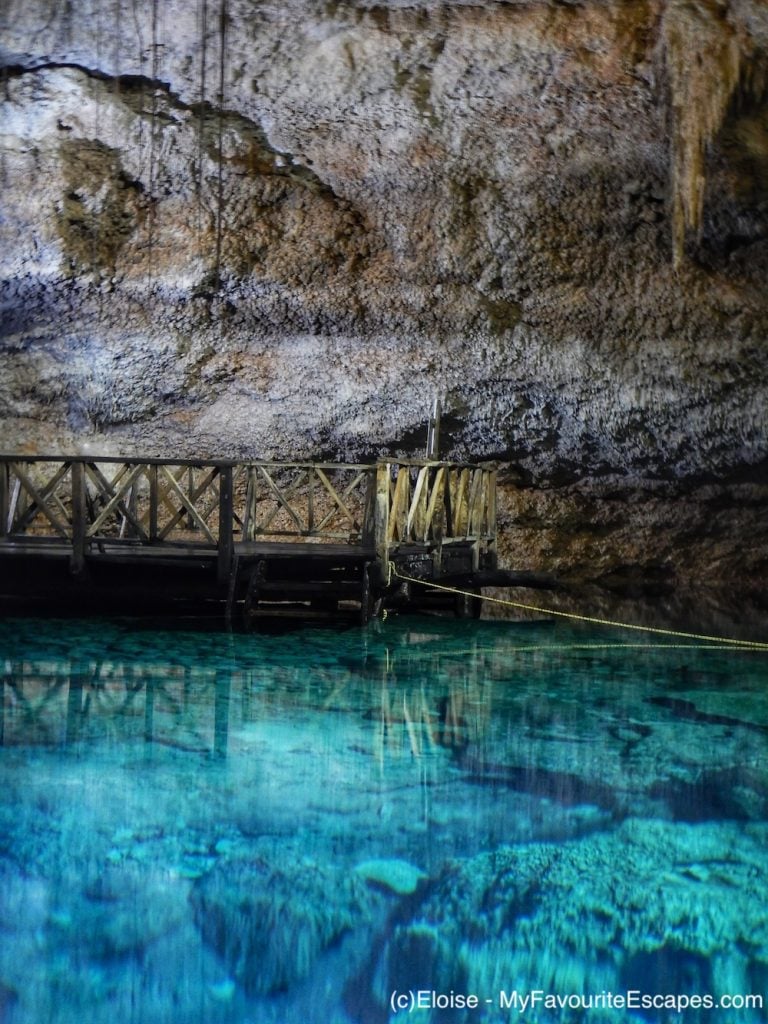
Cenote Multum-Ha
Submitted by Eloise of My Favourite Escapes
When visiting the ruins in Coba, you should not miss the nearby cenotes. Cenote Multum-Ha is eight kilometers away from Coba, and you’ll have to drive two kilometers on an unpaved road to get there.
From the outside, it looks like there’s nothing to see. But once you go down the narrow spiral staircase, you reach a magical place. You’re 18 meters underground with no natural light, but the crystalline water in the cave looks stunning and inviting. After visiting the ruins in the hot and humid jungle, it’s a refreshing break.
As Cenote Multum-Ha is not as easy to access as the other cenotes near Coba, you may have the place just to yourself. The silence and calm make the visit very special. The lighting, the wooden platform, the line in the water…it has been well prepared to ensure visitors enjoy their time in and out of the water. Some say Multum-Ha is great for snorkeling, but there’s actually no need for snorkeling equipment to see through the transparent water.
Toilets, changing rooms and showers are available before entering the cenote.
Address: Carretera Principal Km6, 77740 Cobá, Q.R., Mexico
How to Get There: Driving, hiring a taxi, or a tour is best: eight kilometers from the Coba ruins, two on an unpaved road. Coba is 45 minutes from Tulum. You can also hire bikes at Coba to ride to the cenote.
Hours: 8:00 AM-6:00 PM
Admission: 100 pesos ($5 USD)
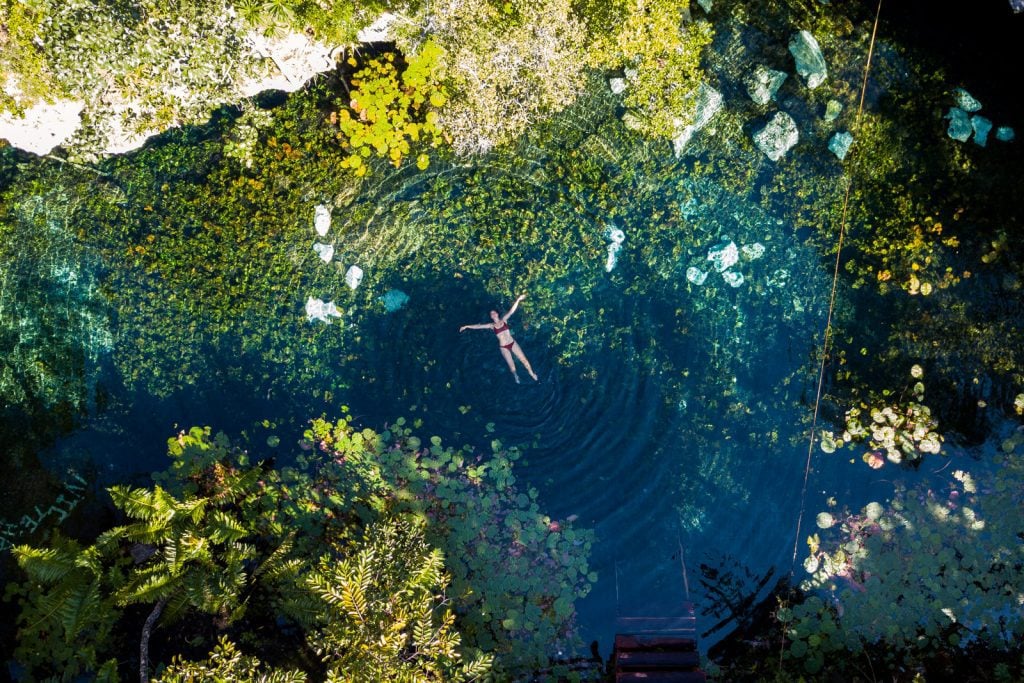
Cenote Nicte-Ha
Submitted by Steph of Every Steph
Cenote Nicte-Ha might not be as famous as Gran Cenote or its celebrity neighbor Cenote Dos Ojos, but that doesn’t mean it’s not worth your time. As you probably know by now (thanks Instagram!), swimming in cenotes is one of the best things to do in Tulum, and this is the perfect cenote if you fancy some peace and quiet.
Nicte-Ha is an open cenote, meaning that it looks like a natural open-air pool, which boasts crystal-clear, fresh water, and water lilies. The area around the cenote is very lush. Float on your back and look up at the sky, and it will feel like you’re swimming in the middle of the deep jungle.
Cenote Nicte-Ha is located in Parque Dos Ojos, on the same road where you’ll also find Cenote Dos Ojos and Cenote Jaguar, but it’s a completely different experience. Here you can escape from the crowds – come early in the morning and it won’t be difficult to have the cenote all for yourself.
Facilities at Cenote Nicte-Ha are limited – you’ll only find a (pretty basic) toilet here where you can get changed into your swimsuit if you need to.
Address: Cenote Jaguar Rd, 77780 Tulum, Mexico
How to Get There: Drive or take a taxi; it’s a 20-minute journey from Tulum.
Opening Hours: Daily, 9:00 AM-5:00 PM
Admission: 250 pesos ($12 USD)
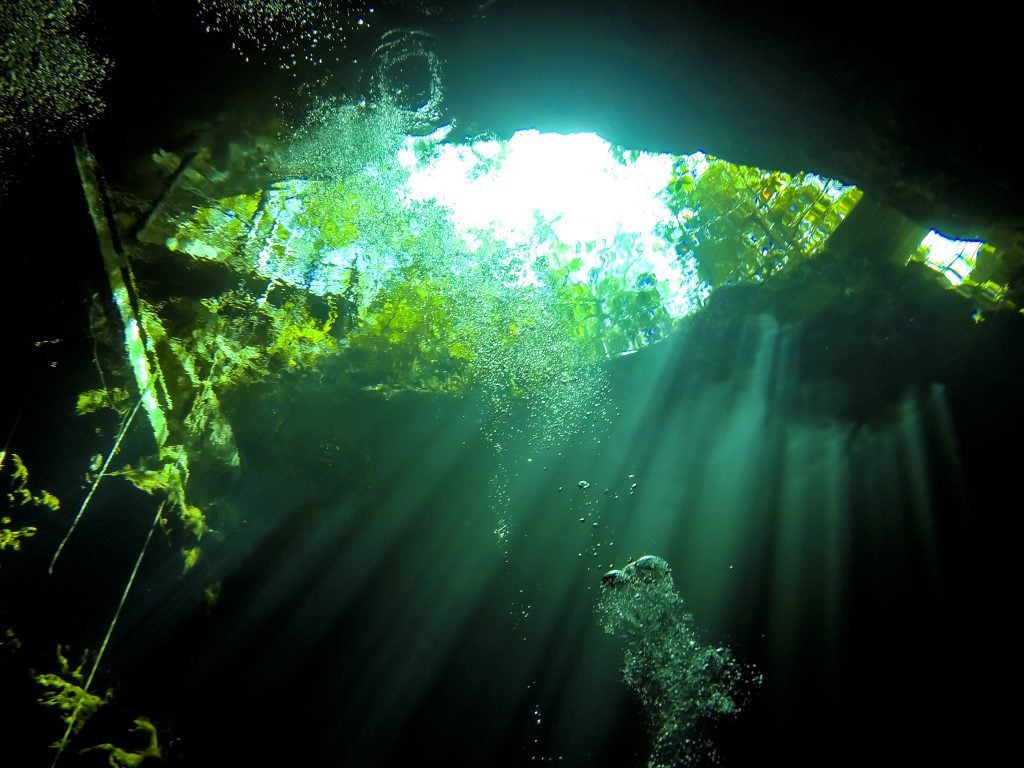
Cenote El Pit
Submitted by Katie Diederichs of Two Wandering Soles
Not far from Tulum sits one of the most impressive cenotes for scuba diving in all of Mexico: El Pit. Diving in a cenote is one of the most unique things to do in the Yucatán Peninsula, and it will likely be a highlight of your time in Mexico.
Instead of marine life, divers will witness a natural phenomenon known as a hydrogen sulfide cloud. This is formed when organic materials, like leaves, decompose in the water, leaving behind a smoke-like layer of water that feels as if you’re swimming through a cloud. El Pit is also known as a fantastic location for underwater photography, as the light streams down in a beautiful yet eerie beam that looks almost magical in pictures.
This cenote is really only worth visiting if you plan on diving, as the best views are from beneath the water. This means the best way to get to El Pit is to book a scuba diving tour with a reputable company that will bring you there and provide all the necessary gear. There is a $20 fee to dive here, and this is typically included in your scuba package.
Since this cenote is mostly geared toward divers, there aren’t many facilities in the area other than toilets and a few tables. While not the most exciting cenote for snorkelers or those who plan on staying out of the water, El Pit is without a doubt one of the most memorable dive sites in the Yucatán.
Address: Unmarked road north of Tulum, 77773 Quintana Roo, Mexico
How to Get There: Join a scuba tour.
Hours: 8:00 AM-5:00 PM
Admission: $20 USD diving fee, typically included in a scuba tour package
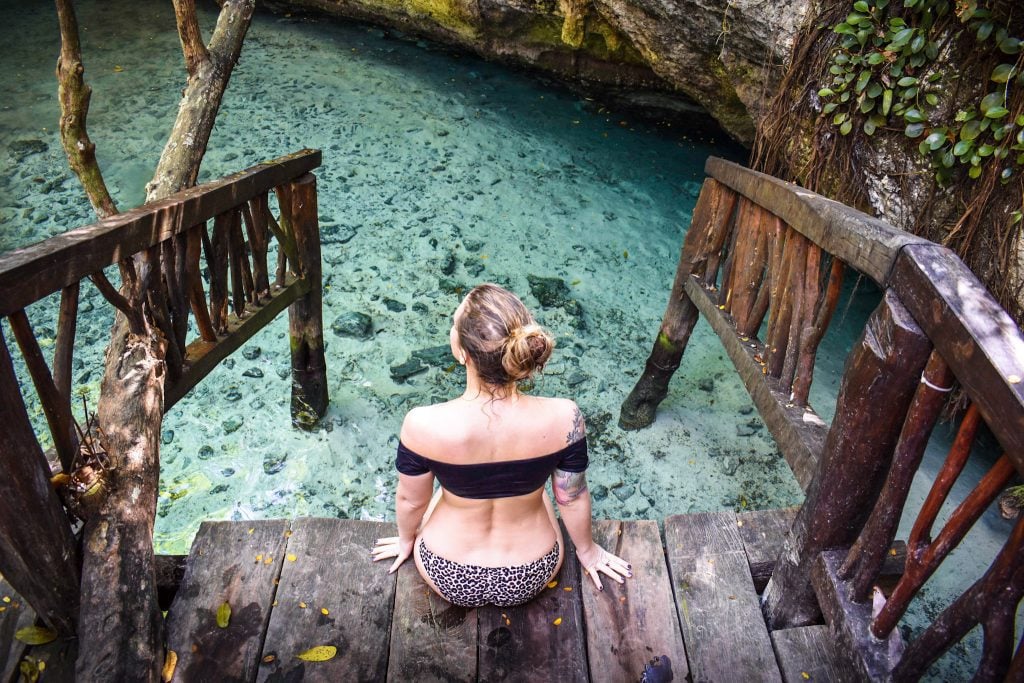
Gran Cenote
Submitted by Jessica Schmit of Uprooted Traveler
The Gran Cenote is one of the most famous cenotes near Tulum, and for good reason! With its incredible turquoise waters, stunning underwater stalagmites, and abundant wildlife, this cenote has something for everyone.
Another bonus? Its location is only a 10 minute drive from the city’s downtown, so it’s easily accessible by taxi or even by any of the bikes that many hostels and hotels rent out.
Once you’ve arrived, you can take advantage of the lockers, life jackets, or snorkeling gear available for rent before jumping in the cool waters. Renting snorkeling gear is definitely a good call — in fact, this is one of the best snorkeling or diving spots in the area, with amazing rock formations below the water, which cause spectacular light beams to shine through the clear water, and dozens of tiny freshwater turtles and small fish swimming about.
Be sure to also paddle through the tunnel-like cave, with hundreds of chirping bats hanging overhead — there’s a second pool on the other side that’s incredibly picturesque and usually less busy than the cenote’s main section.
The Gran Cenote is quite popular with tour groups, so if you’d prefer to enjoy the cenote in peace, you should either aim to visit before 9:00 AM or after 3:00 PM. It’s also on the pricey side for a cenote, but thanks to its accessibility and picturesqueness, it’s certainly worth a stop to cool off while you’re in Tulum!
Address: Quintana Roo 109, 77796 Tulum
How to Get There: You can take a car or taxi — or rent a bike, as it’s close enough to Tulum.
Hours: Daily, 8:00 AM-4:45 PM
Admission: 300 pesos ($15)
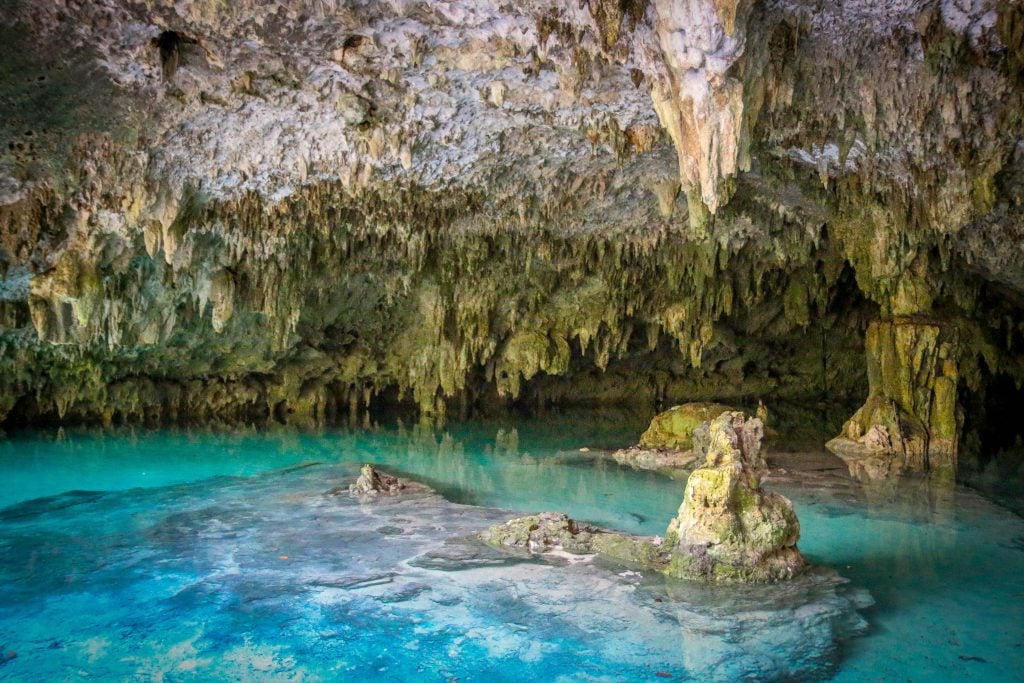
Cenotes Sac Actún
Submitted by Bret Love of Blue Ridge Mountains Travel Guide
Located approximately halfway between the towns of Tulum and Akumal off Highway 307, Cenotes Sac Actún was established as the largest underground cave system in the world in 2018. It’s part of the Sac Actún river system, which stretches more than 163 miles, but exploration eventually proved it to be connected to the Dos Ojos cave system, which added another 52 miles to the total.
Long a favorite area for archeologists to explore, Sac Actún was made famous by the BBC’s Planet Earth and various National Geographic documentaries. The remains of a huge mastodon were discovered within the cave system back in 2008, as well as other animal skeletons and the skull of a teenage girl that was believed to be the oldest evidence of human habitation in the Yucatán Peninsula.
The cave is an easy day trip about 25 km from the heart of Tulum, and snorkeling its brilliant blue waters, surrounded by countless stalactites and stalagmites, is truly an otherworldly experience. It’s also a great way to beat the midday heat, as the water is as cool as the cave is dark.
While Sac Actún is commonly included in organized tours of the area, you can also do the guided snorkeling tour independently for around 450 pesos ($22 US), which includes a mask and snorkel.
The knowledgeable guides will use their flashlights to help point out unique rock formations, tiny fish below, and bat colonies above. But if you want to shoot underwater video, we highly recommend bringing your own flashlight (or renting one for an additional fee).
While the entrance fee may be pricier than other nearby cenotes, Sac Actun is a magical place that’s filled with caverns to explore. Get there first thing in the morning and you might even have the whole place to yourself!
Address: Carretera Federal 307 (Cancun-Chetumal) pasando, Xel-Ha, un kilometro hacia, 77760 Tulum, Q.R., Mexico
How to Get There: Driving or taking a taxi is best.
Hours: Daily, 9:00 AM-5:00 PM
Admission: $35 USD for entry, 450 pesos ($22 USD) for the snorkeling tour
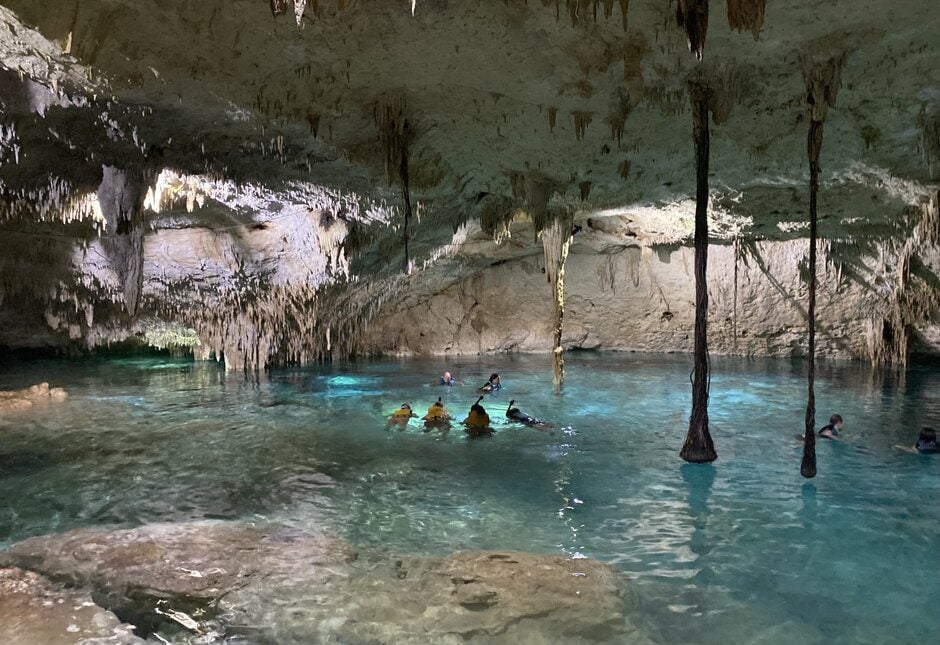
Cenote Taak Bi Ha
Submitted by Daria of The Discovery Nut
Located near popular Cenote Dos Ojos, Cenote Taak Bi Ha is often overshadowed by its famous neighbor. But make no mistake, Cenote Taak Bi Ha is well worth a stop thanks to its spectacular stalactites and stalagmites that leave many visitors in awe.
This cave cenote is also home to many bats and birds as well as an impressive cave system that attracts many divers. The water in Cenote Taak Bi Ha is spectacularly clear and its relatively shallow depth makes for a fun dive. Diving must be arranged with one of local tour operators, as diving in cenotes requires a special license.
Cenote Taak Bi Ha doesn’t have a lot of amenities besides parking, a small on-site store and life vests available at no extra fee.
Address: Taak Bi, Parque Dos Ojos Cenote S/N, Xel-Ha, 77762 Tulum, Q.R., Mexico
How to Get There: Best by driving or taxi. The entrance is behind Cenote Dos Ojos; continue along the bumpy road until you see the Cenote Taak Bi Ha sign.
Hours: 9:30 AM-5:00 PM
Admission: 400 pesos ($20 USD)
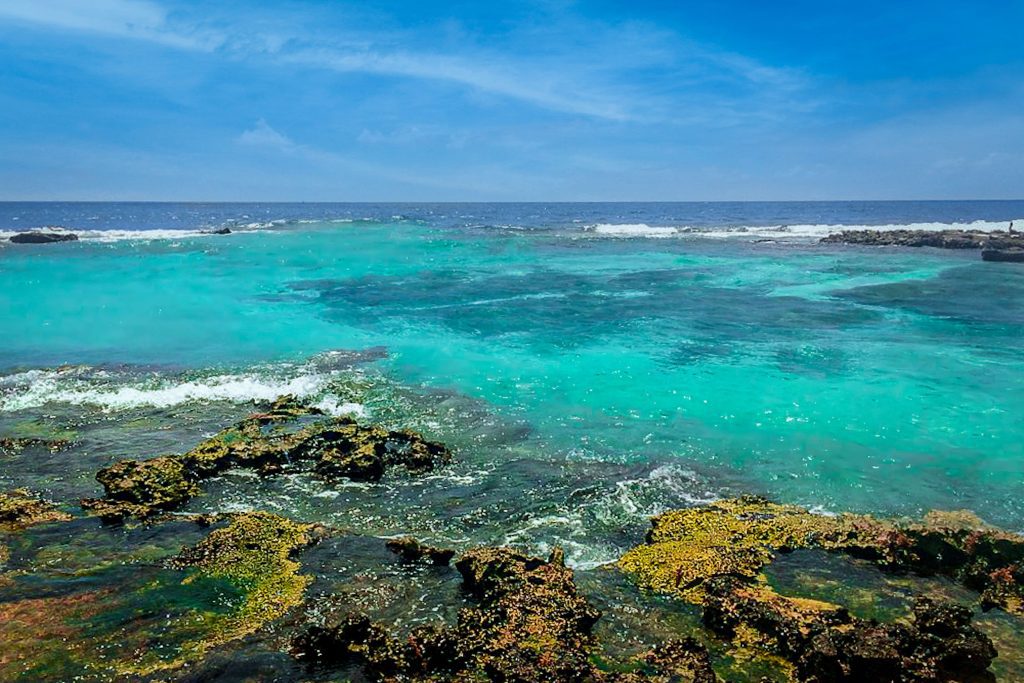
Cenote Tankah
Submitted by Natasha Karcz from Planes, Trains and Karcz
Located a quick 10-minute drive northeast of Tulum’s vibrant core is one of its best kept secrets – Cenote Tankah. Accessible via hopping on the Tulum-Playa del Carmen bus or opting for a quick colectivo ride to the turn-off for the rustic Caleta Tankah Hotel, entry to the grounds includes a full meal plan with cocktail, a beachfront daybed and access to the entirety of their jungle property (which backs onto the renowned Tulum National Park, no less!).
Ensure to arrive early as the grounds act as an extraordinary alternative to the otherwise heavily trafficked public beach in Tulum. Boasting soft white sand and the Riviera Maya’s signature turquoise waters, you can anticipate all the luxury of Tulum with none of its crowds. It’s here, nestled within a rocky shoreline alcove, that you’ll find the seaside oasis of Cenote Tankah.
Cenote Tankah, with its unique fusion of cool cenote groundwater and the crashing waves of the surrounding Caribbean Sea, form somewhat of a natural infinity pool; complete with unparalleled views and dreamy atmosphere. Add to the experience with a snorkel rental if you wish to really take in the plentiful marine life and rock formations, including tropical fish and crabs.
Be it as a stop on your greater Yucatán Peninsula adventure or as its own day trip, you’ll find no shortage of things to keep you busy and entertained at the scenic Cenote Tankah.
Address: Calle, México 307, 77760 Tulum, Q.R., Mexico
How to Get There: Driving or taking a taxi is best; you can also take a colectivo or bus.
Hours: Daily, 9:00 AM-5:00 PM
Admission: 300 pesos ($15 USD) includes entry, meal, cocktail, and full access to grounds
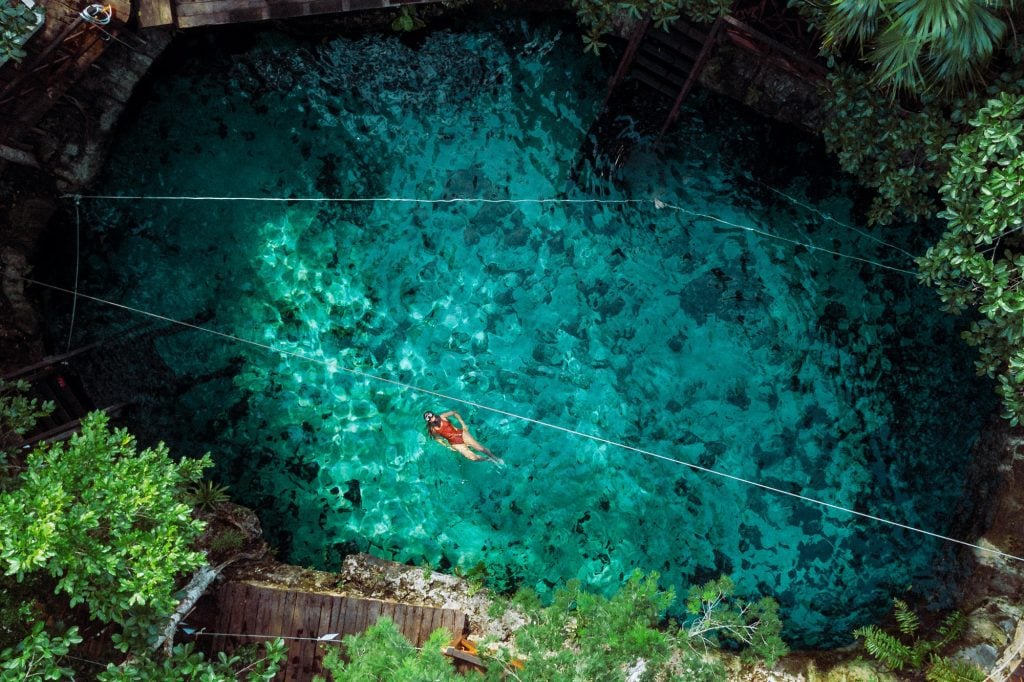
Cenote Zacil-Ha
Submitted by Rachel-Jean Firchau of Rachel Off Duty
If you’re looking for an easily accessible, straightforward cenote near Tulum, look no further than cenote Zacil-Ha! Located just 10 minutes up the road from Tulum town by car, this small open-air cenote resembles a natural swimming hole, and because it’s not as popular as some of the other cenotes in the immediate area, visitors can usually expect smaller crowds and a more relaxing experience overall.
Cenote Zacil-Ha is one of the more developed cenotes in Tulum, and you get access to a decent range of amenities including onsite bathrooms and changing areas, optional life jacket rentals, access to two man-made pools, and a small restaurant.
The cenote itself offers a handful of platforms from which to jump, a zipline suspended over the water, and a lifeguard on duty, making Zacil-Ha a great choice for those looking for a cenote with easy access points (no hiking, trekking, or long staircases required), or one that’s simply a more convenient choice for families and large groups.
Beyond its family-friendly qualities, Zacil-Ha is not one to overlook, even if you’re a solo traveler or couple looking for adventurous things to do in Tulum. Crystal-blue water with incredible visibility, coupled with deep underworldly crevasses you can only truly admire if you hold your breath and dive down, await you at this Tulum cenote. Be sure to bring goggles!
Address: Coba km 8, México 180D, 77780 Tulum, Q.R., Mexico
How to Get There: Driving or taking a taxi from Tulum is best.
Hours: Daily, 10:00 AM-5:30 PM
Admission: 200 pesos ($10 USD) for entry, 10 pesos ($0.50 USD) for the zipline
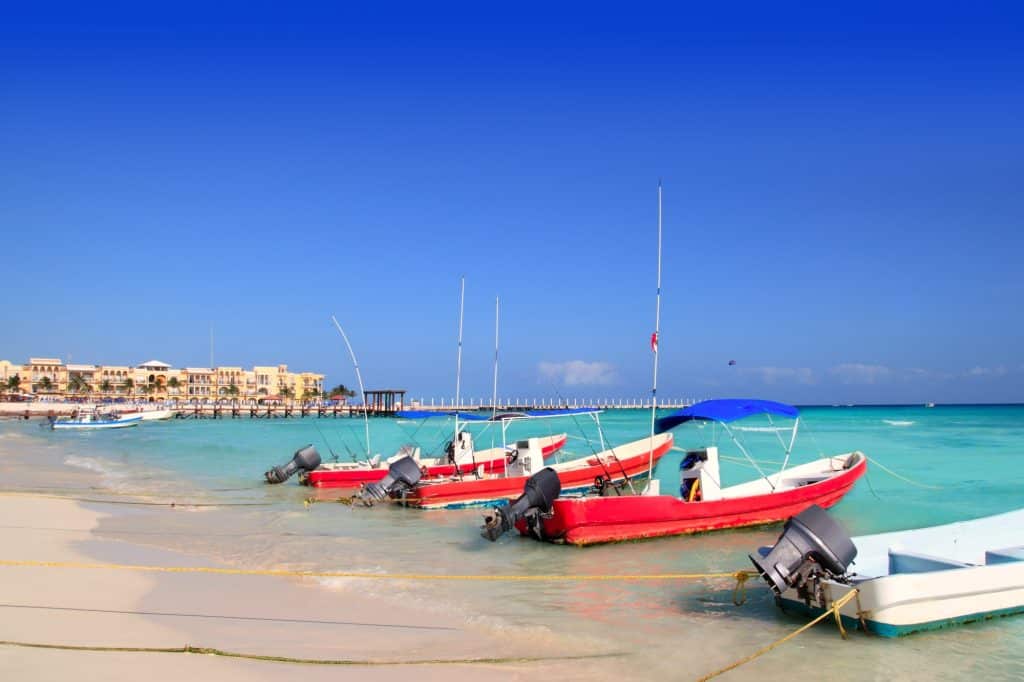
Cenotes Near Playa del Carmen
Playa del Carmen is one of the most popular resort towns in Mexico, and for good reason! What began as a smaller, more low-key alternative to Cancun has grown into a large city with everything you could hope for, right on the beach.
Many cenotes in the Playa del Carmen area are just off the road between Playa del Carmen and Tulum, like Jardin del Eden Cenotes and Cenote Azul.
The Playa del Carmen area is also home to Ruta de las Cenotes — a collection of cenotes near the town of Puerto Morelos. Some of these cenotes include Cenote Elvira, Cenote La Noria and Cenote Zapote.
For cenote tours, check out the Cenote Tours in Playa del Carmen section, or see a few suggestions below.
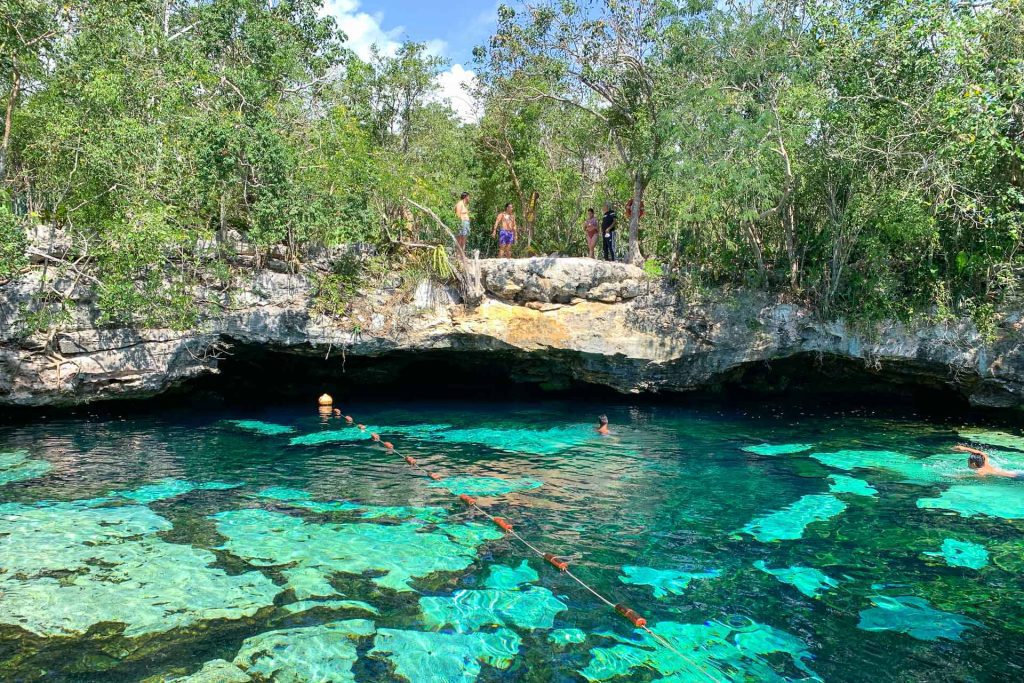
Cenote Azul
Submitted by Hannah and Adam of Getting Stamped
If you are staying in Playa del Carmen and looking for a great cenote nearby, make sure to check out Cenote Azul. It’s located about 20 minutes south of Playa del Carmen and 30 minutes north of Tulum.
A great way to visit cenotes in the Riviera Maya is with a rental car, but you could easily take a Colectivo (shared minivan taxi), which is super easy and cheap. Most drivers will know exactly where Cenote Azul is since it is one of the more popular cenotes. If they don’t the cenote by name, you can tell the driver to drop you off at the Barcelo Hotel – Cenote Azul is basically right in front of the hotel.
Once you arrive you’ll see why how this cenote got its name and why it’s so popular. Azul is the Spanish word for the color blue, and this cenote definitely has some of the bluest waters you’ll ever dip your toes in. The crystal clear water reveals massive limestone boulders plunked into the blue water and make a postcard-worthy view.
On top of the stunning scenery, Cenote Azul is often believed to be one of the largest cenotes in Mexico at around 600 feet wide. This cenote is an open-top cenote surrounded by lush jungle, which means lots of sunshine and less steps making it more accessible than some other cenotes.
Cenote Azul is great for families, swimming, and just relaxing — it’s a place where you could spend the whole day. The main pool in the middle of the area is perfect for cliff jumping, with clear deep waters. There are many smaller pockets and separate pools of water if you want some alone time too.
You can also rent snorkel gear & a life vest or go a little deeper and try scuba diving in a cenote! Toilets are available and there’s a little shop to get snacks, but not much more than that. Plan on packing some snacks, find a shady spot, take your time, and enjoy the cenote.
Address: On an unmarked road off the highway in Xpuha, Quintana Roo, Mexico
How to Get There: Drive or take a taxi or colectivo south of Playa del Carmen.
Hours: Daily, 8:30 AM-5:00 PM
Admission: 120 pesos ($6) for adults, 80 pesos ($4) for children age 4-8, 100 pesos ($5) for Quintana Roo residents
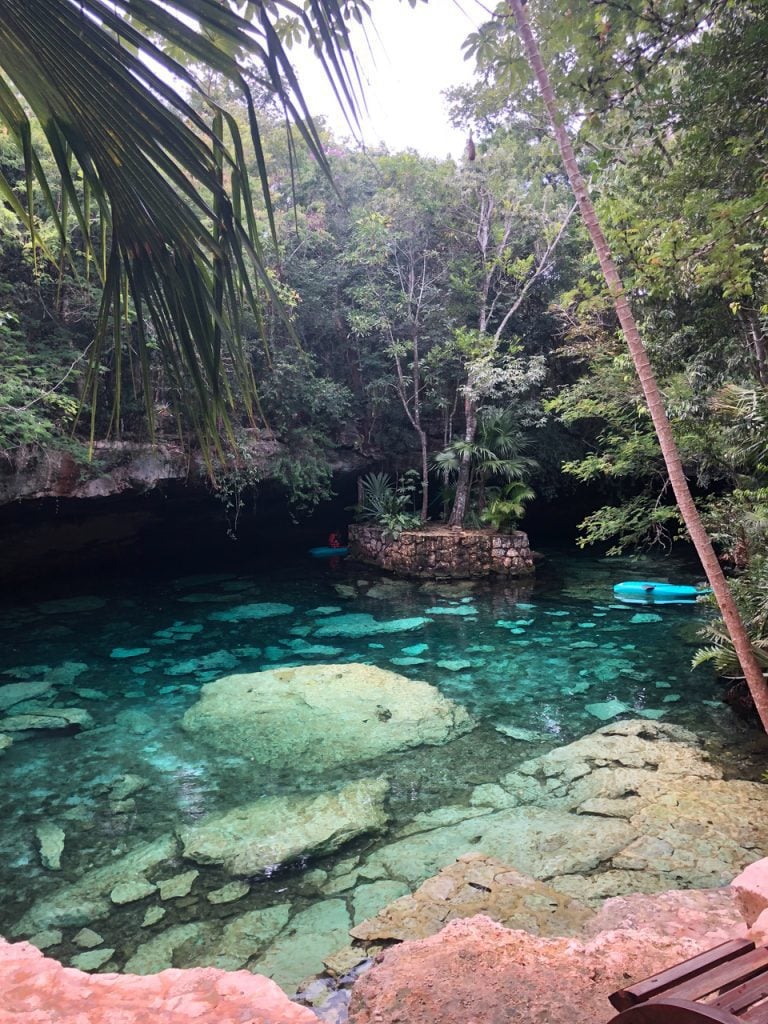
Cenote Chikin Ha
Submitted by Victoria Heinz of Guide Your Travel
Chikin Ha Cenote is located 30 minutes south of Playa del Carmen and just under 40 minutes north of Tulum. This cenote is half protected by a cave that is popular among divers and known for its crystal-clear azure water. You can swim and snorkel at Chikin Ha or explore the surrounding jungle.
Chikin Ha is a fantastic cenote to visit because you actually get a lot for your money and can visit several cenotes at once. The main cenote is arguably one of the most beautiful in the area and perfectly combines a refreshing swimming spot with a true cave exploration experience. It‘s also well-maintained and safe so even inexperienced swimmers can enjoy it.
Chikin Ha is actually made up of three different cenotes. For an extra charge you can even try ziplining, get snorkeling gear or rent bikes to get around. Don’t miss out on this cenote, it’s one of the best things to do in Mexico.
Address: On an unmarked road in Xpu-Ha, south of Playa del Carmen
How to Get There: Drive or take a taxi or colectivo.
Hours: Daily, 9:00 AM-5:00 PM
Admission: 350 pesos ($17 USD)
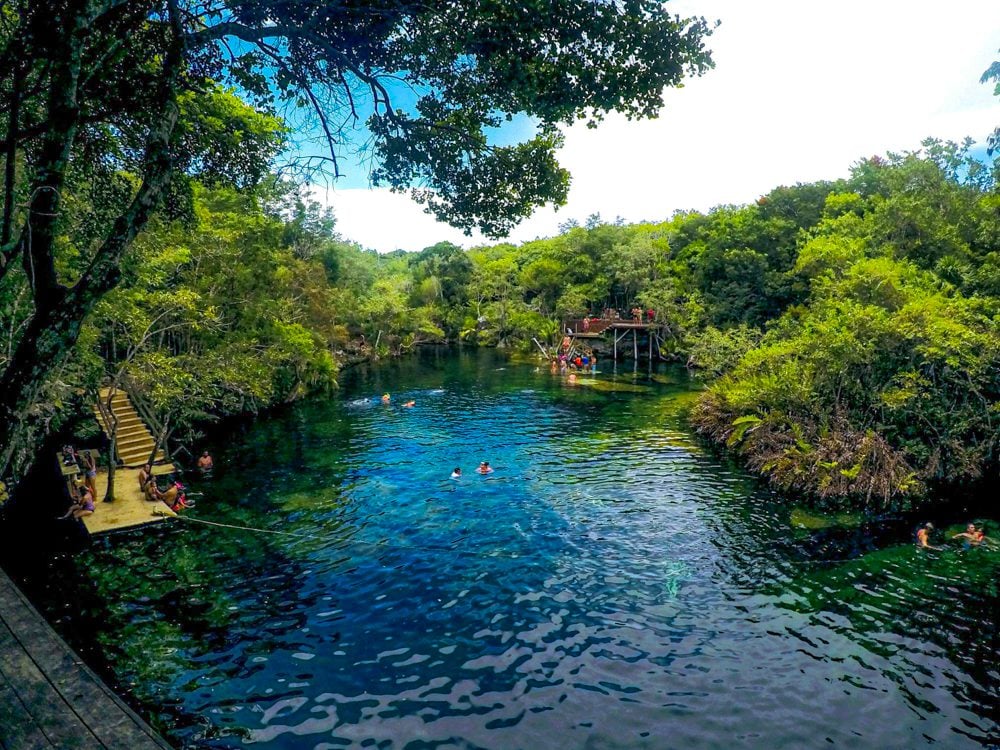
Eden Cenote
Submitted by Allison Sicking of Viva La Travelista
Located less than 30 minutes south of Playa del Carmen, Eden Cenote is an expansive open cenote perfect for adventure seekers. As the name suggests, the Garden of Eden Cenote (Jardin del Eden Cenotes) is a lush natural retreat where you’ll find a deep swimming hole surrounded by dense greenery and overgrown trees.
With only restrooms and life jacket and snorkel rentals, there are few amenities on site. Eden Cenote is more of a relaxed setting where you can swim, snorkel, or just hang out in the water or on one of the many wooden platforms around the cenote.
For those looking for an adrenaline rush, you’ll find a few different jumping ledges, the highest being from a sturdy tree protruding over the water. For scuba divers, Cenote Eden also offers a popular dive site for underwater cave diving.
Address: Unmarked road off Route 307, south of Playa del Carmen near Xpu-Ha
How to Get There: Driving or taking a taxi is best, or you can take a colectivo.
Hours: Sunday to Friday, 9:00 AM-5:00 PM
Admission: 200 pesos ($10 USD)
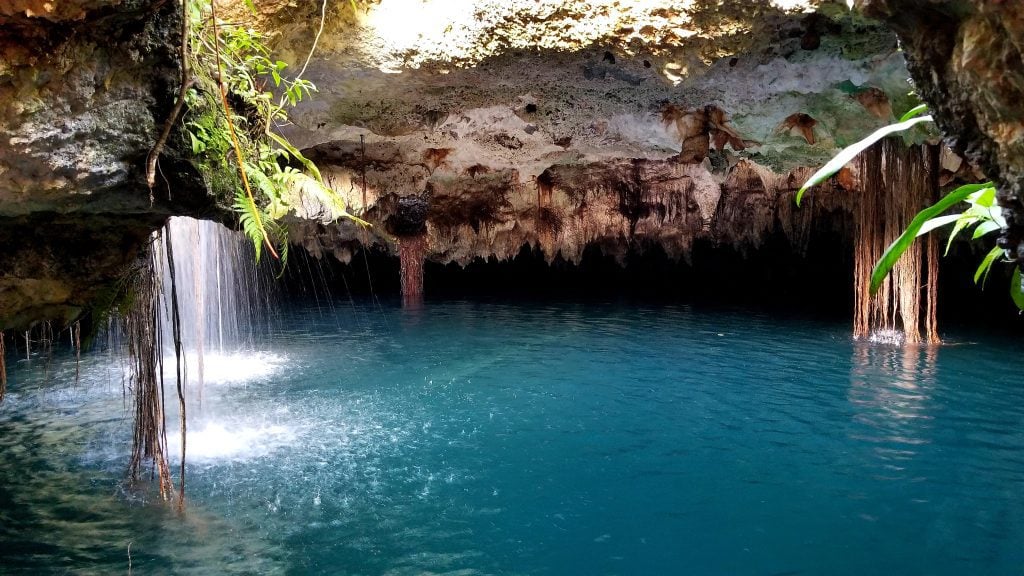
Cenote Elvira
Submitted by Nathan Sado of All About Glamping
Cenote Elvira is a magical cenote that can be rented out privately for the day with friends. The cenote itself has a waterfall flowing into it with a hanging swing for that perfect Instagram shot.
Not only is Cenote Elvira beautiful, but the property is amazing as well. Nestled among the jungle trees, the owners also offer a bar/kitchen area with a refrigerator and tables. There is a charcoal BBQ area and multiple hammocks and lounging areas to relax after a swim.
Various trails wind through the jungle for exploration and bathrooms and showers are on site. You may see the owner’s jungle pets from time to time, a few super cute dogs, and a Coati (Mexican raccoon).
You must book the cenote in advance and the rate is around 100-120usd for the day. This allows you to use the cenote and property from 10:00 AM until dark. Make sure to bring food, drinks and a change of clothes. Life jackets are usually provided if people in your group need them.
Address: Ruta de los Cenotes KM 20.8, Quintana Roo Puerto Morelos – Leona Vicario, 77580 Puerto Morelos, Q.R., Mexico
How to Get There: Driving or taxi is best, especially if you stay until dark. 45 minutes from Playa del Carmen or 50 minutes from Cancún.
Hours: Daily, 10:00 AM-6:30 PM
Admission: $30 USD per adult, $25 USD per child, to rent out the property for the full day
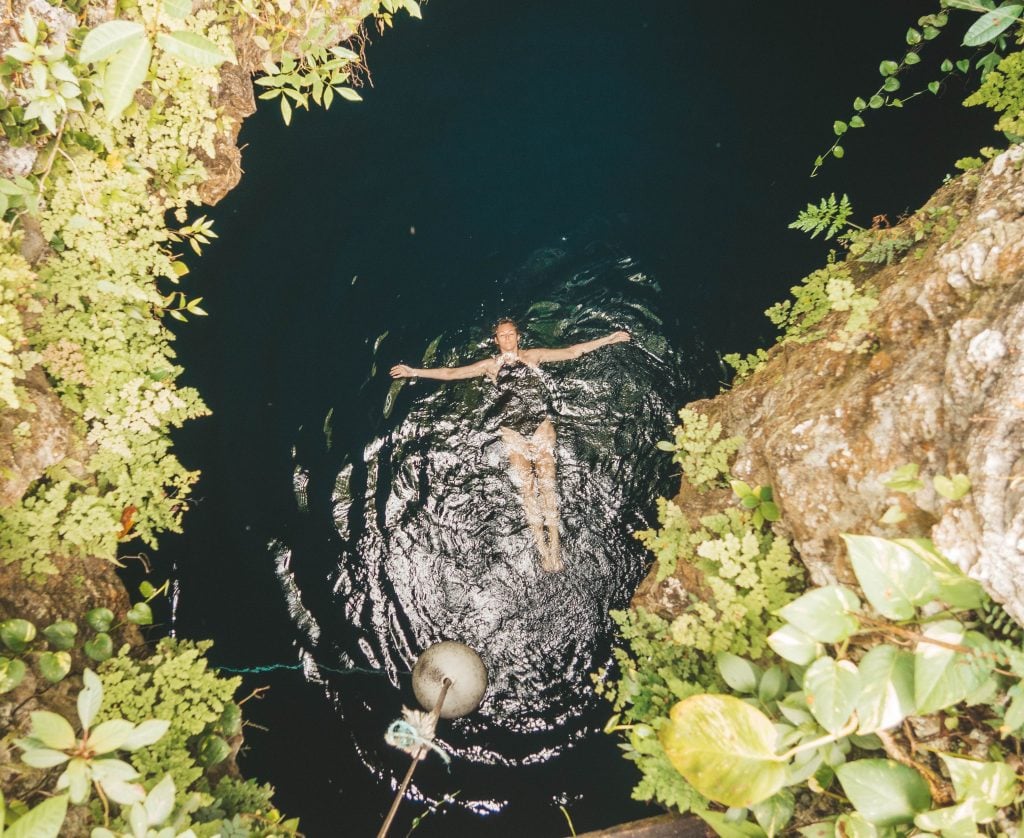
Cenote Kin Ha
Submitted by Claire Summers of Claire’s Itchy Feet
One of my favorite cenotes in Mexico is Cenote Kin Ha. Located in Puerto Morelos, a small fishing town, sandwiched between Playa del Carmen and Cancún, the cenote itself is located on La Ruta de los Cenotes.
The reason Cenote Kin Ha stands out for me is because of the activities that you can do there. It’s a closed cenote with incredible rock formations. There is also a large hole in the roof which you can jump in, or float in the water and get someone to take your picture from above. Scuba diving here is incredible and it is one of the rare deep cenotes dives non-cave divers are permitted to explore.
Other than swimming and scuba diving, at Cenote Kin Ha you can ride ATV’s and go horseback riding. There are several cenotes inside the park; the other one I would recommend visiting is Cenote Blanca Flor, especially if you are into ziplining 10 meters over a cenote and then letting go and jumping in (one of the more terrifying things I’ve done).
The only downside to visiting Cenote Kin Ha is that it can be tricky to get to unless you have a car. The best way to do this is to take a taxi and make an arrangement with the driver to collect you later in the day. Or rent a car from Playa del Carmen or Cancún and drive yourself; it’s super easy to find.
Address: KM 18 de la Ruta de los Cenotes, Puerto Morelos, Q. Roo Mexico
How to Get There: Best to drive or take a taxi. Collectivo also an option.
Hours: Daily, 9:00 AM-5:00 PM
Admission: 315 pesos ($15 USD) for entry, more for ATV riding or horseback riding
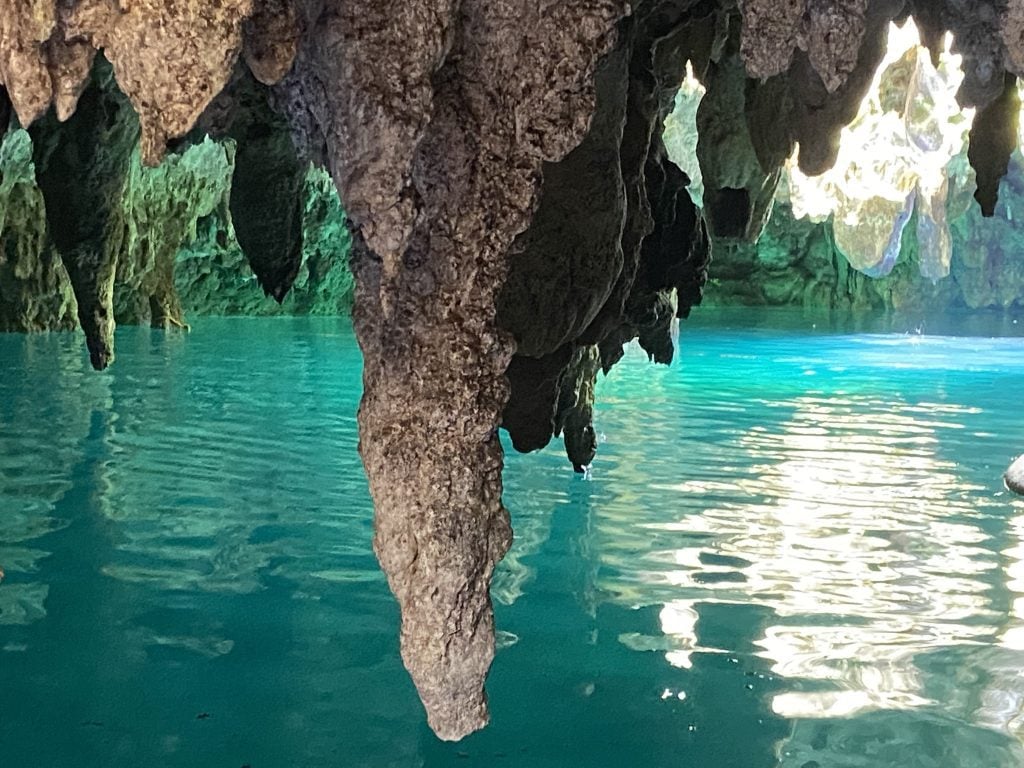
Cenote La Noria
Submitted by Karen of Outdoor Adventure Sampler
Cenote La Noria is located on La Ruta de los Cenotes near Puerto Morales, about an hour’s drive from both Cancun and Playa del Carmen. Cenotes Kin Ha and Zapote are nearby if you want to explore other cenotes in this part of the Mayan jungle.
La Noria is a cavern cenote with gorgeous turquoise water. Low hanging stalactites in the cave add to the magical experience. Entry to the cenote is via a stone ramp with stairs into the water. You can also jump through one of two holes on the surface into the water from an exciting height. A wooden raft floating in the cenote center is a great place to hang out or to launch on a rope swing across the water.
Admission to Cenote La Noria includes a lifejacket, locker, and use of the scenic grounds with picnic tables and hammocks. An on-site open air restaurant serves typical Yucatecan food as well as excellent pizza.
Other activities available at La Noria include zip-lining, riding ATVs in the jungle, and horseback riding for an addition fee. Certainly, beautiful crystal clear Cenote La Noria is one of the many amazing outdoor adventures on the Yucatan peninsula.
Address: On an unmarked road, Puerto Morales, Quintana Roo, Mexico
How to Get There: Drive or take a taxi; buses also available.
Hours: Daily, 9:00 AM-5:00 PM
Admission: 250 pesos ($12.50 USD) for locals and $20 USD for everyone else; additional fees for zip-lining, ATV riding, and horseback riding
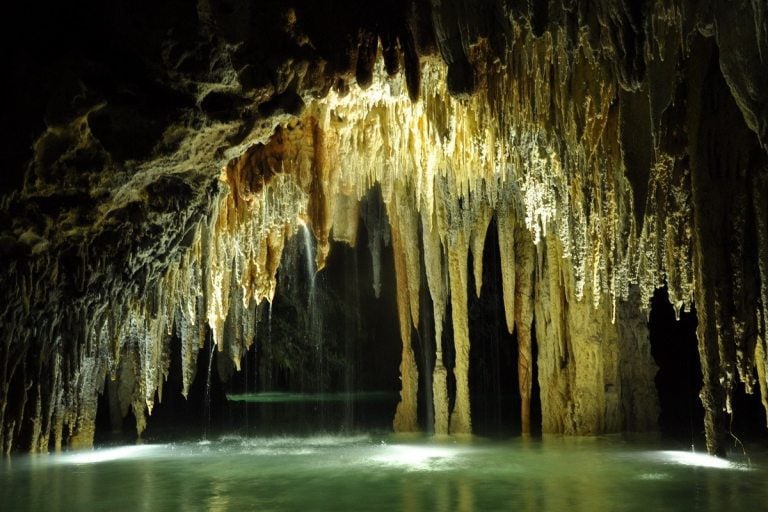
Rio Secreto
Submitted by Elle MacRae of 5 Suitcases
Rio Secreto is Mexico’s newest cenote! The underground cave system wasn’t discovered until 2005. Local legend has it that a farmer was chasing an iguana when he came upon a cave. Upon entering the cave, he found several different rooms and a secret underground river.
Over the course of the next few years, the caves became designated as a preservation site. Rio Secreto has 7.5 miles of underground rivers to explore. In some parts of the cave, the water is only ankle-deep; in others, the water is deep enough to swim.
Every tour of Rio Secreto is slightly different. There are fifteen different entrances to the cave system and each tour enters from a different point. This allows for a more intimate experience as you explore the caves.
A tour is required to visit Rio Secreto. The standard tour takes about 3.5 hours while the premium option takes 5.5 to 6 hours. Tours include an experienced guide, wetsuit, life jacket, helmet, towels, and lunch.
Address: Carretera Federal Libre Chetumal- Puerto Juárez Ejido Sur, 77712 Playa del Carmen, Q.R., Mexico
How to Get There: Many tours will pick you up from your hotel or a central pickup point.
Hours: Daily from 9:00 AM
Admission: $79 USD for adults, $39.50 USD for children age 4-12
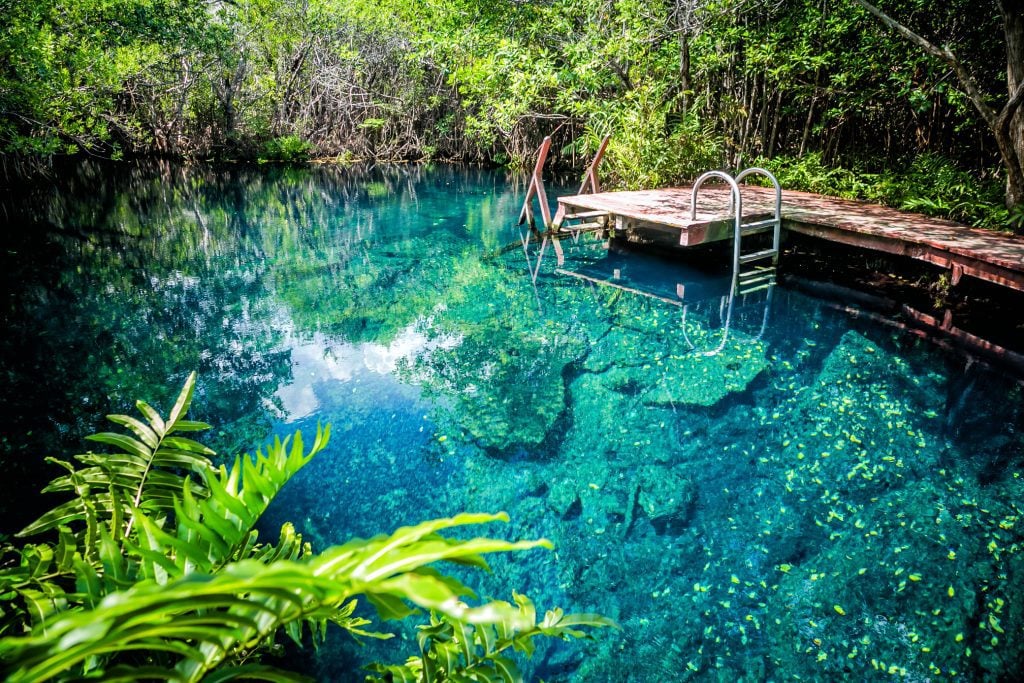
Hacienda Tres Rios
Submitted by Lina and David Stock of Divergent Travelers
If you’re someone who loves exploring cenotes surrounded by pure nature where the animals outnumber the guests, then you need to visit Hacienda Tres Rios Nature Park and its 10 different natural cenotes. The Tres Rios Nature Park is a 326-acre natural paradise connected to Hacienda Tres Rios Resort that offers three distinct ecosystems including jungle, mangrove forest, and coastal dunes.
Getting to the cenotes is part of the adventure, twisting and winding through a protected ecosystem that’s unlike any other cenote property located along the Riviera Maya. It truly has been untouched by humans. Visitors have the chance to explore by foot, segway, or bike either as part of a tour or independently depending on how one likes to explore this ecological oasis.
Hacienda Tres Rios Nature Park offers a wide range of cenotes, each different from the next. Some offer bright blue, crystal clear water while others have water that is black as night.
The most popular one is Cenote Aguila, where guests can swim in its crystal-clear waters surrounded by an untamed jungle. For the adventurous, you can snorkel around exploring all the aquatic life that calls these cenotes home. You can also float or kayak along its connecting river that leads to a private white sandy beach covered with palm trees.
Address: Carr. Cancún – Tulum km 54, 77760 Playa del Carmen, Q.R., Mexico
How to Get There: Drive, or take a taxi or colectivo between Cancún Airport and Playa del Carmen
Hours: Daily, 8:00 AM-5:00 PM (resort guests have 24-hour access)
Admission: Resort passes are $35-75 USD depending on amenities
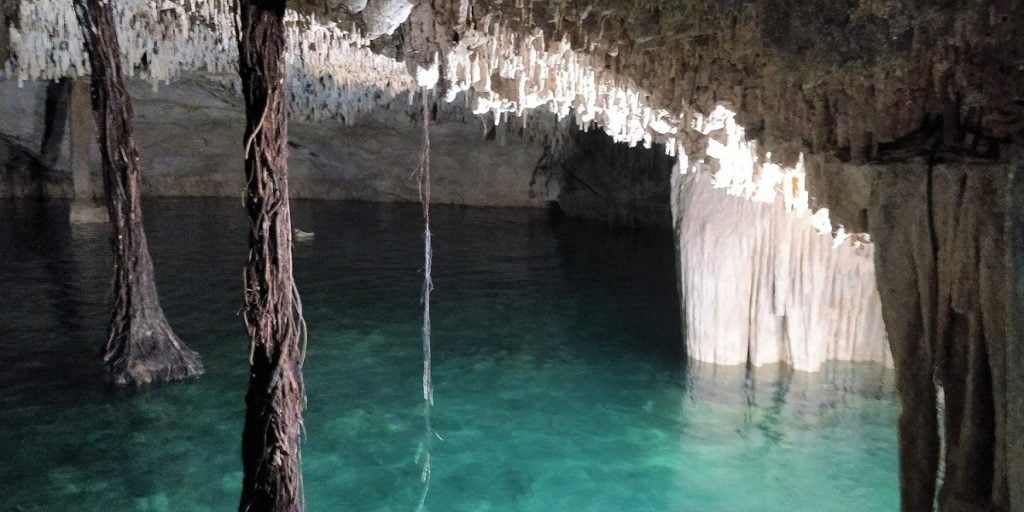
Cenote Zapote
Submitted by Venaugh
Of all the cenotes in Mexico, Cenote Zapote is one of the most beautiful, and located close to what I think is one of the best cities in Mexico, Playa del Carmen. Fun fact, it actually consists of four different cenotes, which was a pleasant surprise.
Whether you’re coming from Playa del Carmen or Cancun, it can take about an hour to get to this cenote. Entry was a bit expensive at 800 Mexican pesos, which was the basic package. At the main site, there is also a restaurant with bathrooms.
Starting with an open cenote, the first cenote looks much like a lake encircled with lush trees. The second is a bit intimidating as it’s an indoor cave that is quite dark.
Following this is another indoor cenote, however this one is bigger and the lighting was better, both natural, through a small opening, and artificial. There was a lot to see in this cenote as you swim in a circle around the main entrance allowing you to see the amazing rock structures.
The final cenote is exactly how you imagine a cenote should look, the blue pool reflecting the lush trees around. You can even dive off the platforms or scuba dive here, as it is 20 meters deep.
Address: Puerto Morelos, Av. Ruta de los Cenotes km 19, 77580 Puerto Morelos, Q.R., Mexico
How to Get There: Drive, take a taxi, or take a colectivo from Playa del Carmen or Cancun.
Hours: Daily, 9:00 AM-8:00 PM
Admission: Packages to Cenote Zapote Prehistoric Park start at 800 pesos ($40 USD)
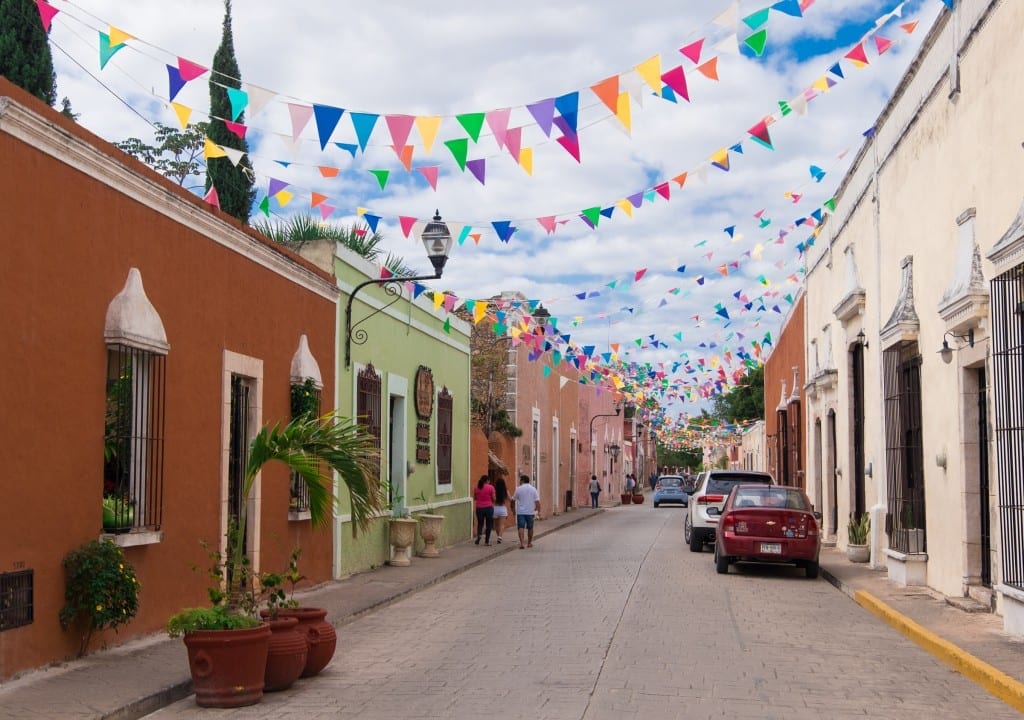
Cenotes Near Valladolid
Valladolíd is an absolute delight of the Yucatán. This small city is full of color and energy, and has more of a local feel than the busy resort towns on the Riviera Maya.
If you are looking to visit several Mexico cenotes, I strongly urge you spend some time in Valladolíd. There are lots of organized day trips to Valladolíd from Tulum and Playa del Carmen, but I recommend you stay at least one night.
The Valladolíd area is home to some of the best cenotes in Mexico, including Cenote Oxman, a personal favorite of mine; Cenote Suytun, the most famous cenote in Instagram; and Cenote Zaci, a striking behemoth right in the center of downtown Valladolíd!
Valladolíd also makes a great base for visiting the Chichén Itzá ruins, and visiting a nice cool cenote is the perfect post-ruins treat.
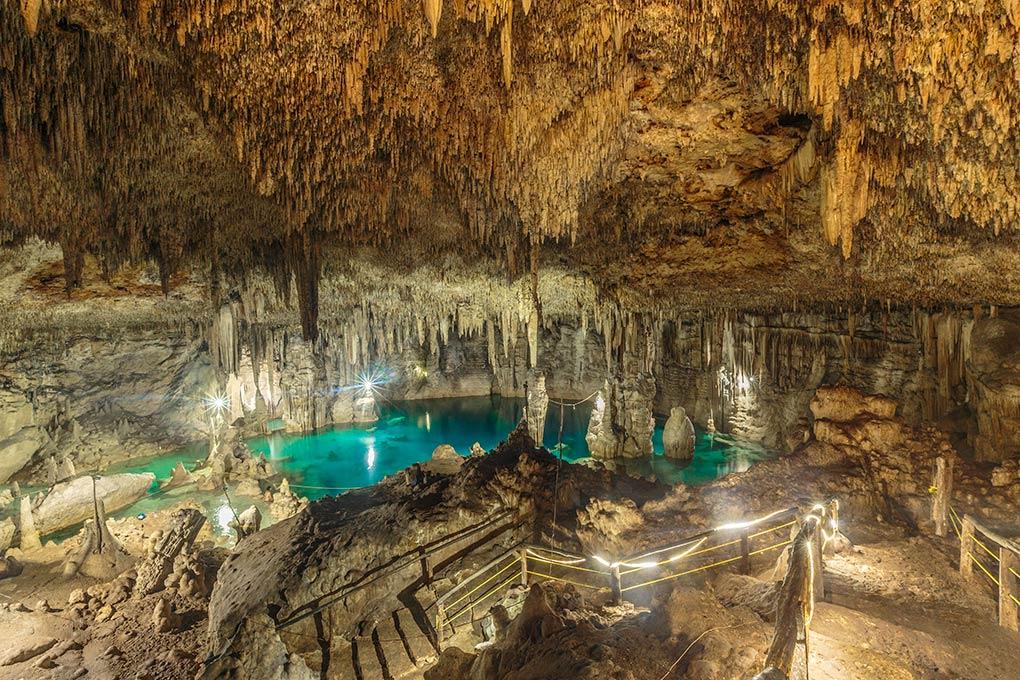
Cenote Choj-Ha
Submitted by Isabella of Mexico Cenotes and Ruins
Even though it’s been there for quite some time, Cenote Choj-Ha has only recently been put on the map of tourists and travelers. One reason is that it’s a little off the beaten path and it hasn’t been very much advertised until recently.
However, it’s a spectacular cenote that is worth a detour, even if it’s not exactly in your Yucatan itinerary.
Located on the main road from Cancun to Valladolíd, at only 12 km from Valladolid, Cenote Choj-ha is one of the most spectacular cave cenotes of the Yucatan peninsula.
Once you walk down the man-made stairs you enter a magnificent natural work of art made by an infinite number of stalactites and stalagmites wrapping a crystal clear green lake. The view is surreal and it’s been nicknamed “the Cathedral”. It actually looks like that. For better enjoyment make sure you get there early morning and avoid weekends so you will have the cenote all for yourself.
The cenote is managed by a local Mayan community that is doing an incredible job in preserving it and keeping it clean and preserved. In fact, among other rules, you cannot swim in the cenote if you haven’t taken a shower first. Showers and toilets are available on the premises.
Address: An unmarked road near Echerria, Yucatán, Mexico
How to Get There: Drive or take a taxi from Valladolíd.
Hours: Daily, 8:00 AM-5:00 PM
Admission: 100 pesos ($5 USD)
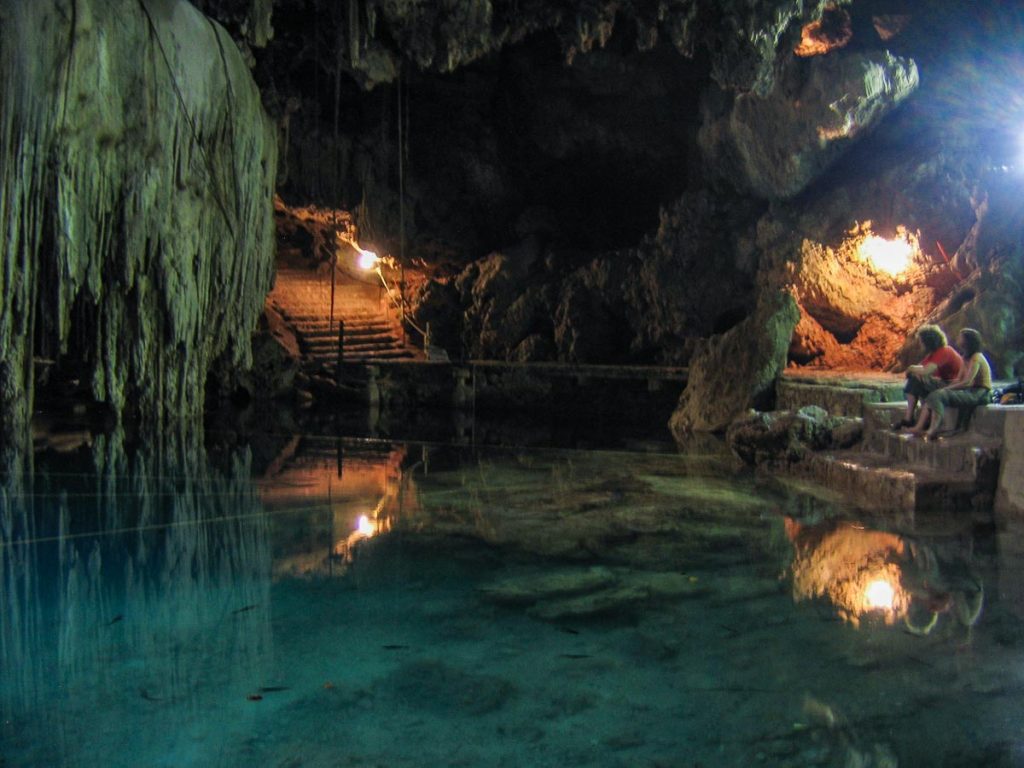
Cenote Dzitnup (Cenote Xkeken)
Submitted by Lori Sorrentino of Travelinmad
Although Valladolíd — or Pucela, as the locals call it — is famous for its many historic sites, it’s also known for one of the most unique cenotes on the Yucatan Peninsula — Cenote Dzitnup, also known as Cenote Xkeken.
In Cenote Dzitnup there is very little natural light other than what streams in through the hole in the ceiling. Because of this, and the number of people visiting the cenote, it is also artificially lit.
Inside, the crystal-clear turquoise water reflecting the stalactites and the long tree roots eerily dangling from the ceiling of the cave is what attracts visitors far and wide. And due to its rather closed environment, the air inside can sometimes get hot and humid. So it’s not surprising that swimming in the refreshing cool water has become so popular that there’s now even a lifeguard on duty.
Outside near the parking lot you’ll find food vendors selling cold drinks, snacks, small souvenirs, and serving up local Yucatan food specialties. Don’t pass it up — there’s always something delicious and it tastes so good after a swim!
Address: On an unnamed road in Dzitnup, Yucatán, Mexico
How to Get There: Drive or take a bus or taxi from Valladolíd; it’s six miles southwest of the city.
Hours: Daily, 8:00 AM-7:00 PM
Admission: 59 pesos ($3 USD)
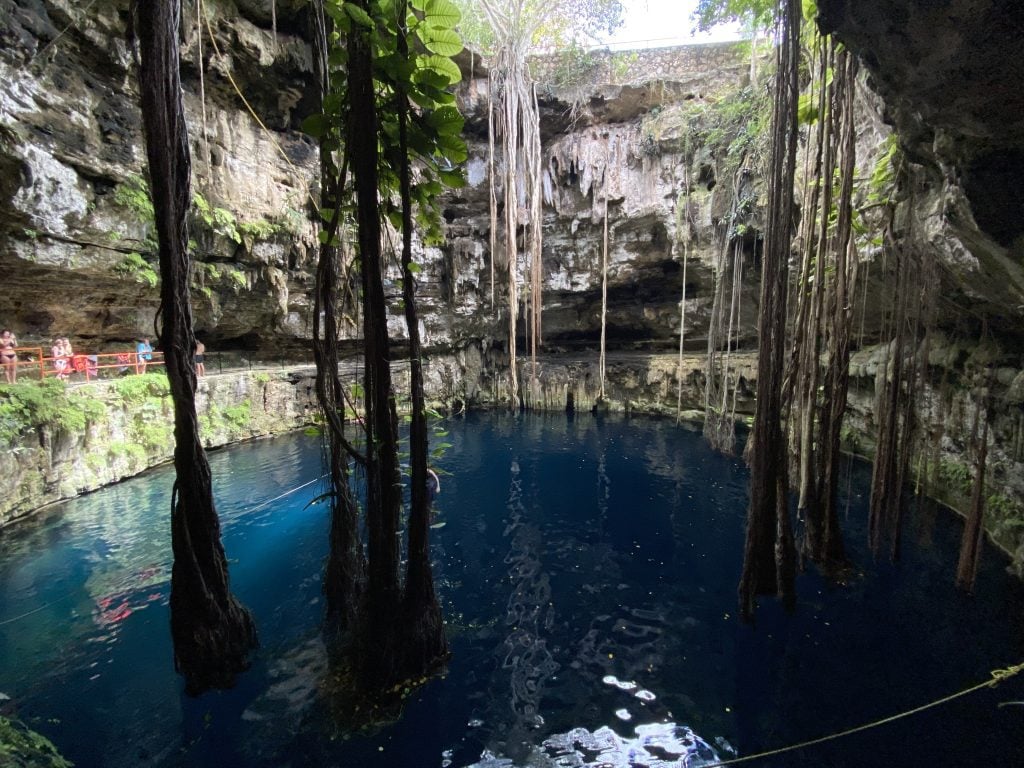
Cenote Oxman
Submitted by Kate of New Hampshire Way
The Valladolíd area is rich with cenotes, and you have so many good ones to choose from! One of my absolute favorite cenotes in the Yucatán is Cenote Oxman, part of Hacienda Oxman (sometimes called San Lorenzo Oxman).
Hacienda Oxman was once an agave plantation dating back to the 18th century. Today, people come here to enjoy a day of relaxation and fun, with the cenote, pool, restaurant, areas with hammocks, and more. The restaurant makes terrific ceviche!
The cenote itself is a cave cenote, where you descend a long staircase to the water level. Several clusters of vines fall into the cenote, making it feel like a jungle escape. Best of all is the rope swing, where you can fly into the water like Tarzan!
Cenote may not be the most visually spectacular cenote, nor the largest, nor home to the best facilities — and yet it’s one of my favorite cenotes in Mexico. Why? What it does, it does extremely well, and the chilled vibe is second to none.
I visited Cenote Oxman after a visit to the Chichén Itzá ruins, which I highly recommend. It’s not the closest cenote to the ruins, but it’s much less crowded, and the resort caters to Mexicans rather than foreigners.
Address: Periférico, 97780 Valladolid, Yuc., Mexico
How to Get There: Drive, or take a taxi from Valladolid.
Hours: Daily, 7:30 AM-5:00 PM
Admission: 150 pesos ($7.50) for cenote entry alone — or 250 pesos ($12.50 USD) for cenote entry and 200 pesos ($10) worth of restaurant credit
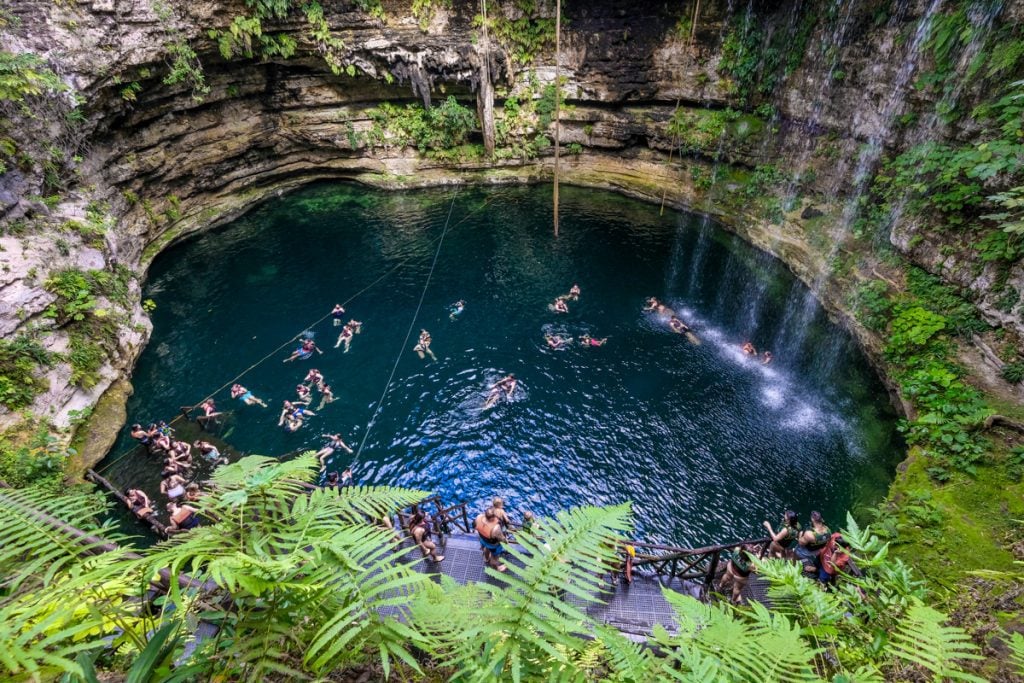
Cenote Saamal
Submitted by David & Intan from The World Travel Guy
Cenote Saamal is a nice natural sinkhole with a man-made waterfall, right outside the city of Valladolíd! It’s also a short distance from the famous Chichen Itza ruins.
Cenote Saamal has colorful clear blue water and a perfect circular shape, with an open ceiling and lots of green vegetation. Lifejackets are required to enter, and remember to shower beforehand too.
The Cenote Saamal is very popular with tour groups headed to Chichen Itza and Valladolíd, so it’s definitely not the most quiet cenote in Mexico, but you should still be able to experience it without the crowds if you come early in the morning or late in the afternoon.
There’s a restaurant and some shops above the cenote, where you can buy drinks, souvenirs, and other things. These shops are cash only, no credit cards.
If you happen to book a tour that includes this cenote, know that most tours already cover the entrance fee and a nice buffet meal at the restaurant above the cenote.
Address: Hacienda Selva Maya, Valladolid, Yuc., Mexico
How to Get There: Drive or take a taxi from Valladolíd; it’s just west of the city.
Hours: Daily, 9:00 AM-5:00 PM
Admission: 150 pesos ($7.50) to enter, 250 pesos ($12) for entry and a buffet
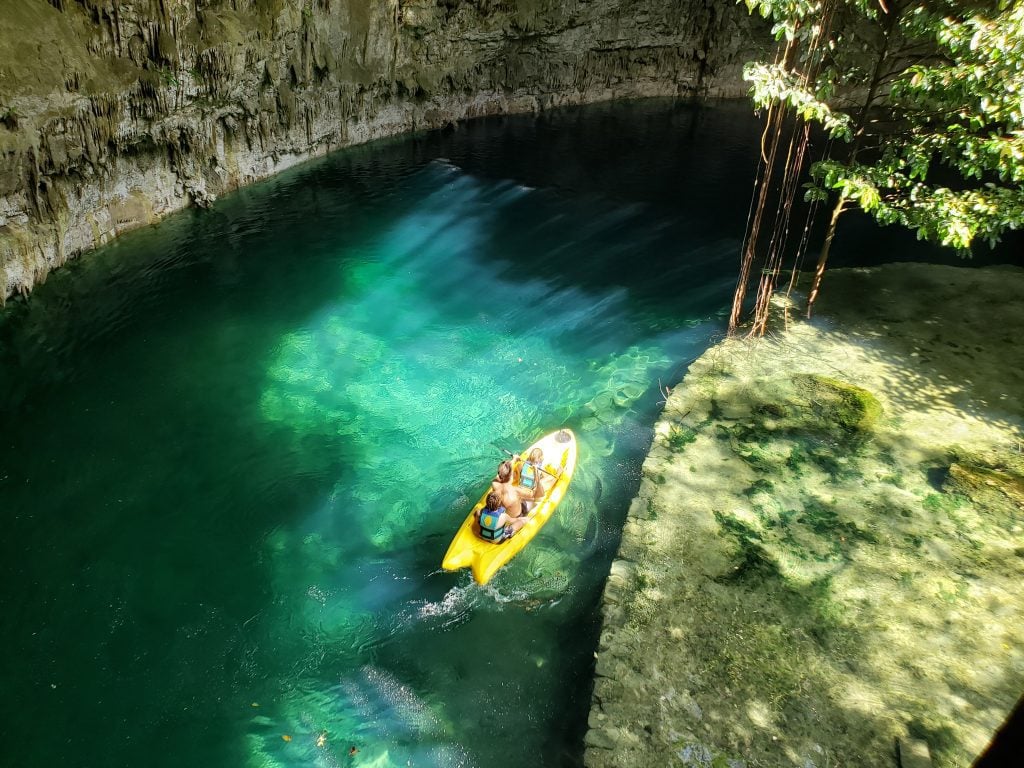
Cenote Sac-Aua
Submitted by Mexico Cassie, author of the book Yucatán with Kids.
Cenote Sac-Aua is one of my favorite cenotes on the peninsula. It’s a circular, deep, open cenote that feels like a cave since only the middle section of the roof is gone. When you’re in the water, whether swimming or kayaking, be sure to look up and marvel at the magic happening above your head. There is really nothing like the view of a clear blue sky framed by curving cave walls and spectacular trees.
Sac-Aua is also reputedly the only cenote with a natural island and trees growing in its centre. It is accessed via a sturdy staircase in the centre of the cenote. When I was there in mid-2021, the island was under water but it’s generally dry and accessible, perfect for people who don’t feel like swimming but do want to enjoy the experience of a deep cenote.
Just 30 km outside of Valladolid, in the village of Dzalbay, Sac-Aua is easily visited as a day trip and can even be coupled with a trip to the fabulous Maya site of Ek Balam. At $190 pesos entry this isn’t one of the cheapest cenotes but it’s rarely busy, has kayaks available and also has a dry cave that everyone can enjoy exploring.
Address: Dzalbay, Yucatán, on an unnamed road.
How to Get There: Driving is best; it’s 30 km outside Valladolid.
Admission: 190 pesos ($10 USD)
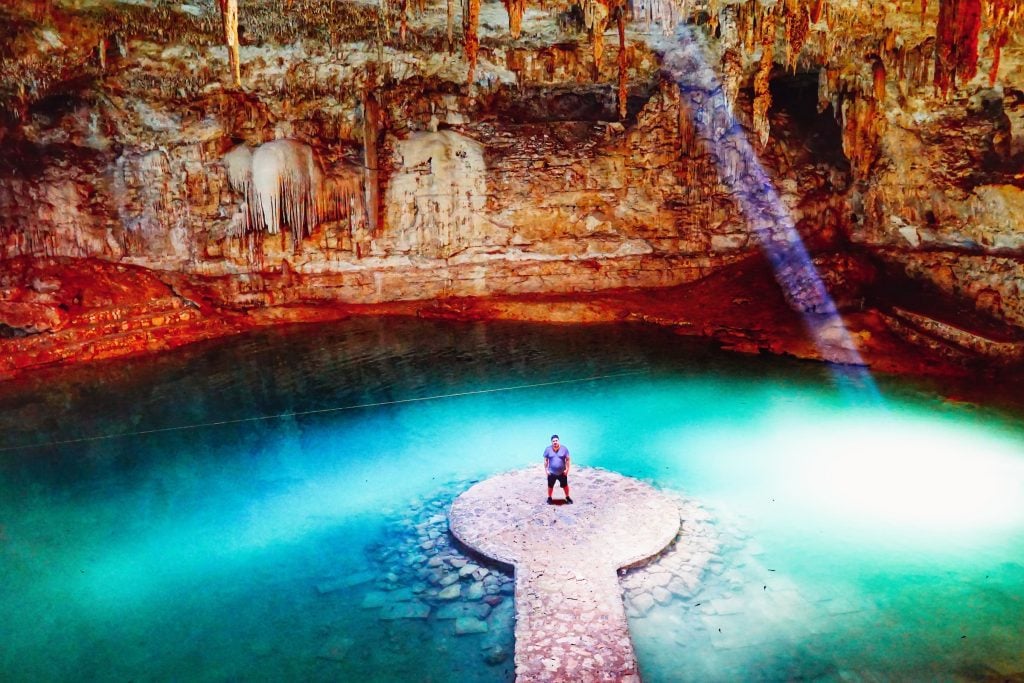
Cenote Suytun
Submitted by Nathan Aguilera of Foodie Flashpacker
Cenote Suytun, located just 5 miles east of Valladolíd, is one of the most recognizable cenotes in Mexico. Nearly every travel blogger or Instagrammer has made their way down the stairs to capture the photo for themselves.
Why is it so famous? The semi-open cenote has a man-made circular platform in the middle of its shallow basin that is perfect for Instagram photos!
If you arrive at the right time of day — roughly 12:00-2:00 PM — you can capture an even more dramatic photo as an opening in the roof of the cenote allows a beam of light to break through and illuminate the platform. But beware: this cenote is very popular and you won’t be the only one there at this time trying to get the same photo.
You can easily reach Cenote Suytun by car or colectivo. You can also go on an organized group tour, but I do not recommend this if you’re wanting the classic photo as it will be too crowded. In fact, if you see tour buses in the parking lots, it’s better to return later and time your entrance between tours.
Address: Carretera Ticuch Km 8 S/n, 97780 Valladolid, Yuc., Mexico
How to Get There: Drive, taxi, or colectivo, 5 miles east of Valladolíd
Hours: Daily, 9:00 AM-5:00 PM (last entrance at 4:00 PM)
Admission: 120 pesos ($6 USD)
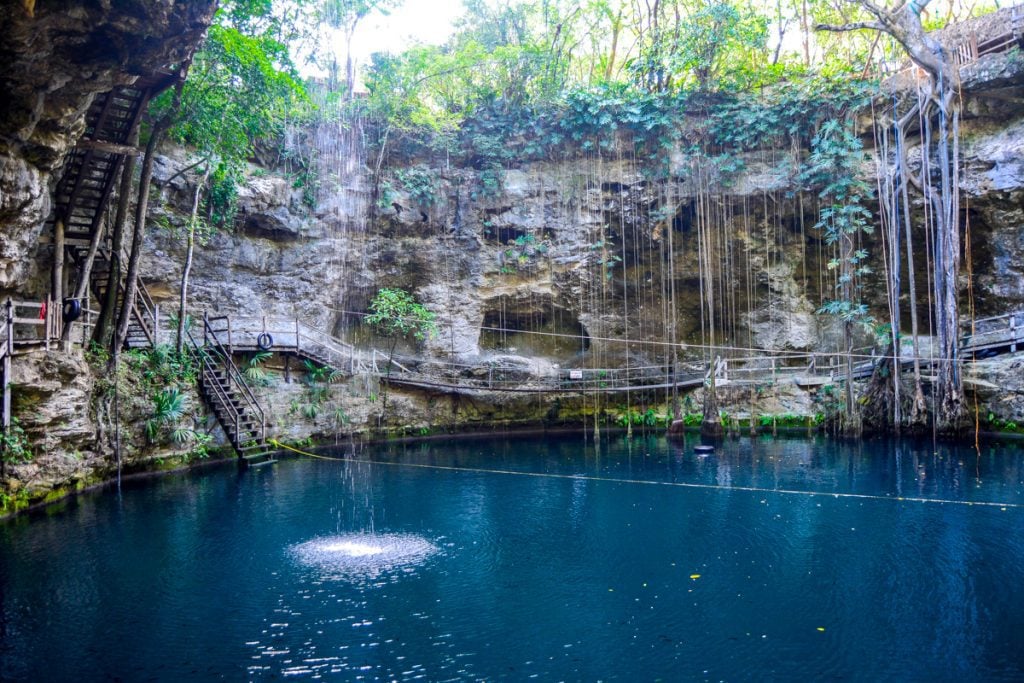
Cenote X’Canche
Submitted by Soumya Nambiar of Travel, Books & Food
Cenote X’Canche, also known as the Ek Balam Cenote, is a gorgeous open-air cenote and a must-visit during your Yucatán itinerary. It has a pretty tiny waterfall and is ideal for swimming, ziplining and even rappelling, all without the usual crowds found at most cenotes. On most days, you can find it practically empty since most people visit only the Ek Balam ruins without visiting the cenote.
You can easily spend half a day here and at the ruins, just 30 minutes from Valladolíd.
Once you get to the parking lot, there is a ticket counter with a restaurant, a few shops and bathroom facilities. There is a separate entrance for the cenote and once you enter, there is a 2 km walk each way. If you do not want to walk, you can rent a bike taxi, which is approximately 150 pesos ($7.50 USD) and includes the entrance fee for the cenote.
If you plan to zipline or rappel, please look at spending at least 400 pesos ($20 USD) including the bike taxi and the entrance fee. Parking is free, but you may have to tip the kids in the parking lot for watching over your car if you plan to drive there.
It is mandatory to shower before swimming. And there are changing rooms and showers right next to the cenote as well. Sunscreens are banned in this cenote as well.
For an ideal day here, look at spending around 2-3 hours exploring the ruins followed by around 1-2 hours swimming and having fun at the cenote.
Address: Ek Balam, Yucatán, Mexico
How to Get There: Driving is best.
Hours: Daily, 8:00 AM-4:00 PM
Admission: 70 pesos ($3.50 USD); visiting the ruins is an additional 413 pesos ($20 USD); extra for ziplining and rappelling
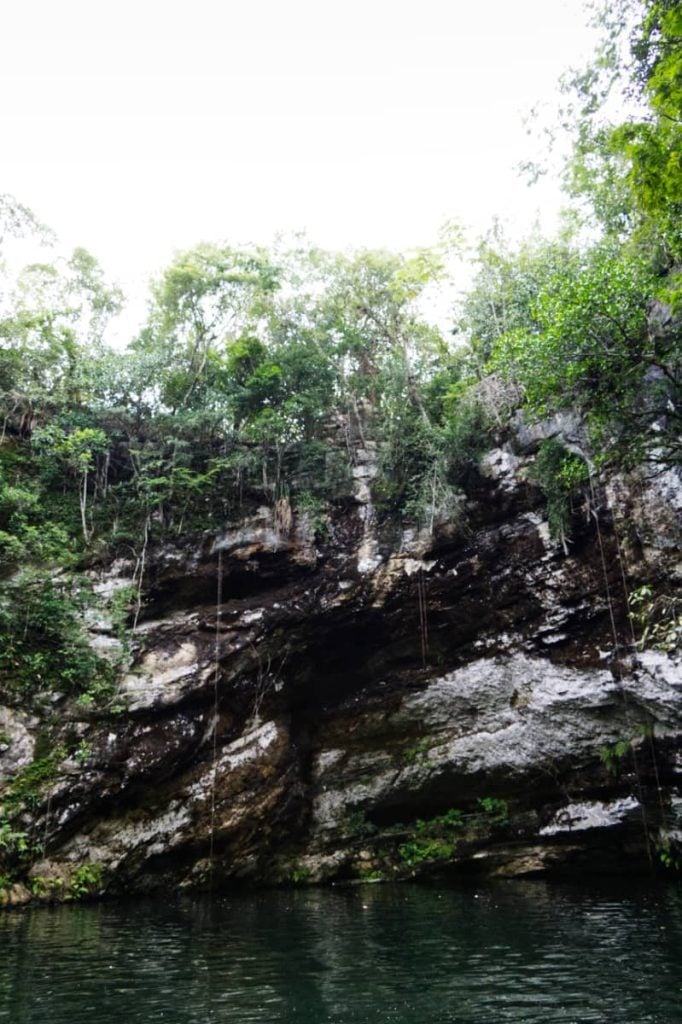
Xlakaj Cenote
Submitted by Julien Casanova
Take a drive 15 minutes south of Valladolid, just past Chichimila, to explore one of the Yucatan’s lesser known cenotes, Xlakaj. Entering the cenote is relatively easy. After paying the 50 pesos entry fee required of foreigners, park, and descend the wide stairs that lead you directly into the large open cenote surrounded by a tall rock cliff.
The water is clear, refreshing, and teeming with small fish. Plant life abounds along the limestone rock circling the breadth of the cenote. The enchanting atmosphere feels as if you’ve discovered a special place, tucked away from the rest of the world.
The land around Xlakaj Cenote was built as a “bioparque” with a swimming pool, restaurant, and cabanas but don’t count on those being open these days. Instead, focus on the cenote. Go for a refreshing swim, relax, and return to the town of Valladolíd, which is a great base to explore the many Mayan Ruins and cenotes of the Yucatan.
For the more adventurous, the cliff at Cenote Xlakaj also offers places to jump into the cenote from both 20 and 60 feet high. With its remote feeling despite the proximity to Valladolíd, you’ll feel like you’ve discovered something special.
Address: Unmarked road in Chichimila, Yuc., Mexico
How to Get There: Drive or take a taxi 15 minutes south of Valladolíd
Hours: Daily, 10:00 AM-5:00 PM
Admission: 50 pesos ($2.50 USD)
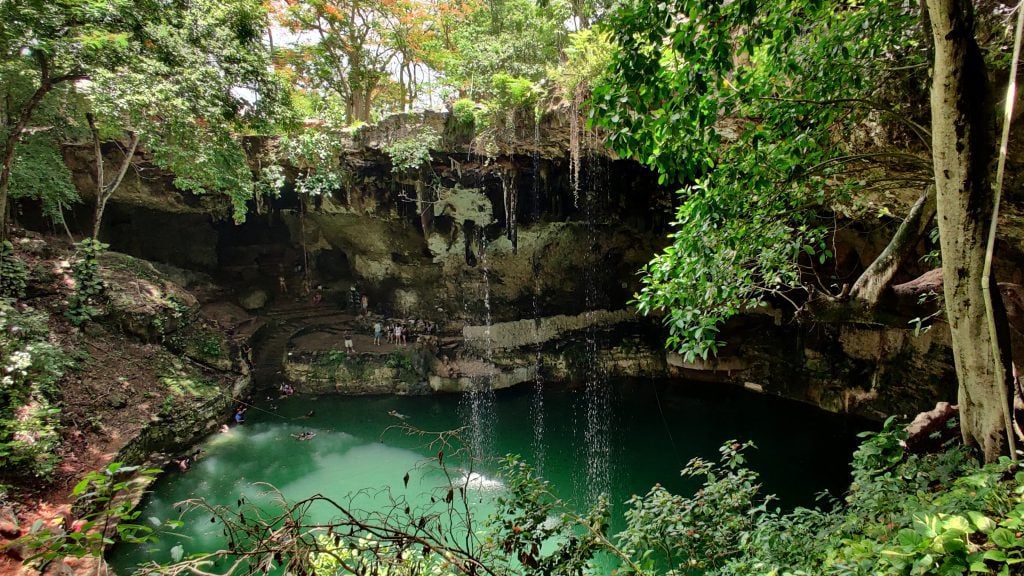
Cenote Zaci
Submitted by Zoe of Zoe Goes Places
Among the many cenotes across the Yucatan peninsula, Cenote Zaci is still unique by being located in the very heart of Valladolíd. Despite being just three blocks from the city’s main square, a visit to Cenote Zaci will leave you feeling like you’ve been transported to the middle of the jungle.
This semi-open cenote features a waterfall over the remaining cave top, lots of fish and up to 100-meter-deep water! Plus, if you’re feeling daring, you can even jump in from an eight-meter platform. Though don’t worry, steps are available too!
It takes just 10 minutes to reach the cenote by foot from the central square. Free parking is available on the nearby streets and in the small parking lot on-site. You’ll find the cenote on Calle 36, on the block between Calle 37 and 39.
Entrance costs just 30 pesos per person, with life jacket rental costing another 30 pesos per person. Additionally, there is a restaurant on-site and if you spend 100 pesos per person you get free entry to the cenote. Lockers are also available. Though the cenote is currently closed for renovations (as of January 2022), it is expected to reopen soon.
Address: Calle 36, Sta Ana, 97780 Valladolid, Yucatan, Mexico
How to Get There: It’s right in the heart of downtown Valladolíd. You can’t miss it.
Hours: Daily, 9:00 AM-5:00 PM
Admission: 30 pesos ($1.50 USD)
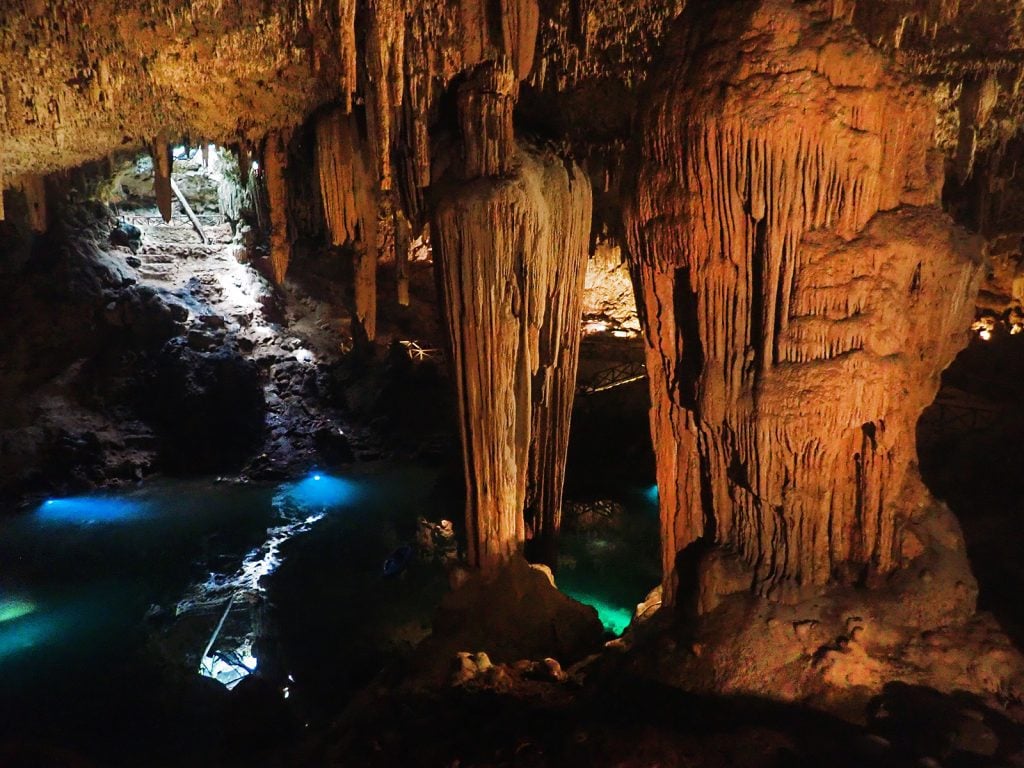
Cenote Zazil Tunich
Submitted by Paulina of UK Everyday
Zazil Tunich Cenote is a very spiritual place. As soon as you enter a sacred cave, a shaman will give you a blessing to swim in crystal clear water. You will feel like exploring a completely different world. Lovely illumination, incredible rock formations and well maintained wooden pathway will make you fall in love with this magical cenote.
The best way to get to Zazil Tunich Cenote is to drive. Another option is to buy a Chichen Itza and Cenote Zazil Tunich tour that will allow you to explore two amazing places the same day.
To avoid crowds, visit the cenote during the week. However, if you want to experience the Mayan Ceremony, you need to book your ticket for Friday, Saturday or Sunday.
Zazil Tunich is just 40 minutes drive from Vallladolid. However, you have to book your visit in advance as there are only three group entries per day. The tour includes dinner, Mayan ceremony of purification and swimming in crystal clear waters of cenote.
Zazil Tunich’s incredible stalagmites and stalactites are the largest in Yucatan. These formations reminded me so much of Drogarati Cave in Kefalonia, as well as about the fact that stalactites grow very slowly, just 1 cm every 100 years.
This incredible cenote will offer you once in a lifetime experience. For example, you can book an exclusive romantic dinner 20 meters underground. It is a great location for special events such as engagements as well as cooling off after exploring Mexico on extremely hot days.
Address: Km. 6 , Carretera Yalcobá-Xtut Yalcoba, 97794 Yalcoba, Yuc., Mexico
How to Get There: Driving is best.
Hours: Daily, 1:00 PM-7:15 PM
Admission: $45 USD, including dinner, the Mayan ceremony, and free time to swim
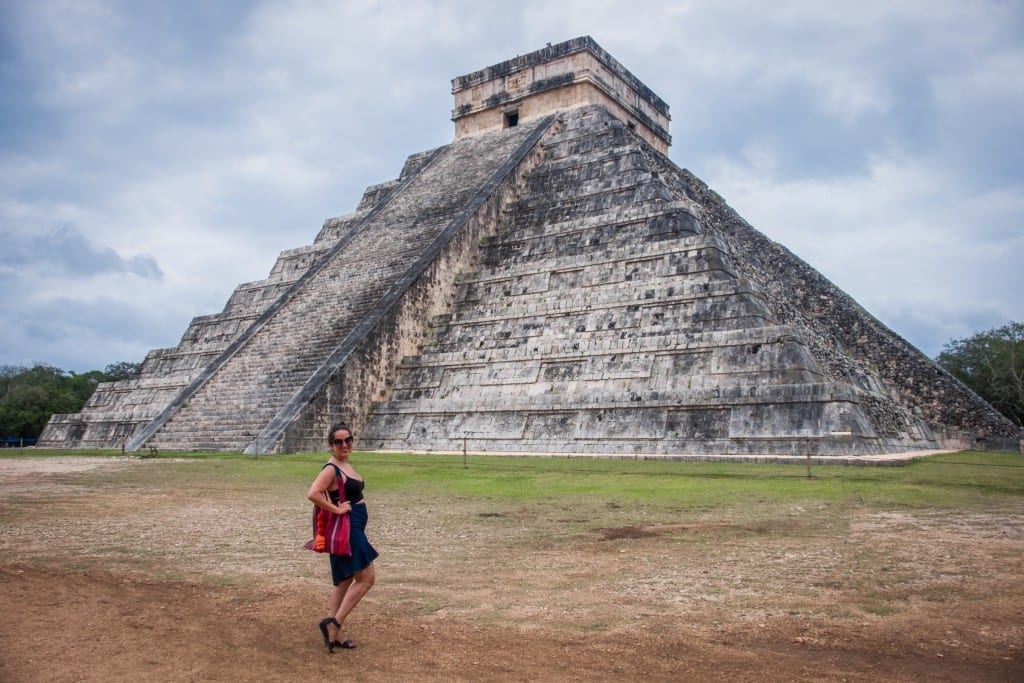
Cenotes Near Chichen Itza
The Chichén Itzá ruins are one of the most popular places to visit in the Yucatán. These striking ruins are home to some of the largest pyramids in the Yucatan.
Chichén Itzá has limited shade, which means it’s often a hot and sweaty experience. One of the best things to do afterwards is to cool off in a cenote! And there are several nearby, like Cenote Ik Kil. Though don’t overlook the cenotes near Valladolid — I actually prefer going to Cenote Oxman after Chichén Itzá.
One BIG tip: don’t go to Chichén Itzá on a Sunday. Sundays are free for all Mexicans and it’s tough to find parking.
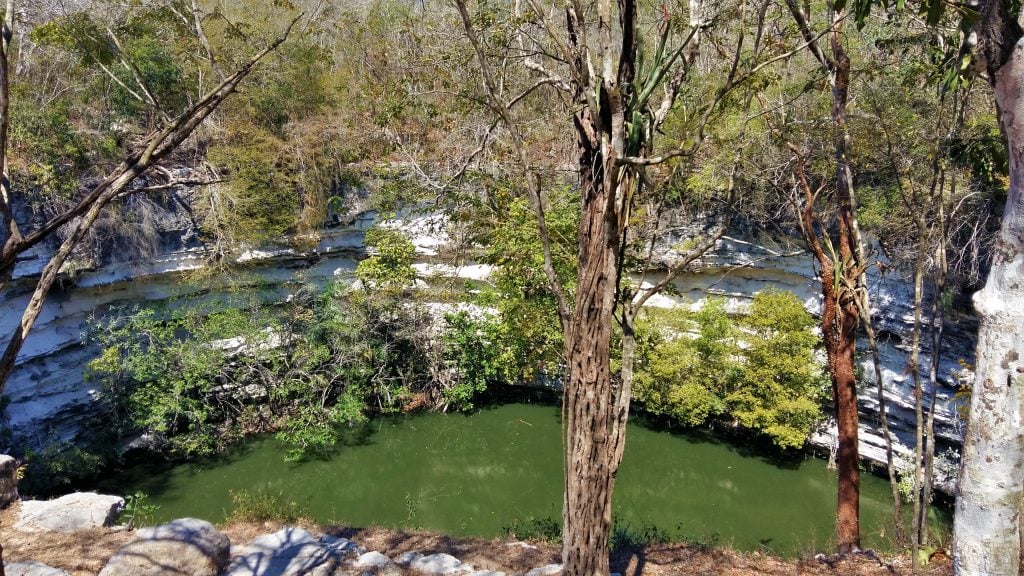
Sacred Cenote of Chichén Itzá
Submitted by Claire Sturzaker of Tales of a Backpacker
Cenotes were a vital water source for the Maya, so they needed to make sure they had access to water in their cities. There are four open cenotes actually inside the Chichen Itza archaeological complex, the largest one being the Sacred Cenote. Unlike most of the cenotes in the Yucatan, you can’t swim in the Chichen Itza cenotes.
The Sacred Cenote is 60 meters wide, with steep walls surrounding the green water. At the bottom of the Sacred Cenote, archaeologists have discovered a range of objects that suggest the Maya made offerings to their gods, in particular the rain god Chaac.
Artefacts of gold, jade, copper, pottery, wood and textiles have all been found, the wood and textiles preserved by the water. They also found human skeletons of men, women and children who originally came from all across Mexico and Central America.
It is estimated that some 200 human sacrifices were thrown into the cenote — it’s not known if they were dead or alive when they hit the water, although recent research suggests that most were already dead.
As well as the Sacred Cenote, archaeologists recently discovered that the main pyramid at Chichen Itza, El Castillo, is built over the top of an underground cenote, which could have also had major religious significance for the Maya given that they built their temple above it. The research continues!
Address: ChichénItzá, Yucatán, Mexico
How to Get There: There are countless tours to Chichén Itza from destinations all over the Yucatán peninsula. You can also visit independently by car or bus.
Hours: Daily, 8:00 AM-4:30 PM
Admission: 497 pesos ($25 USD) for entry to the whole complex
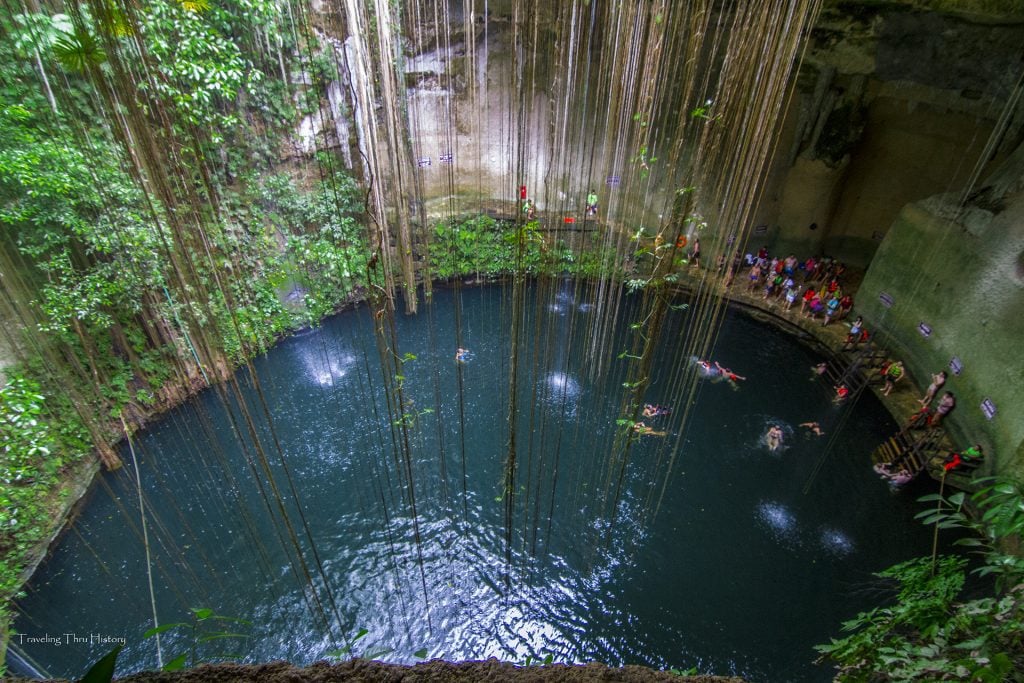
Cenote Ik-Kil
Submitted by Erin Tracy of Traveling Thru History
Ik Kil Cenote is an underground semi-open sinkhole just outside the ruins of Chichen Itza. There is a tunnel staircase that leads down to the water which affords stunning views of the water as you descend. This cenote is open to the sky and has hundreds of beautiful vines hanging down from the foliage above.
You can enter the water using a short wooden ladder or by climbing some stairs to a platform before jumping into the water. Be aware that this cenote is about 150 feet deep. Due to the depth of the water and only having one exit point from the water, inexperienced swimmers and those with young children should exercise caution when visiting this cenote.
One of the reasons this cenote is so popular is because of the amenities. There are lockers, showers, towel rentals, life vest rentals, and two restaurants on-site. There are open-air showers in front of the lockers which visitors are required to use before descending to the cenote.
Be sure to bring shoes with a solid grip as the stone stairs can be a bit slick. If you decide to purchase food from either of the restaurants before descending to the cenote, be sure to finish your meal since no food or drink is allowed past the cenote entrance.
Address: Unmarked road just east of the Chichen Itza ruins
How to Get There: Drive or take a taxi, or join one of the many tours.
Hours: Daily, 8:00 AM-5:00 PM
Admission: 80 pesos ($4 USD)
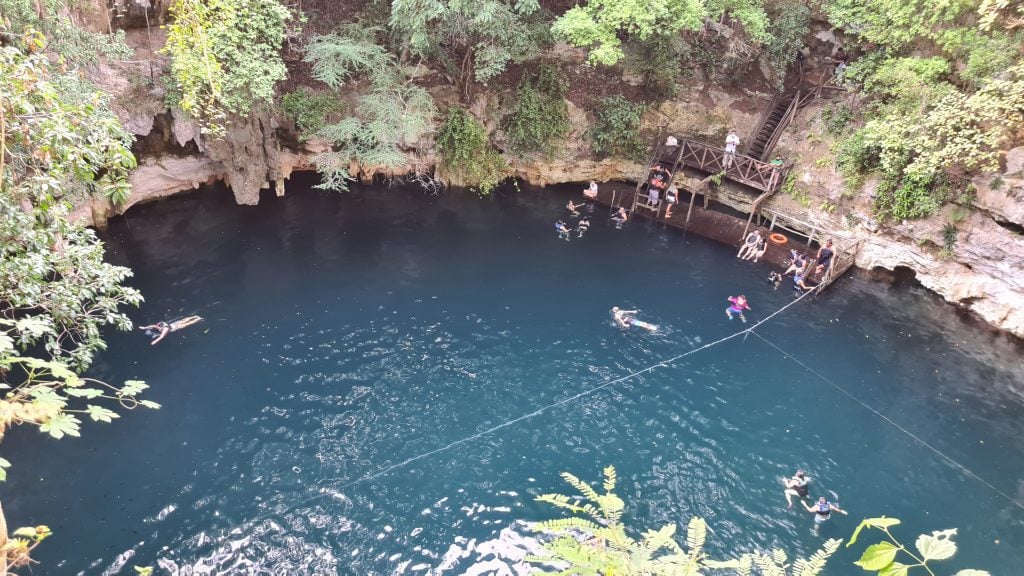
Yokdzonot Cenote
Submitted by Noel Morata of Travel Photo Discovery
If you are visiting places around Merida and looking for fun adventure outside, consider visiting some of the amazing cenotes or sink holes in the region. One of the fun ecotourism cenotes to visit in the area is called Yokdzonot Cenote in central Merida.
What makes this cenote unique, outside of the gorgeous limestone cliffs and vine draped greenery that surround the aqua colored pools? You can do other things here, like taking a cooking class or even do a zip line tour in the forest areas of the jungle landscape surrounding the cenote.
The wonderful thing about this cenote is that it is operated by a local co-op that benefits the local community in the small pueblo town of Yokdzonot, Yucatán. All proceeds from the entrance fees, cooking class, restaurant and zip line tours go directly into the community fund of the local pueblo, which is a fantastic way of supporting every aspect of the community commerce and employment.
The cenote park primarily employs mostly women from the community that help to operate the cenote grounds, tours, and restaurant, keeping the whole concept of local, eco-friendly and natural travel (plus fantastic trails and local Yucatan food).
Address: Calle 20 s/n, 97922 Yokdzonot, Yuc., Mexico
How to Get There: Driving is best — it’s just west of Chichén Itzá.
Hours: Daily, 9:00 AM-5:00 PM
Admission: 125 pesos ($6) for entry, extra for cooking classes, zipline tours, etc.
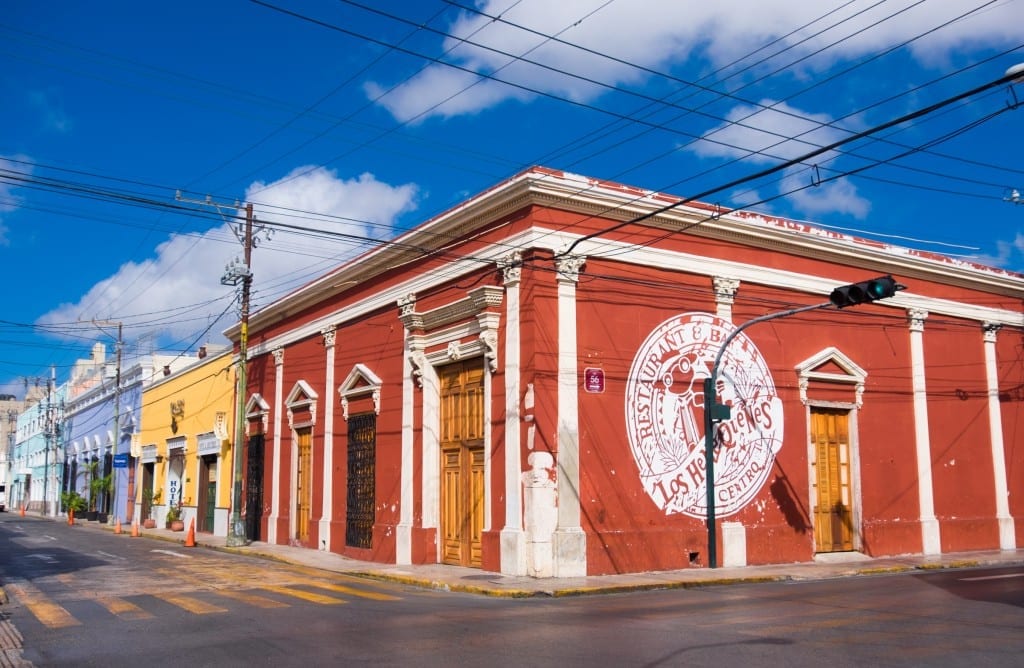
Cenotes Near Mérida
If you want to fall in love with a magnificent city in Mexico — a place with fantastic dining, gorgeous colorful streets, and exactly zero beach tourists — go to Mérida! I visited Mérida one winter and loved it so much, I came to live here the next winter!
The secret of Mérida is out by now, but that doesn’t stop it from being a fantastic place to visit. Mérida is also well located when it comes to cenote-hopping. Just outside Mérida is the cenote-rich town of Homún, where you can visit a resort like Cenotes Santa Barbara or hire a tuk-tuk driver to take you to wild cenotes few people have heard of!
I think Mérida is one of the best places in Mexico for day trips. If you have your own car, put together a day of the Mayapán ruins, the yellow city of Izamal, and a nearby cenote of your choice.
Would you rather go on a tour? Check out the tours listed below, or see the Cenote Tours in Mérida section.
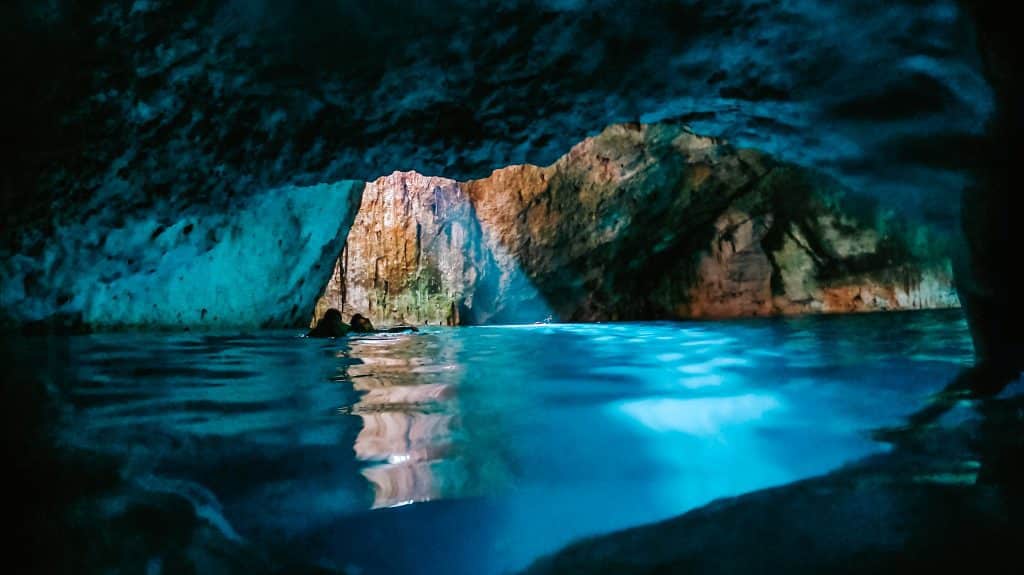
Nah Yah Cenote
Submitted by Cassie Goodluck-Johnson of Native Nomad Life
One of the most beautiful cenotes in the Yucatan peninsula is the largely unknown and gorgeous Nah Yah cenote. An hour drive southeast of Mérida, it is a perfect day trip to accompany an off-the-beaten-track cultural experience in the Mayan town of Pixyá with our friend and guide Lucia of Bonita Merida Experiences.
Driving down a white dirt road into the jungle, you approach this cenote. The narrow, steep stairs descend down into the large cenote, as your eyes adjust and you take in how far the cenote expands in all directions, including beneath.
Be sure to bring goggles or a snorkel as well as a life jacket if you need the extra support as there is nowhere to stand in this cenote unless you stay on the little dock at the base of the stairs.
As we swam into Cenote Nah Yah, what struck us the most was how beautiful the semi-covered cenote is when the light shines through the middle of the hole on top. Be sure to arrive in the late morning or early afternoon (no later than 12:00 PM) as this is the best time to take advantage of the position of the sun shining its beautiful rays straight down through the gorgeous, clear blue water. I truly felt like a mermaid!
One of the best surprises is the unassuming cave hidden along the back wall. We were thrilled to sit perched inside the cave admiring the beauty of this giant cenote with its grand ceiling.
Address: Off a dirt road north of Pixyá, Yucatán, Mexico
How to Get There: Best with a tour, or be ready to drive carefully down a rough road.
Hours: Daily, 8:00 AM-6:00 PM
Admission: 60 pesos ($3 USD)
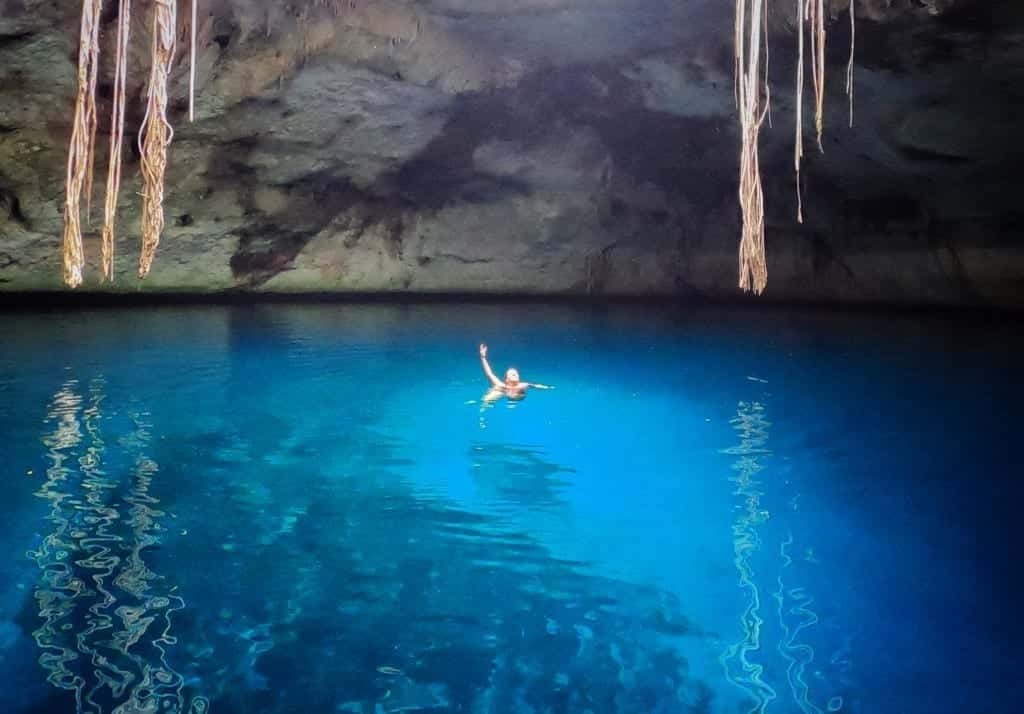
Cenote Noh Mozon
Submitted by Kate of New Hampshire Way
On the journey to Cenote Noh Mozon, you may be wondering what you’ve gotten yourself into. Once you reach the town of Pixyá, you turn onto a tiny dirt road full of uneven bumps and dips, driving slowly to avoid damaging your car.
It looks like there’s nothing out here. Dirt and dust, bedraggled trees. But eventually you come to a cenote with minimal facilities. An attendant takes your admission fee and you peer inside the massive crater to see the brightest, bluest shade of water you’ve ever seen.
I visited Cenote Noh Mozon on a rare overcast February day in Mérida. That did not detract from the color whatsoever. With vines hanging into the crater and shrieking flocks of birds flying around the edge in circles, it feels like you’ve discovered a place that very much did not want to be found.
Swimming in this cold, cool water is one of the best things you can do on a sizzling hot Yucatecan day. Some dive trip also come to Noh Mozon to enjoy the outstanding visibility beneath the surface.
If you’re going to visit any one wild cenote, I highly recommend Cenote Noh Mozon, arguably one of the wildest cenotes of all. It also pairs well with a visit to the Mayapán ruins.
Address: On a dirt road outside Pixyá, Yucatán, Mexico
How to Get There: Drive. You’ll want a quality car that can manage the bumpy road.
Hours: Daily, 9:00 AM-5:00 PM
Admission: 40 pesos ($2 USD)
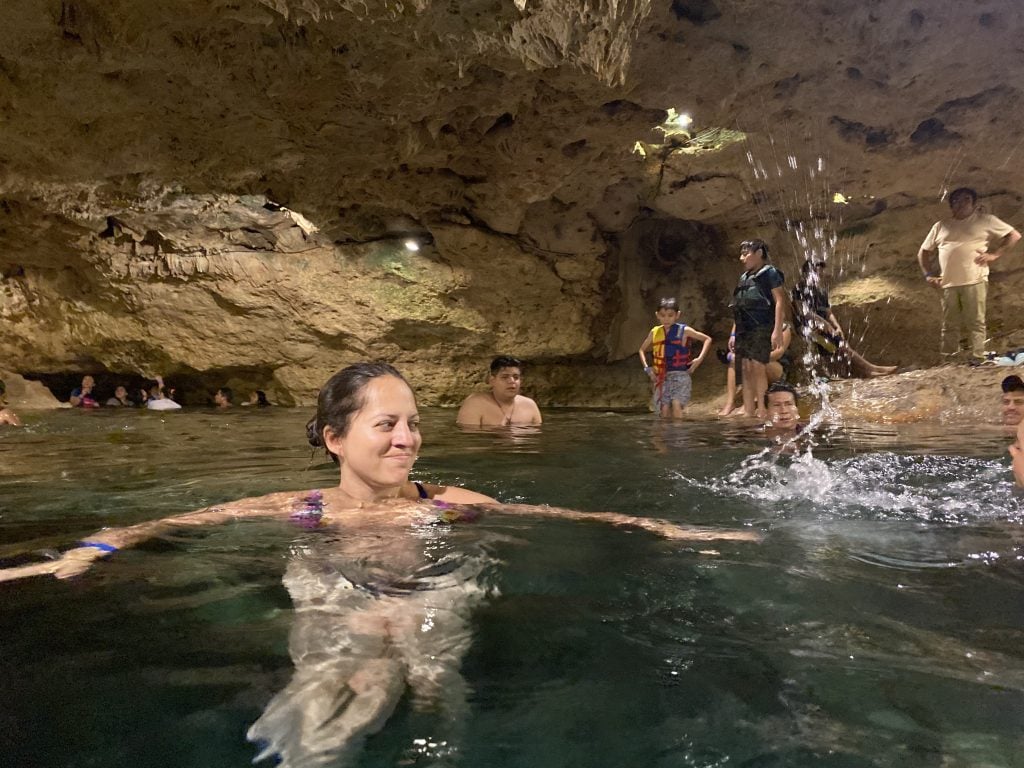
Cenote San Ignacio
Submitted by Kate of New Hampshire Way
Located just outside Mérida in the town of Chocholá, San Ignacio Cenote is a freshwater pool located inside a deep cave. Rather than the typical circular cenotes you’ve seen, this cave leads to an amorphous underground pool, with various depths and craggy ridges to hold onto.
Here you’ll find groups of friends crowding the various nooks, chatting and laughing with each other.
Cenote San Ignacio is part of a large, well-appointed boutique hotel complex, complete with a swimming pool, restaurant, and lounge areas.
Uniquely, Cenote San Ignacio is the only cenote complex in the Yucatán that gives you access at night.
And the restaurant is of particular note — you should prioritize having a meal here. The food is outstanding, and I had the best sopa de lima here that I’ve EVER had. (And I ate a TON of sopa de lima while living in the Yucatan!)
I visited Cenote San Ignacio on the way back to Mérida from the Uxmal ruins, which requires a slight detour but is well worth it.
Just know that this cenote gets very crowded on the weekends, which is compounded when the cenote itself feels on the small side. You may prefer going during the week. Just make sure you get that amazing soup for lunch!
Address: C. 23 126, Centro, 97816 Chocholá, Yuc., Mexico
How to Get There: Drive or take a taxi to Chocholá
Hours: Daily, 12:00 PM-10:00 PM
Admission: 170 pesos ($8 USD) for access to the grounds; 150 pesos ($7.50 USD) for Yucatecans with ID
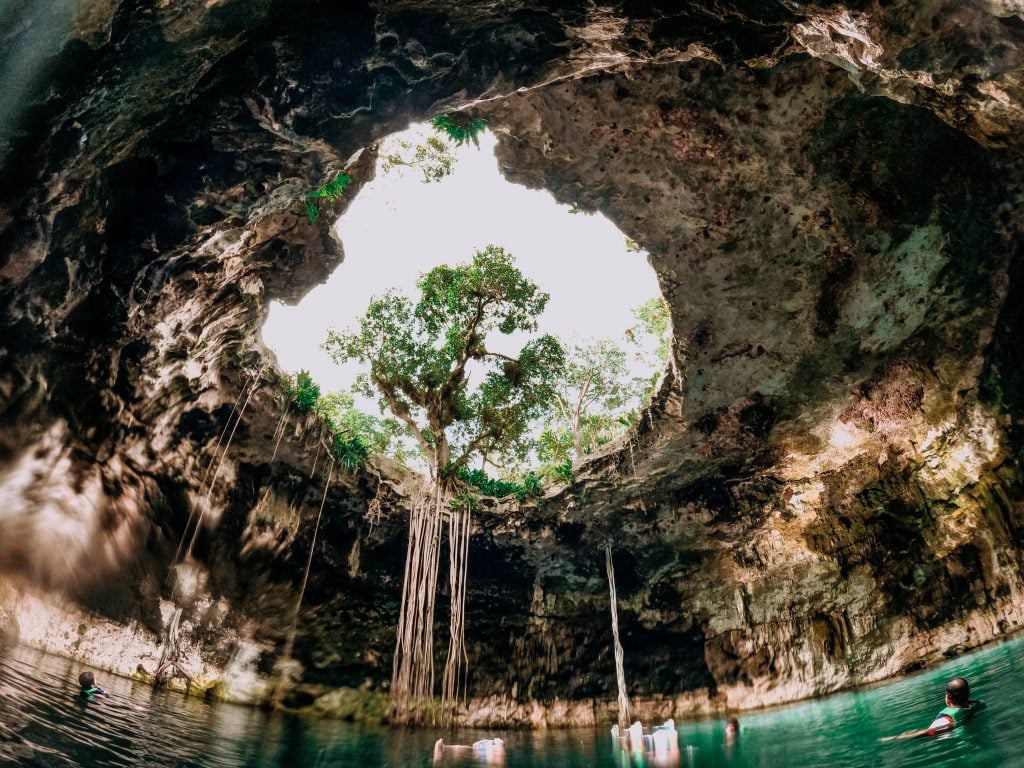
Cenote Santa Barbara
Submitted by Nate Goodluck-Johnson of Native Nomad Life
Santa Barbara Cenote is located an hour’s drive southeast of Mérida, Yucatán, in the small town of Homún, which is known for its abundance of cenotes. In this area there are many to choose from, but Santa Barbara definitely holds its own.
On the property of Santa Barbara, there are three cenotes (Cascabel, Chaksikin, Xoch) to visit. Along with access to the cenotes, your admission covers a lifejacket (which is mandatory) and a choice of three options for transportation: walking, biking, or horse-drawn carriage.
There are three different types of cenotes in the Yucatan: cave, semi-open, and open. Each of the cenotes has its own unique charm and adventure. One of the draws of going to Santa Barbara is that you can visit all three in one trip.
Cenote Cascabel: This is a closed-type cenote, using artificial lights to illuminate the cenote’s beautiful blue water.
Cenote Chaksikin: This is a semi-open type cenote with a large wooden staircase that leads down to the platform that is surrounded by the water. You can jump or swing into the cenote from the platform or gently lower down using one of the semi-submerged ladders.
Cenote Xoch: The last cenote on the property is an open sky-type cenote and is approximately 40 meters deep. Entering down a manmade, carved-out stairway and through a tunnel in the cliff wall, you will see the reflection of the circle of the sky in the crystal blue waters with trees surrounding the circular opening to the outside world.
Want to go with a group? This Airbnb Experience takes you to the Santa Barbara cenotes and possibly a few extras if you have the time.
Address: YUC 10, 97580 Homún, Yuc., Mexico
How to Get There: Drive or take a colectivo from Mérida to Homún.
Hours: Daily, 9:00 AM-5:00 PM
Admission: 150 pesos ($7.50 USD)
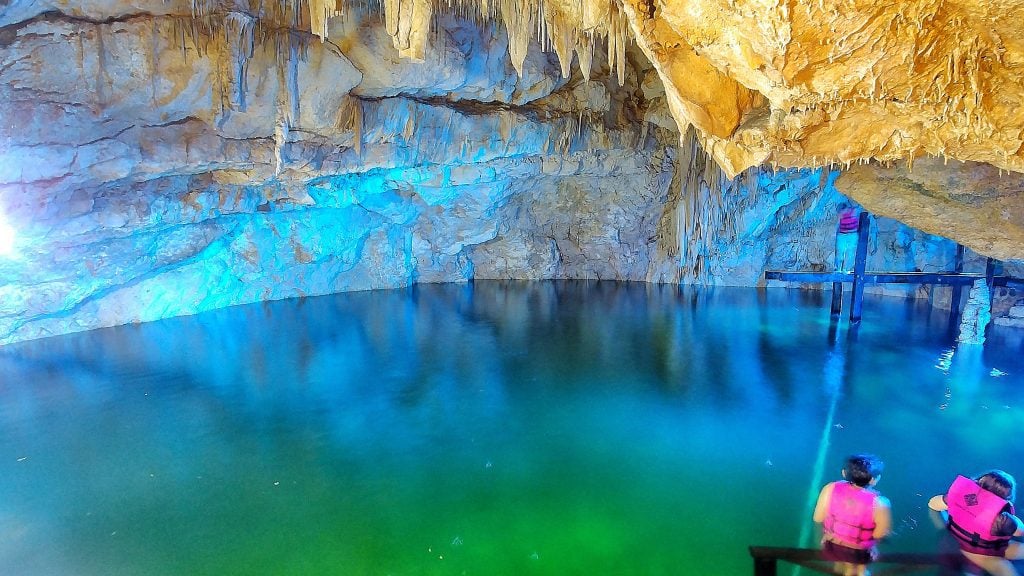
Cenote Santa Rosa
Submitted by Chris of Punta Cana Travel Blog
Cenote Santa Rosa is an off-the-beaten track cenote in Homún, close to Mérida. It is by far not as famous as the neighboring Cenotes Santa Barbara (just 5 minutes walking away) or the Cenotes Cuzamá. However, you are also getting rewarded with a less touristy experience compared to other famous cenotes in Yucatán.
Cenote Santa Rosa is a completely closed cenote, also known as an underground or subterranean cenote. There is no daylight in the cave, but the cenote is illuminated, allowing for some good photo opportunities.
Inside the cenote there is hardly any place to stand except a small wooden platform, so if you are going to visit Cenote Santa Rosa, you definitely should be willing to swim. Furthermore, you shouldn’t be claustrophobic, as the way down to the cenote is super narrow but impressive. Once arrived, you get rewarded by beautiful cave views and a refreshing swim.
Besides the cenote, you can enjoy a well-maintained garden, spacious outdoor areas, showers, restrooms and a local restaurant.
Address: C. 30-A, 97580 Homún, Yucatán, Mexico
How to Get There: Drive, taxi, or take a colectivo to Homún from Mérida. Alternatively, take a colectivo to Cuzamá and a tricycle taxi to Cenote Santa Rosa (departs more often).
Hours: Daily, 9:00 AM-6:00 PM
Admission: 50 pesos ($2.50 USD)
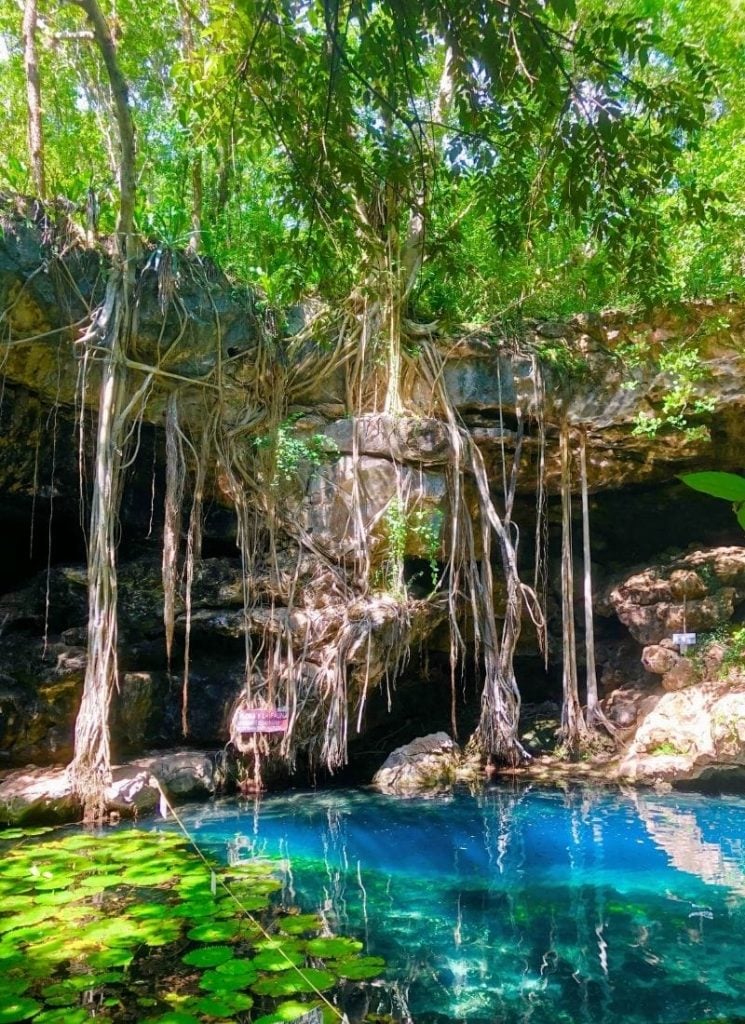
Cenote X’Batun
Submitted by Shelley of Travel Mexico Solo
One of the best off-the-beaten-path Mérida cenotes is Cenote X’Batun. It is also one of the most beautiful cenotes in Mexico, with bright blue water and hanging vines that make it look like a tropical paradise. With these lesser-visited cenotes, you may have the whole place to yourself; especially on a weekday.
Located in San Antonio Mulix, a remote Yucatan pueblo, the best way to get there is by renting a car in Mexico and driving. There are other cenotes in San Antonio Mulix, Mexico, like Cenote Hacienda Mucuyche, Cenote Dzonbakal and Cenote Yaal Utzil, so you can have a whole cenote day! Beautiful Hacienda Yaxcopoil is also not too far away.
There isn’t much in the way of facilities at Cenote X’Batun, so come with your bathing suit on and some snacks in the car. There is an outdoor shower, which you’ll have to rinse off in before entering. Admission gets you into both Cenote X’Batun and Cenote Dzonbakal, located underground in a cave.
Address: Carr. cenotes, San Antonio Mulix, Mérida, Yuc., Mexico
How to Get There: Driving is best. It’s about one hour from Mérida.
Hours: Daily, 8:00 AM-5:00 PM
Admission: 100 pesos ($5 USD)
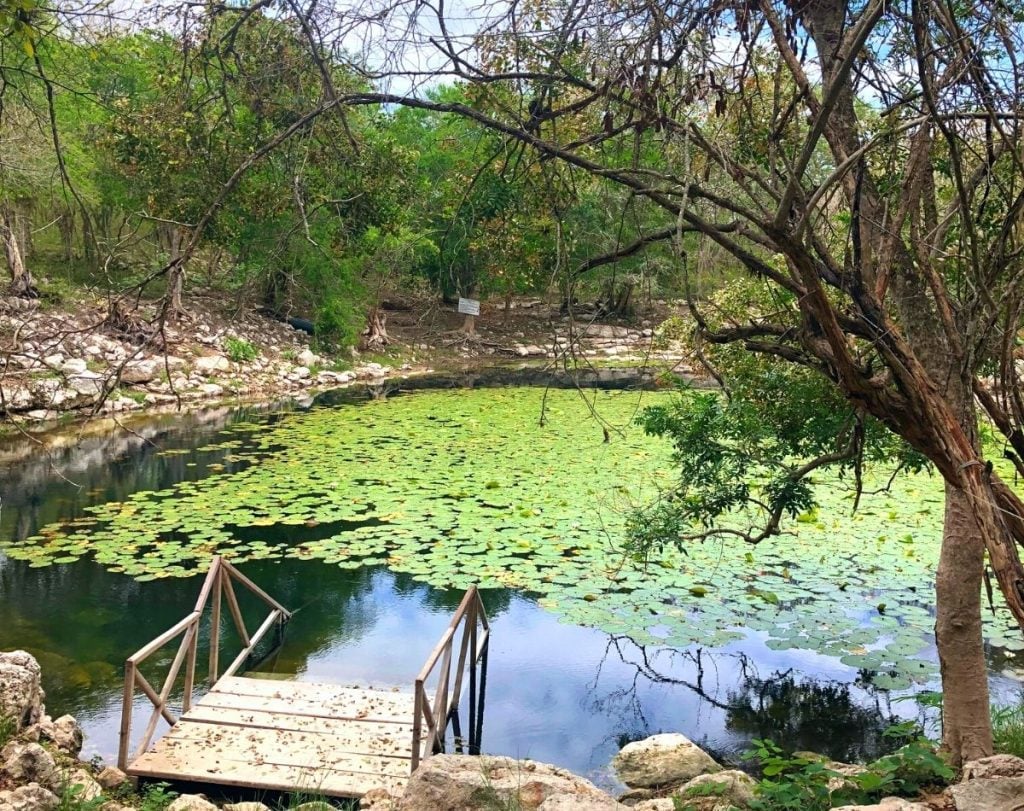
Cenote Xlacah
Submitted by Shelley of Travel to Merida
You’ll find Cenote Xlacah at Dzibilchaltun Ruins, the closest Mayan Ruins near Mérida, Mexico. Your admission to the cenote is included with the cost of admission to the ruins, so just bring a bathing suit when you visit Dzibilchaltun.
The Dzibilchaltun (zee-bee-shall-tune) site isn’t huge, but there are pyramids and ruins you can climb, a museum and sculpture garden. The museum and garden have artifacts discovered during Dzibilchaltun excavations and excavations conducted at other Mayan ruins.
After checking out the Dzibilchaltun Ruins, head to the restrooms and change into your bathing suit for a refreshing swim in Xlacah Cenote. This is what’s called a “swimming pool” cenote, or open cenote. Unlike the cave cenotes, there’s nothing overhead above the water, and you’ll get into this Cenote Xlacah the same way as you’d enter a swimming pool.
The water near the edges of this cenote is shallow. For visitors who don’t swim or aren’t comfortable swimming, just hang out in the shallows by the sides and enjoy the refreshing waters. Cenote Xlacah has clear water, so you can see the plants, small fish and even an occasional turtle swimming below you. It’s a great cenote to bring a mask and snorkel, so you can swim around and enjoy the underwater views.
Address: Zona Arqueológica de Dzibilchaltún Dzibilchaltún, 97305 Mérida, Yuc., Mexico
How to Get There: Driving is best. It’s about 45 minutes from Mérida.
Hours: Daily, 8:00 AM-5:00 PM
Admission: 227 pesos ($11 USD)
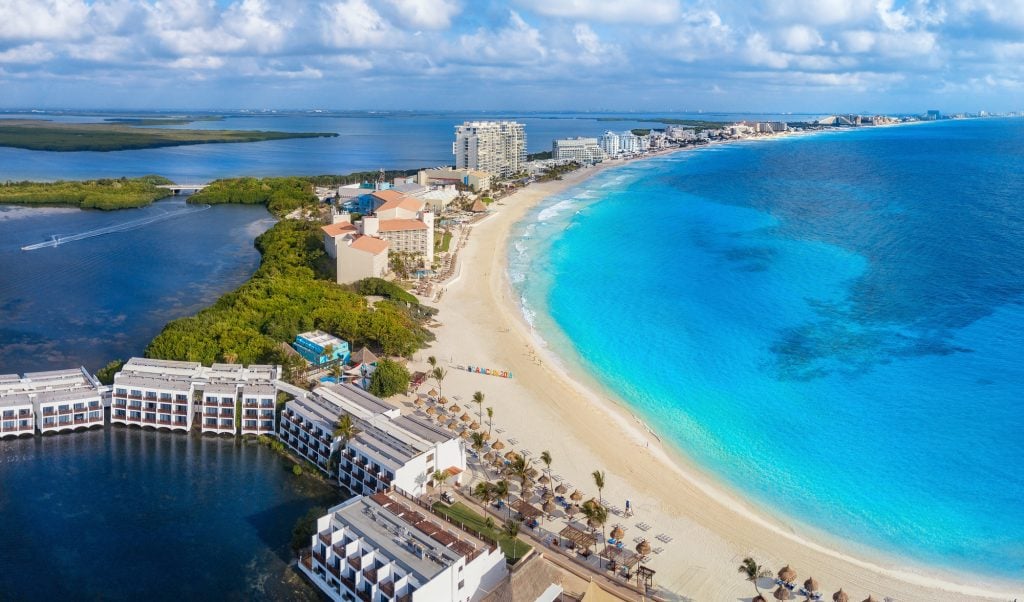
Cenotes Near Cancún
The city that started it all! White sand beaches on one side, a lagoon on the other, the largest city on the Yucatán Peninsula, and one of the top beach vacations from east coasters during the winter.
It’s easy to feel isolated from local life in Mexico when you’re staying in the Zona Hotelera, which exists only for tourists, but getting out to cenotes is one of the best ways to see the natural side of the country.
If you’re looking for cenotes near Cancún, most of them are down south closer to Playa del Carmen. I recommend browsing that section. Below are some top-recommended cenote tours from Cancun.
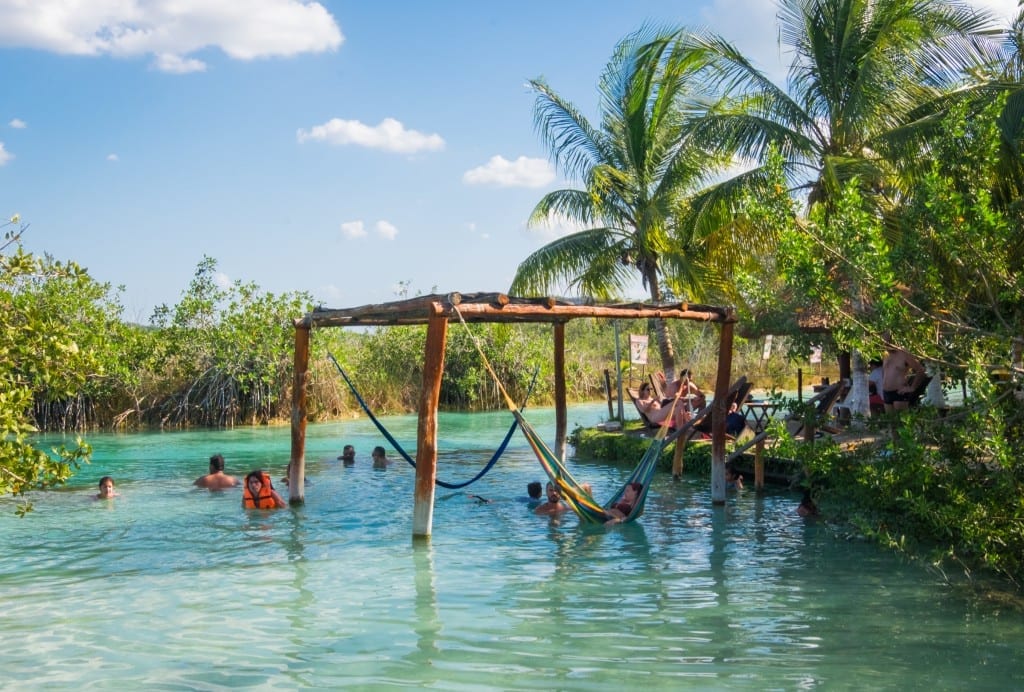
Cenotes Near Bacalar
If you’re looking for a natural wonder in Mexico that will blow your mind, you need to check out Bacalar. This is one of my all-time favorite places in Mexico!
Located in southern Quintana Roo, close to the Belize border, Bacalar is home to Laguna Bacalar — a lake of seven colors. Taking a boat out on the lake is one of the best ways to enjoy this incredible place to visit.a
Bacalar is home to a few cenotes, including its own Cenote Azul, and the Cenote Negro. Some of Bacalar’s cenotes are actually part of the lake itself — the only way you can tell is the difference in color.
Trust me, if you visit Bacalar, you will not regret it. Stay for two nights minimum.
Read More: The Ultimate Guide to Bacalar, Mexico
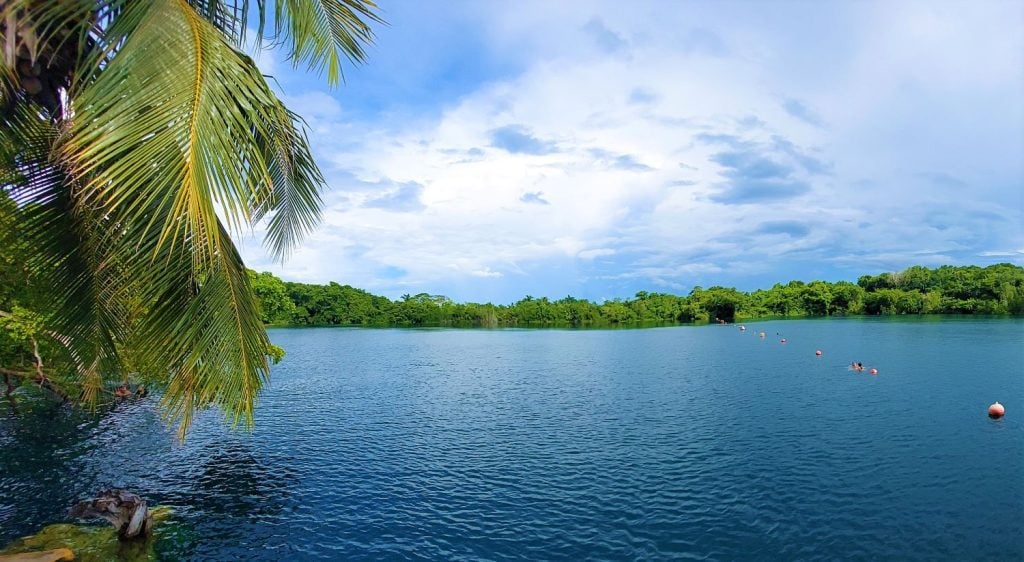
Cenote Azul
Submitted by Brodi Cole of Our Offbeat Life
While most people visit Bacalar for the lovely turquoise colors of its lagoon, Cenote Azul Bacalar is another fun place to visit. Don’t confuse this with Cenote Azul in Playa del Carmen, though!
There is a small mangrove river flowing between the Bacalar lagoon and Cenote Azul Bacalar. However, the cenote is much deeper than the lagoon so it’s a far darker shade of blue. Visitors pay 50 pesos to either swim or simply sit in the on-site restaurant and enjoy the view.
Life jackets are available to rent for less confident swimmers. And, there is a wooden swing hung from a tree overhanging the water that swimmers can enjoy. It also makes for excellent Instagram pics. In addition, there are bathrooms available, which also act as changing rooms for visitors who don’t want to get their car seats wet.
The cenote is so big that it would be too difficult for most people to swim across. (Note from Kate: My friends tried. It wasn’t pretty.) Instead, the adventurous souls who leave the cenote’s edge can cross it using the buoys running through the middle. It’s a fun challenge!
Finish off your day with a stop at one of the best restaurants in Bacalar.
Address: Carr. Federal 307, Chetumal-Cancun Km 34, 77930 Bacalar, Q.R., Mexico
How to Get There: Drive or take a taxi from central Bacalar.
Hours: 10:00 AM-6:00 PM
Admission: 25 pesos ($1 USD)
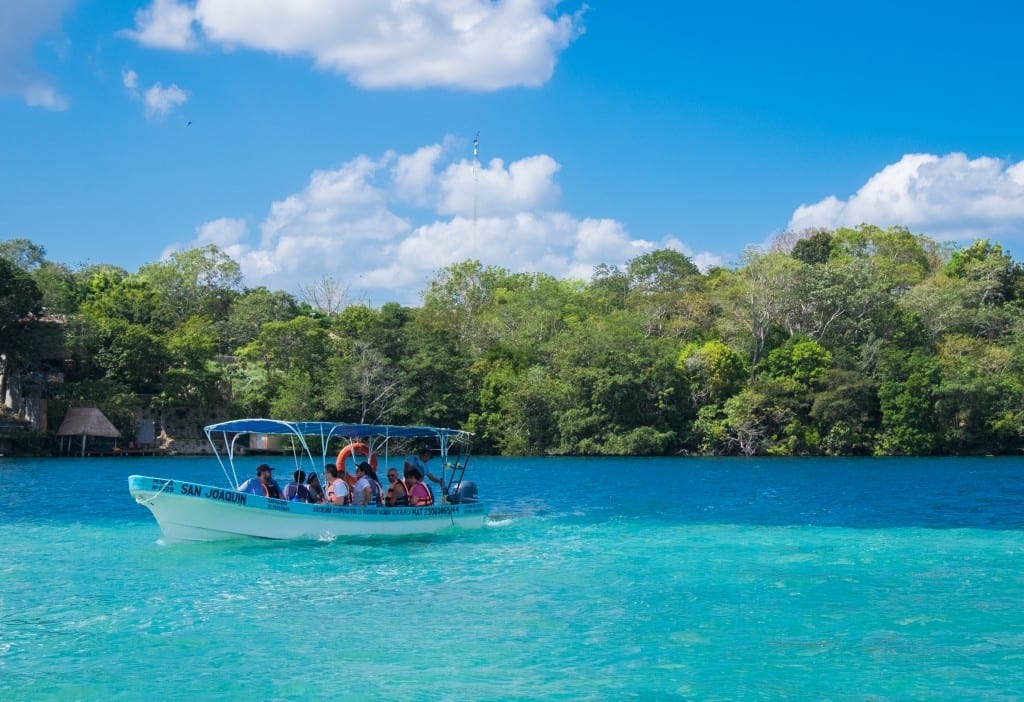
Cenote Negro
Submitted by Allison Green of Eternal Arrival
One of the most unique cenotes in Mexico is Cenote Negro, which you can find in the town of Bacalar right along the lagoon. If you’re staying in the town of Bacalar, it’s hard to miss Cenote Negro as it’s right in town!
Cenote Negro is unique in that it’s one of the deeper cenotes in Mexico, at 90 meters (nearly 250 feet) deep! It gets its name (which means “Black Cenote” in Spanish) for the deep, dark color of the water that results from its impressive depth.
Note that you are not able to swim in this cenote, though you can visit by boat or paddleboard. There are no amenities, as the cenote is undeveloped and is just part of the lake. However, it is still possible and worthwhile to visit!
The most popular way most people visit Cenote Negro is on one of the boat tours of the lagoon. These tours typically include Cenote Negro, the Pirates’ Channel, and a visit to Bacalar’s unique stromatolite formations, and they depart from Bacalar town. You can book a boat tour online and they typically cost around $45 USD and last about 4 hours.
Another fun way to visit Cenote Negro is by stand up paddle board! I first experienced Cenote Negro on a sunrise standup paddleboard tour, and it was an incredible way to see the beautiful contrast of colors between the lagoon and the cenote. A sunrise paddleboard tour costs around $25, lasts about 3 hours.
Address: Av 1 27, Magisterial, 77933 Bacalar, Q.R., Mexico
How to Get There: Best seen on a day boat tour around Bacalar. This is a good one.
Hours: Open 24/7
Admission: None
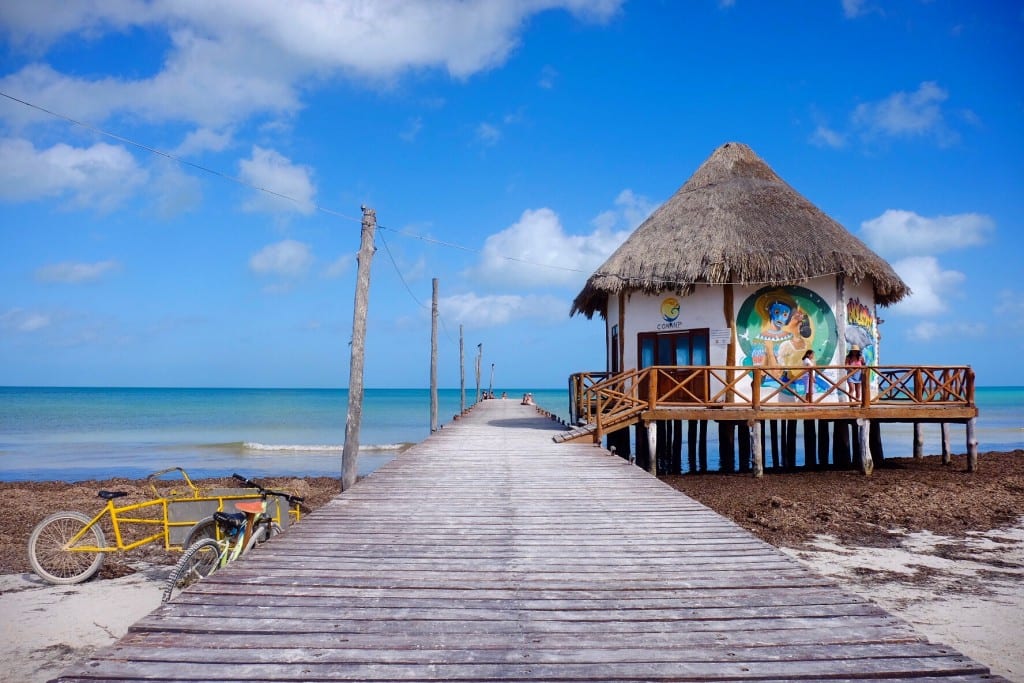
Cenotes Near Isla Holbox
Isla Holbox (pronounced HOLE-bosh) is one of my favorite beach destinations in Mexico. This tiny island is a world away from the high-rise hotels of Cancun and party crowds of Tulum.
Isla Holbox has one cenote — Yalahau Cenote — which is technically on the mainland and a popular spot on Isla Holbox boat trips.
Come to Holbox to kick back and relax, and you’ll have a hard time pulling yourself away when it’s time to leave! I recommend visiting soon, as the island seems to become more and more developed each year.
Read More: The Ultimate Guide to Isla Holbox, Mexico
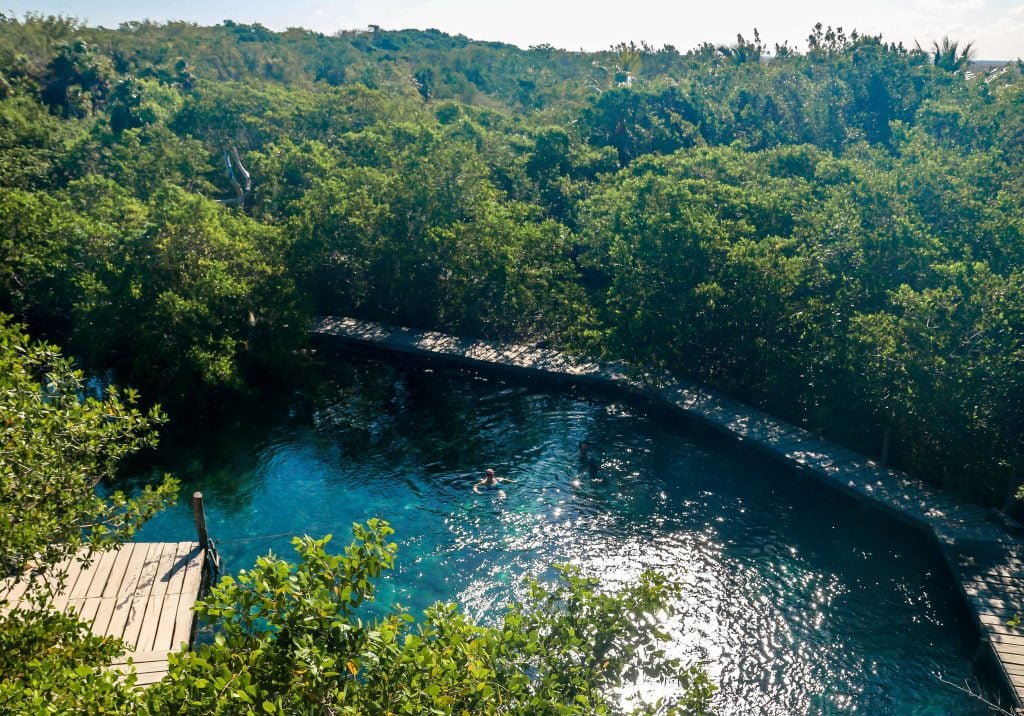
Yalahau Cenote
Submitted by Mary Gabbett of Green Global Travel
The once-sleepy fishing village of Isla Holbox has emerged over the last decade as an increasingly popular ecotourism destination. Located about two hours from Cancún on the north coast of the Yucatán Peninsula, the tiny island is a nature-lover’s paradise with loads of excellent outdoor attractions nearby.
There are no cars on the island, but golf cart taxis can take you from Isla Holbox hotels to the area from which island-hopping boat tours depart.
Part of the 154,052-acre Yum Balam Nature Reserve (which protects the world’s largest whale shark sanctuary), the Yalahau Cenote is a common stop for tours to Isla Pájaros (a.k.a. Bird Island). Located about 30 minutes from Isla Holbox by boat, the cenote features a breathtaking blue pool fed by a freshwater spring, and has a rich history of tales to tell.
Our native guide explained that this tiny island was once home to an ancient Mayan trading port, until a Mayan king decided to transform it into his own private paradise. Local legends suggest that he used his wealth to build lushly landscaped gardens with ornate fountains and a royal pool decorated with Jade stones. The setting was so beautiful, many people believed that the spring was a fountain of youth.
Sadly, invading Spanish conquistadors destroyed it all upon their arrival in the Yucatan, keeping the gems for themselves and using the stones to build one of the first Christian churches in Latin America (in nearby Boca Iglesias).
The island later became a refuge for the Spanish pirate Miguel Molas, who made Yalahau his home for nearly four decades. Originally employed by the Spanish government, Molas realized that he could make more money by guiding smugglers through the area’s waters, and eventually he got into a fight with the pirate Jean Lafitte’s brother, Pierre, in nearby Isla Mujeres.
Today, this Holbox cenote is a peaceful, pristine place that’s simply perfect for cooling off during a hot day. There’s a nominal 50 pesos entry fee, but it’s usually included as part of larger island-hopping tours. If you can, try to visit in the morning before the crowds arrive, and you may have the dock and picnic area all to yourself!
Address: On the coastline, west of Chiquilá, Quintana Roo, Mexico
How to Get There: Book a boat tour around Isla Holbox that visits many of the island’s hard-to-reach attractions.
Hours: Daily, 8:30 PM-5:00 PM
Admission: 50 pesos ($2.50 USD)
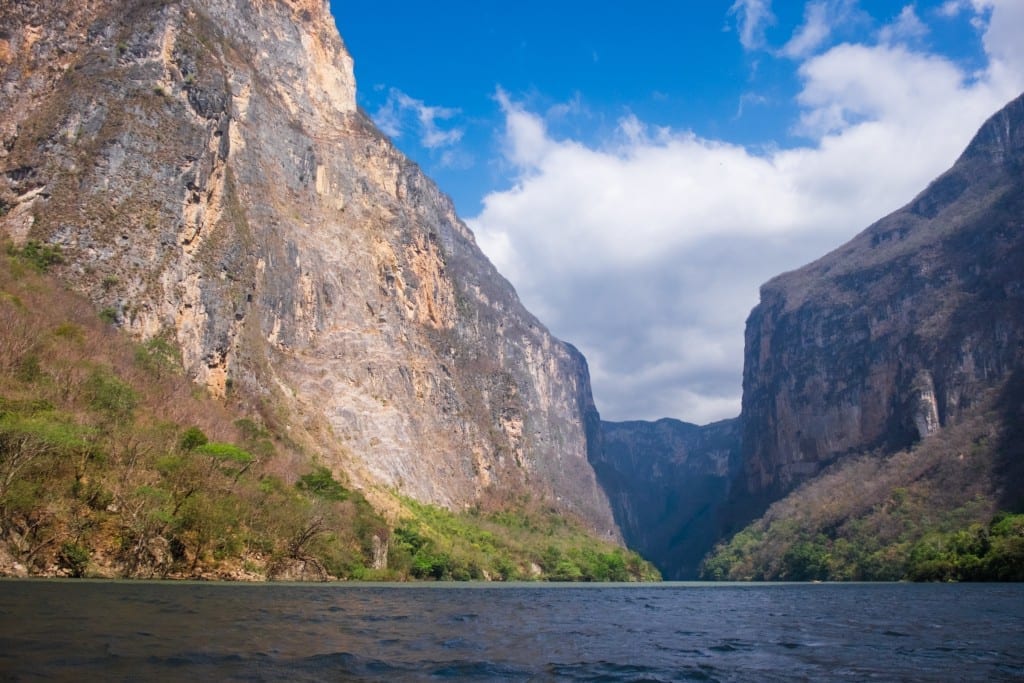
Cenotes in Chiapas
Did you know there are cenotes in Chiapas?! I honestly didn’t know until recently! The region of Chiapas is in the south of Mexico, wild and exploding with natural wonders.
The two biggest tourist draws in Chiapas are the ruins of Palenque and the beautiful city of San Cristóbal de las Casas, and both make good bases for exploring the region. I personally enjoyed Sumidero Canyon, an incredible natural wonder near San Cristóbal.
Chiapas is much less developed for international tourism than the Yucatán, though it’s very popular with Mexican travelers. I wouldn’t recommend road tripping around Chiapas for a first-time Mexico visitor, but if you’ve been here before and love it, it’s a great next adventure.
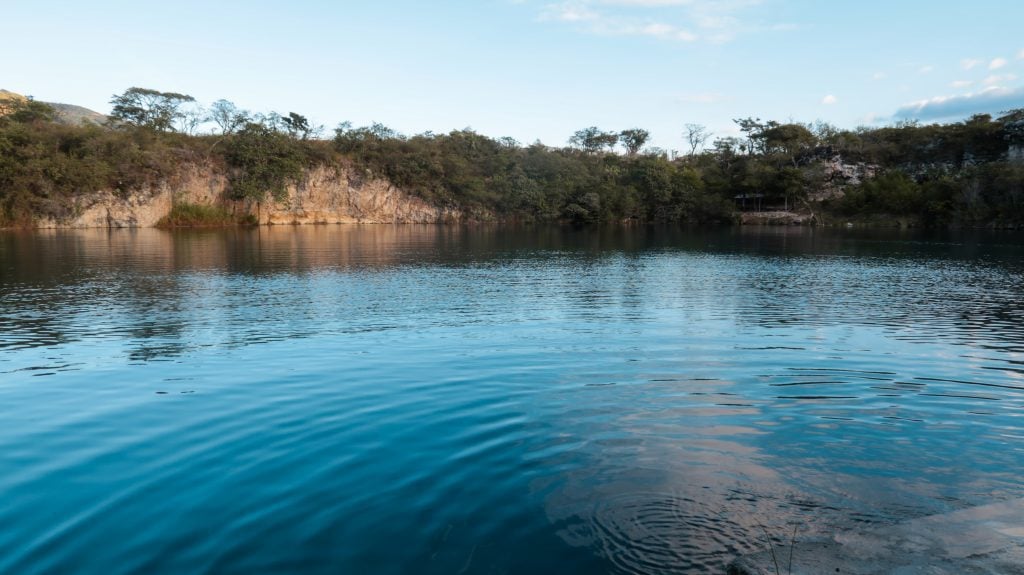
Cenote Chukumaltik
Submitted by Jodie Dewberry of Alajode
Unlike many of Mexico’s cenotes, Chukumaltik doesn’t lie hidden beneath a wall of rock. Instead, it is wide open like a small lake and expands across a vast area, making it just as impressive as it is unique. On a sunny day, you can see the petrified trees that lie on the bottom, nearly 70 meters below the surface.
Chukumaltik is located a short drive from Comitán, a town that makes a great base for any Chiapas tour (or part of one). Since Chiapas is so spread out and infrastructure is lacking in most areas, by far the best way to get around is by renting a car. Whether you fly directly into Comitán or take a road trip from elsewhere in Mexico, you’ll only be able to visit the coolest spots with your own wheels.
The drive from Comitán to Chukumaltik takes around 45 minutes — watch out for the many, many speed bumps! — and the trip can be combined with visits to many of the nearby waterfalls.
Don’t be surprised if you drive straight past the entrance to Chukumaltik at first. To get there, you need to walk through a gate and take a very short hike through the greenery. As you turn the final corner, the vast cenote will appear. There is a small area to leave belongings, but there are no toilets or changing facilities.
Address: On an unmarked road in Comitán, Chiapas, Mexico
How to Get There: Driving is best. 45 minute drive from Comitán.
Hours: Daily, early morning until 5:00 PM
Admission: 100 pesos ($5 USD)
Planning a Trip to Mexico:
- Solo Female Travel in Mexico: Is it Safe?
- What NOT to Do in Mexico
- Two Weeks in Mexico: The BEST Yucatan Road Trip Itinerary
Places to Visit in the Yucatán and Mexico’s Caribbean Coast:
- Things to Do in Bacalar, Mexico, The Lake of Seven Colors
- Guide to Isla Holbox, Mexico’s Most Magical Island
- 50+ Best Cenotes in Mexico
Places to Visit in Inland Mexico:
- The Absolute Best Things to Do in Oaxaca, Mexico
- Best Mexico City Neighborhoods to Stay In
- 35+ Best Things to Do in Guanajuato, Mexico
- How to Visit Sumidero Canyon from San Cristobal de las Casas
Places to Visit on Mexico’s Pacific Coast:
- 24 Fabulous Things to Do in Sayulita, Mexico
- Guide to Bucerías, Mexico, an alternative to Puerto Vallarta
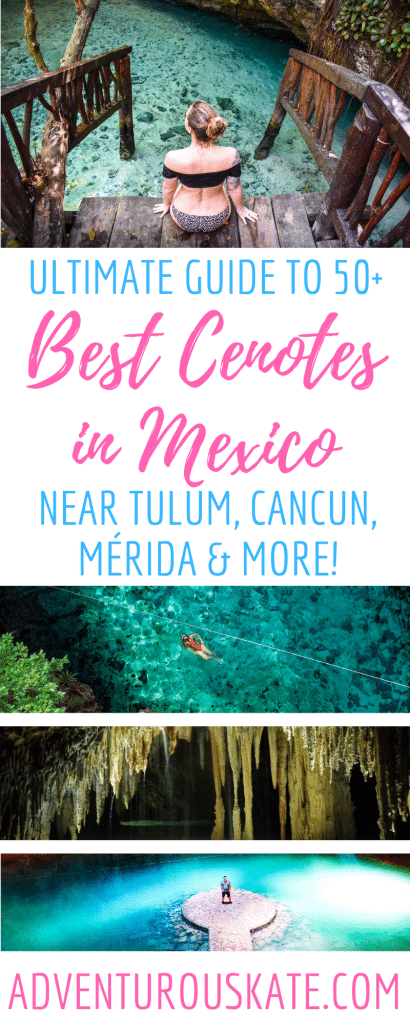
Have you been to Mexico? What’s your favorite cenote?